- Phân tích
- Tin tức và các công cụ
- Tin tức thị trường
Tin tức thì trường
- EUR/USD consolidates the biggest daily loss in a week after bouncing off short-term key supports.
- 50-SMA, five-week-old horizontal area appear to be strong supports.
- Bulls need validation from 200-SMA to retake control.
EUR/USD holds onto the corrective pullback from the 50-SMA around 1.0525 during Friday’s Asian session.
In doing so, the major currency pair also justifies Wednesday’s rebound from the key horizontal support zone comprising multiple levels marked since mid-May.
Given the sluggish MACD signals and steady RSI, coupled with the quote’s ability to recover from important supports, the EUR/USD pair is likely to run towards the 200-SMA hurdle surrounding 1.0585.
However, the quote’s upside past 1.0585 will need to cross the weekly peak of 1.0600 and early June’s low near 1.0630 to give control to buyers.
Meanwhile, the 50-SMA and aforementioned support area, respectively near 1.0495 and 1.0470-60, could challenge the EUR/USD bears.
During the pair’s weakness past 1.0460, multiple troughs near 1.0400 could test the bears before directing them to the yearly low of 1.0349.
To sum up, EUR/USD signals corrective pullback but the buyers need validation from 200-SMA.
EUR/USD: Four-hour chart
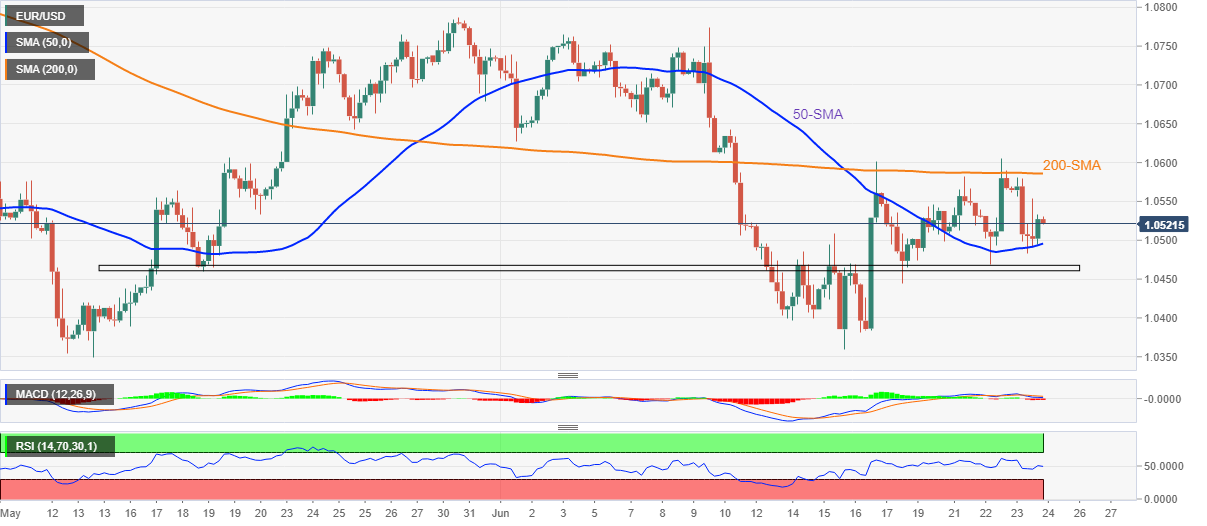
Trend: Further recovery expected
- Oil prices have failed to surpass the critical hurdle of $107.23 amid escalating recession fears.
- Higher interest rates by the global central banks have raised the oil demand worries.
- The EIA weekly oil inventory report is postponed to next week, as reported by Bloomberg.
West Texas Intermediate (WTI), futures on NYMEX, is portraying a mute performance in the Asian session after sensing significant offers while overstepping the critical hurdle of $107.23. The black gold has remained in the grip of bears this week after the market participants underpinned the demand worries over the supply constraints.
No doubt, the sanctions on Russia after it invaded Ukraine have settled a tight oil market for the global economy for a prolonged period. However, the recently grown recession fears after the global central banks started running towards policy tightening measures to fix the inflation mess are guiding the oil prices now. In June, most of the Western central banks announced a rate hike of 50 basis points (bps). The mighty Federal Reserve (Fed) went beyond the expectations and announced a 75 bps rate hike.
The announcement of higher interest rates has eventually slashed the extent of economic activities whose effect is clearly visible on the US Purchase Managers Index (PMI) numbers. The Manufacturing PMI has landed at 52.4 much lower than forecasts and the prior print of 56 and 57 respectively. Also, the Services PMI has slipped sharply to 51.6 from the consensus of 53.5 and the prior print of 53.4. Lower economic activities will result in lower demand for oil and henceforth lower oil prices.
Volatility has been accelerated in the oil counter amid a surprise delay in the weekly U.S. oil inventory report, which Bloomberg said was held up by “power issues” and unlikely to see publication until next week.
- USD/CHF stays defensive after refreshing multi-day low, bullish candlestick formation teases corrective pullback.
- Risk-aversion, lack of data could underpin the recovery moves.
- Second-tier US statistics, qualitative catalysts to direct intraday traders.
USD/CHF extends late Thursday’s rebound from a three-week low towards piercing the 0.9600 threshold, around 0.9610 during Friday’s initial Asian session.
In doing so, the Swiss currency pair not only justifies the risk-off mood but also takes clues from the technical analysis, as well as the lack of major data/events, to consolidate the weekly losses.
Federal Reserve (Fed) Chairman Jerome Powell cited inflation and recession woes as the challenges to ensure a smooth landing, despite expecting firmer growth this year, during his second round of Testimony. The central banker’s concern for recession joined downbeat US data to favor the risk-off mood.
On the same line were downbeat US PMIs as S&P Global Services PMI for the US slumped to 51.6 in June from 53.4 prior, not to forget missing the 53.5 forecasts. Further, the Manufacturing PMI not only missed the market expectation of 56 by a wide margin in June, to 52.4 versus 57.00 previous readings, but also slumped to a nearly two-year low.
Against this backdrop, the S&P 500 Futures drop 0.30% while the US 10-year Treasury yields remain unchanged at around 3.09% after dropping to a fortnight low the previous day.
Moving on, a light calendar may test the USD/CHF pair traders but risk catalysts and the second-tier US data for housing and activities may offer intermediate moves.
Technical analysis
Bullish candlestick formation joins the USD/CHF pair’s rebound from the 50-day EMA, around 0.9560 at the latest, to keep buyers hopeful. However, the 21-day EMA near 0.9715 guards the short-term advances of the pair.
- The GBP/JPY stays positive in the week, gaining 0.42%.
- A fragile sentiment triggered by recession fears might send the pair tumbling and erase the pound’s weekly gains.
- GBP/JPY Price Analysis: Upward biased in the medium term, but the short term is consolidating and might fall if sellers step in and could dive towards 164.00.
The GBP/JPY barely advances during the Asian session, up 0.02%. However, on Thursday, the GBP/JPY plunged from around 167.00 to 164.65, though it staged a comeback and lost only 160 pips. At 165.41, the GBP/JPY, albeit above the 20-day exponential moving average (EMA), remains under selling pressure amidst a mixed market sentiment.
The reflection of the above-mentioned is that Asian equity futures are rising while US indices are falling. Fears of a US and global recession increased after Thursday’s worldwide S&P Global PMIs, although in expansionary territory, dipped. Investors sounded the alarms and flew towards safe-haven assets, like the Japanese yen in the FX market.
Read also: Forex Today: Run to safety only beginning
GBP/JPY Price Analysis: Technical outlook
Daily chart
From a technical perspective, the GBP/JPY is upward biased, as the exchange rate failed to break below the 20-EMA. Also, the Relative Strength Index (RSI) dwells in bullish territory, meaning there’s some buying pressure on the pair, but solid resistance lies ahead.
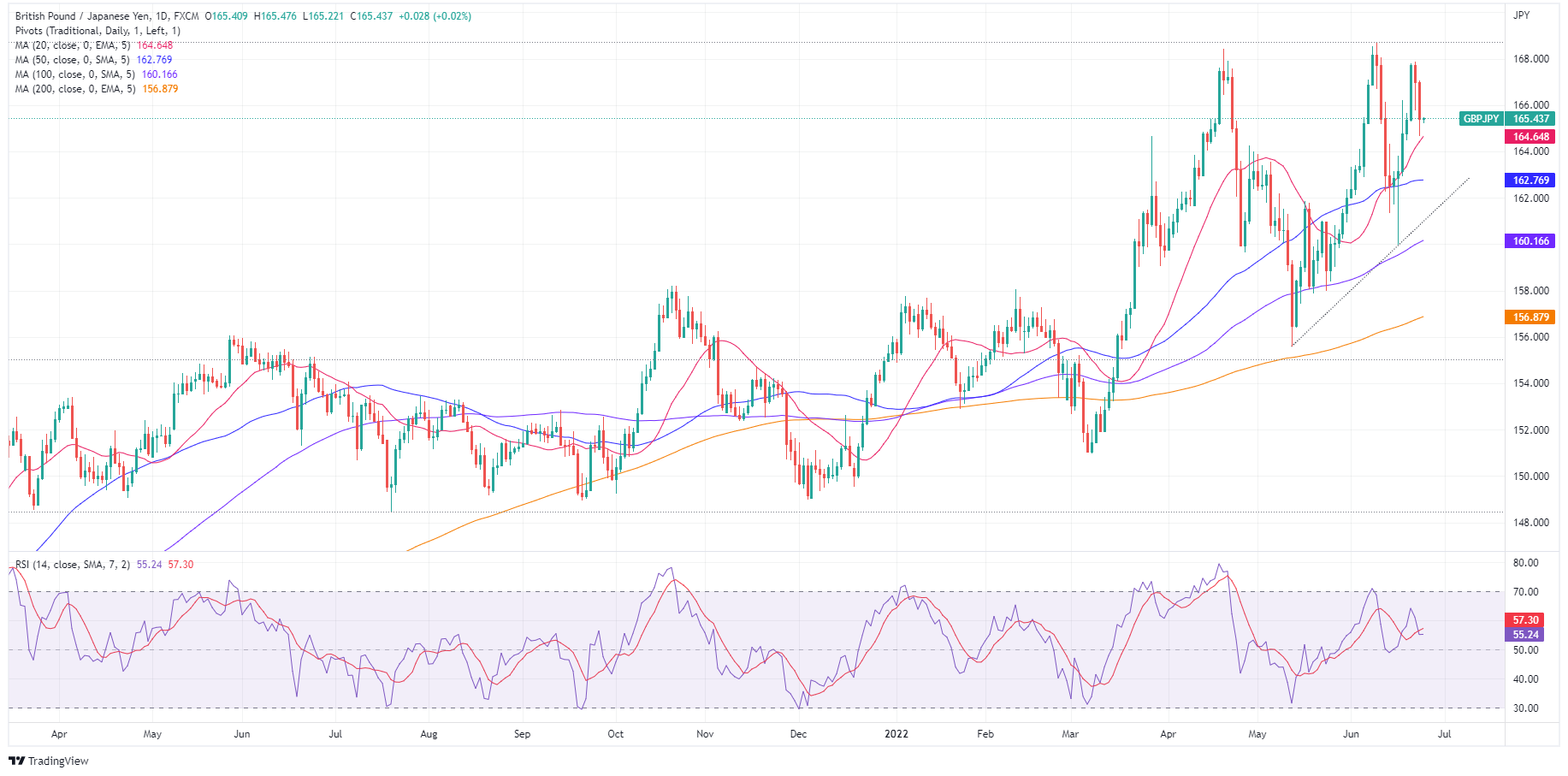
4-hour chart
In the near-term, GBP/JPY price action shows consolidation lying ahead; though successive series of a Lower high (LH) and a Lowe low (LL), and with the pair meandering around the 50 and 100-4H-EMAs, a breach of them would open the door for a possible fall towards 164.47.
Therefore, the GBP/JPY first support would be 100-4h-EMA at 164.95. A breach of the latter exposes the 50-EMA at 164.64, followed by the swing low mentioned above at 164.47. If the pair clears the latter, the GBP/JPY might tumble to the 200-4H-EMA at 162.38.

- Silver portrays corrective pullback after refreshing eight-day low.
- Clear break of six-week-old ascending trend line joins impending bear cross on MACD to favor sellers.
- 10-DMA, three-week-old descending trend line adds to the upside filters.
Silver (XAG/USD) regains $21.00 amid a corrective pullback near the weekly low. Even so, the bright metal keeps the downside break of the previous key support line during Friday’s Asian session.
In addition to the support-turned-resistance from mid-May, around $21.10, a looming bear cross on the MACD and downbeat RSI also hint at the quote’s further downside.
Even if the XAG/USD manages to cross the $21.10 hurdle, the 10-DMA and a downward sloping trend line from May 06 could challenge the buyers around $21.40 and $21.75.
It’s worth noting, however, that the metal’s run-up beyond $21.75 enables it to rally towards the monthly high of $22.51.
On the flip side, the monthly low near $20.90 appears to be the immediate support for the silver traders to watch ahead of targeting the yearly bottom surrounding $20.45.
Following that, the $20.00 psychological manget could entertain XAG/USD bears before directing them to the 61.8% Fibonacci Expansion (FE) of the metal’s moves during late April to early June, around $19.40.
Overall, the metal’s rebound appears less convincing until the prices stay below $21.75.
Silver: Daily chart
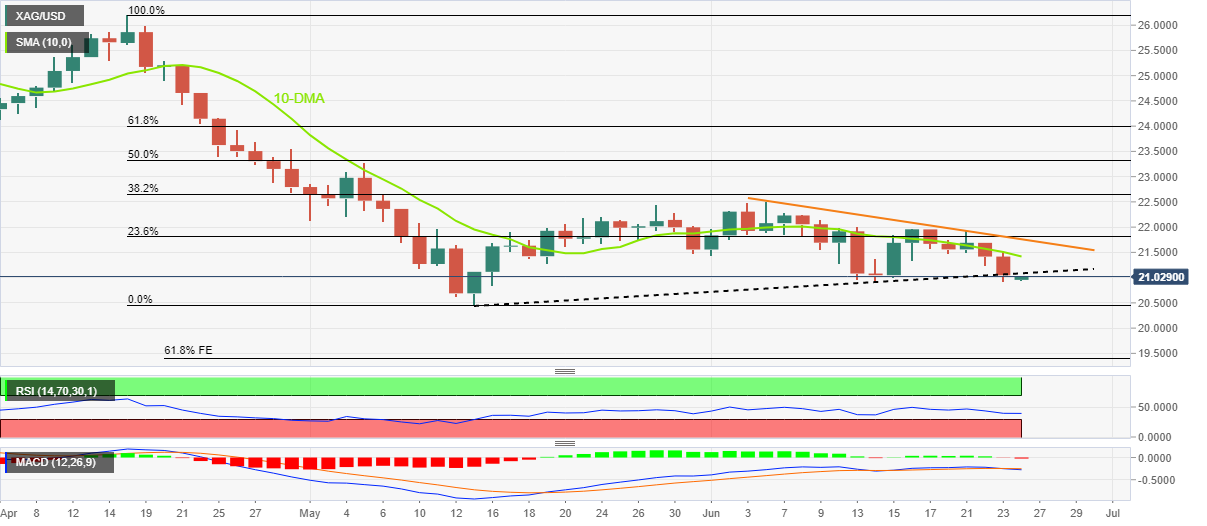
Trend: Further downside expected
- EUR/JPY is balancing around 142.00 as investors are awaiting the release of the Japan Inflation.
- The downbeat eurozone PMI has weakened the shared currency bulls.
- Despite the prolonged ultra-loose monetary policy, the BOJ has failed to spurt the growth forecasts.
The EUR/JPY pair gave a downside break of the consolidation formed in a minor range of 141.93-142.07 in the early Tokyo session, however, a follow-back reversal has turned the asset sideways again. The asset remained in the grip of bears on Thursday after the IHS Markit reported a downbeat euro zone Purchase Managers Index (PMI) figures.
The IHS Markit reported the Composite PMI at 51.9, significantly lower than the estimates of 54 and the prior print of 54.8. Separate scrutiny of Manufacturing and Services PMI also displayed a vulnerable performance. The Manufacturing PMI landed at 52, much lower than the estimates and the prior print of 53.9 and 54.6 respectively. Also, the Services PMI released extremely lower at 52.8 than the consensus of 55.5 and the former figure of 56.1.
On the Tokyo front, investors are worried over lower demand prospects. The economy has yet not achieved its pre-pandemic growth levels. And now, an expected divergence in the plain vanilla and core Consumer Price Index (CPI) figures is creating headwinds for the economy. The annual CPI is seen at 2.9% much higher than the inflation target of 2% and the prior print of 2.5%. While the core CPI may slip vigorously to 0.4% from the prior print of 0.8%. A divergence in the composite and bifurcated CPI indicates that the price rise is significantly guided by higher fossil fuel and food prices. This means that despite the prolonged ultra-loose monetary policy, the Bank of Japan (BOJ) has failed to spurt the aggregated demand.
- AUD/USD picks up bids to refresh intraday high, snaps two-day downtrend around eight-day low.
- Markets consolidate recent losses amid a lack of major data/events.
- Fed Chair Powell’s testimony, US PMIs raised concerns over economic slowdown and drowned the pair.
- RBA’s Lowe may help buyers on repeating the latest hawkish bias.
AUD/USD pares recent losses around 0.6900 as recession fears stall, for the time being, amid a quiet Asian session on Friday. Also keeping the Aussie buyers hopeful is the scheduled speech from Reserve Bank of Australia (RBA) Governor Philip Lowe, around 11:30 GMT.
Fears of economic slowdown triggered the market’s rush to risk safety the previous day, which in turn weighed on the AUD/USD prices due to its risk-barometer status. In doing so, the Aussie pair couldn’t cheer upbeat PMIs at home, nor the softer US activity numbers, as the US dollar benefited from the risk-aversion wave.
That said, the preliminary readings of Australia’s S&P Global PMIs for June came in mixed as the Manufacturing and Services PMIs rose past market forecasts and priors but the Composite PMI eased below the previous readouts. The Manufacturing PMI rose to 55.8 versus 54.7 expected and 55.7 prior whereas the S&P Global Services PMI rose past 49.1 market consensus to 52.6, versus 53.2 previous readings. It should be noted that the Composite PMI eased below 52.9 to 52.6 in June.
On the other hand, S&P Global Services PMI for the US slumped to 51.6 in June from 53.4 prior, not to forget missing the 53.5 forecasts. Further, the Manufacturing PMI not only missed the market expectation of 56 by a wide margin in June, to 52.4 versus 57.00 previous readings, but also slumped to a nearly two-year low.
Elsewhere, Federal Reserve (Fed) Chairman Jerome Powell cited inflation and recession woes as the challenges to ensure a smooth landing, despite expecting firmer growth this year, during his second round of Testimony. The central banker’s concern for recession joined downbeat US data to favor the risk-off mood.
While portraying the mood, the S&P 500 Futures drop 0.30% while the US 10-year Treasury yields remain unchanged at around 3.09% after dropping to a fortnight low the previous day.
Moving on, RBA’s Lowe is likely to reiterate his hawkish bias, especially after the recently upbeat Aussie PMIs, which in turn could favor the AUD/USD bulls. However, any mentioning of economic fears could join the latest downbeat performance of iron ore, Australia’s key export item, to recall the bears.
Technical analysis
A six-week-old support line around 0.6855-60 puts a floor under the AUD/USD downside. Recovery moves, however, need validation from a downward sloping resistance line from June 07, at 0.6930 by the press time.
- USD/CAD suffers altitude sickness after rising for the last two days.
- Oil prices grind near six-week low amid recession fears, China underpins corrective pullback.
- Fed’s Powell appears thoughtful of growth and inflation as he cites challenges for smooth landing.
- Downbeat US PMIs magnified the risk of economic slowdown, second-tier data eyed.
USD/CAD flirts with the 1.3000 psychological magnet as bulls take a breather during Friday’s initial Asian session.
The Loonie pair managed to cheer softer oil prices and the market’s rush towards risk safety, amid economic fears, during the last two days. However, the recent pause in the WTI’s further downside, as well as a lack of market activity, appears to have underpinned the quote’s inaction.
Market sentiment remained sour in the last few days as traders fear recession as the major central banks rush for higher rates. On Thursday, Federal Reserve (Fed) Chairman Jerome Powell also cited the inflation and recession woes as the challenges to ensure a smooth landing, despite expecting firmer growth this year.
Elsewhere, S&P Global Services PMI for the US slumped to 51.6 in June from 53.4 prior, not to forget missing the 53.5 forecasts. Further, the Manufacturing PMI missed the market expectation of 56 by a wide margin in June, to 52.4 versus 57.00 previous readings.
Despite the market’s pessimism, the Wall Street benchmarks closed positively due to the downbeat Treasury yields. However, the US dollar regained its strength and exert downside pressure on the commodities and the Antipodeans.
It should be noted that the WTI crude oil, Canada’s main export item, forms a higher low pattern while recently defending $104.00, after refreshing the monthly low on Wednesday. That said, the black gold’s earlier losses could be linked to the recession fears and hopes of federal gas tax relief from the US while chatters that China’s traffic light data suggests improvement in energy demand seems to have probed the oil bears of late.
To sum up, USD/CAD bulls appear to have run out of steam and hence today’s second-tier US data, as well as chatters surrounding inflation/recession, becomes necessary for the pair to extend the run-up.
Technical analysis
A successful rebound from the 10-SMA, around 1.2955 by the press time, directs USD/CAD towards the double tops marked around 1.3080.
- USD/JPY is juggling marginally below 135.00 as investors await Japan's Inflation.
- A divergence is expected in the plain-vanilla CPI and Core CPI figures.
- The DXY is trading lackluster as the focus shifts to the US Durable Goods Orders.
The USD/JPY pair is displaying a lackluster performance in the early Asian session after sensing a decent rebound from a low of 134.27. The asset is oscillating in a 9-pips range near the critical hurdle of 135.00. A range-bound movement is expected to sustain for a minor period only as the Statistics Bureau of Japan is going to release the Consumer Price Index (CPI) at 11:30 GMT.
A preliminary estimate for the annual Japan inflation figure is 2.9%, higher than the prior print of 2.5%. If the core CPI that excludes food and oil prices is considered, a slippage to 0.4% is expected from the prior print of 0.8%. The FX domain is aware of the fact that the ongoing war between Russia and Ukraine and supply chain bottlenecks have resulted in soaring fossil fuels and food prices. The composite CPI figure is expected to extend further while the core CPI is seeing a slippage, which indicates that the composite figure is majorly being guided by the oil and food prices.
The Japanese economy is still facing the headwinds of lower aggregate demand. A higher spending situation on costly oil and food prices has actually reduced the demand for other durable and non-durable products. The huge divergence in plain vanilla CPI and core CPI is responsible for the dovish commentary from Bank of Japan (BOJ) policymakers in the June monetary policy meeting minutes released this week.
On the dollar front, the US dollar index (DXY) has turned sideways as investors are awaiting the release of the US Durable Goods, which are due on Monday. An improvement is expected in the economic data to 0.6% from the former figure of 0.5%.
- GBP/USD dribbles inside a bullish chart pattern after two-day inaction.
- Firmer RSI, horizontal support add strength to the bullish bias.
- 100-SMA acts as an extra filter to the north, bears could aim for yearly low on breaking 1.2160.
GBP/USD treads water around 1.2260 during Friday’s Asian morning, following the last two days’ dormancy inside a falling triangle bullish formation.
Adding strength to the Cable pair’s upside bias is the firmer RSI and a six-week-old horizontal support area that also comprises the stated triangle’s lower line.
That said, the GBP/USD buyers need validation from 1.2285 to trigger the upside momentum. Even so, the 100-SMA could test the bulls around 1.2345.
In a case where the quote rises past 1.2345, the previous weekly top surrounding 1.2405 and multiple troughs marked during late May and early June, around 1.2470 could challenge the pair’s further advances.
On the contrary, a downside break of the 1.2160 could quickly fetch the GBP/USD prices towards the 23.6% Fibonacci retracement level of the May-June downside, near 1.2100.
The bearish bias, if persist past 1.2100, won’t hesitate to challenge the yearly low surrounding 1.1933. During the fall, the 1.2000 psychological magnet could offer an intermediate halt.
Overall, GBP/USD is up for consolidating recent losses ahead of the UK Retail Sales for May.
GBP/USD: Four-hour chart
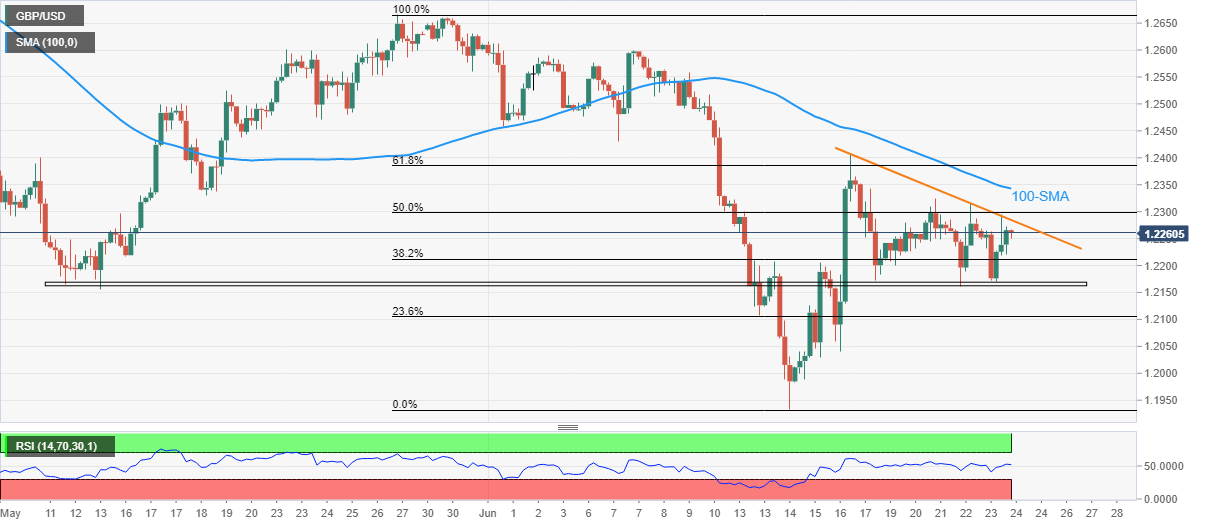
Trend: Further upside expected
- AUD/JPY plummeted by 270 pips in two days and is losing in the week 0.54%.
- Worldwide S&P Global PMIs spurred global recession fears, as all missed estimations.
- AUD/JPY Price Analysis: It is still upward biased, but the price is closing to the bottom of a rising wedge which, once broken, may send the pair towards 85.00.
The AUD/JPY plunged on Thursday for the second straight day, diving 1.39%, reaching on its way south a daily low near 92.64, though on Friday, as the Asian session began, AUD/JPY buyers reclaimed the 93.00 mark. At the time of writing, the AUD/JPY is trading at 93.10.
The market sentiment seesawed throughout Thursday’s session. Meanwhile, Asian equity futures follows Thursday’s Wall Street mood, climbing between 0.05% and 1%. Dismal S&P Global PMIs reported from the Eurozone, the UK, and the US, threaten to derail growth, with readings accelerating towards the 50 midline, which, broken to the downside, depicts that the economy is entering a contraction phase.
AUD/JPY Price Analysis: Technical outlook
Daily chart
From a technical perspective, the AUD/JPY remains upward biased but under selling pressure. Price action in the last couple of days witnessed a 270 pip fall, from around weekly highs near 95.28, towards 92.64, June 23 lows.
It’s worth noting that AUD/JPY’s price is closing towards the rising wedge bottom trendline, meaning a break below would send the cross towards 85.00. However, on its way south, the AUD/JPY will need to breach crucial supports on its way south.
Therefore, if the above scenario plays out, the AUD/JPY first support would be the 50-day exponential moving average (EMA) at 92.44. Break below would send the cross aiming towards the 100-EMA at 89.83, followed by a fall to the 200-EMA at 86.13.
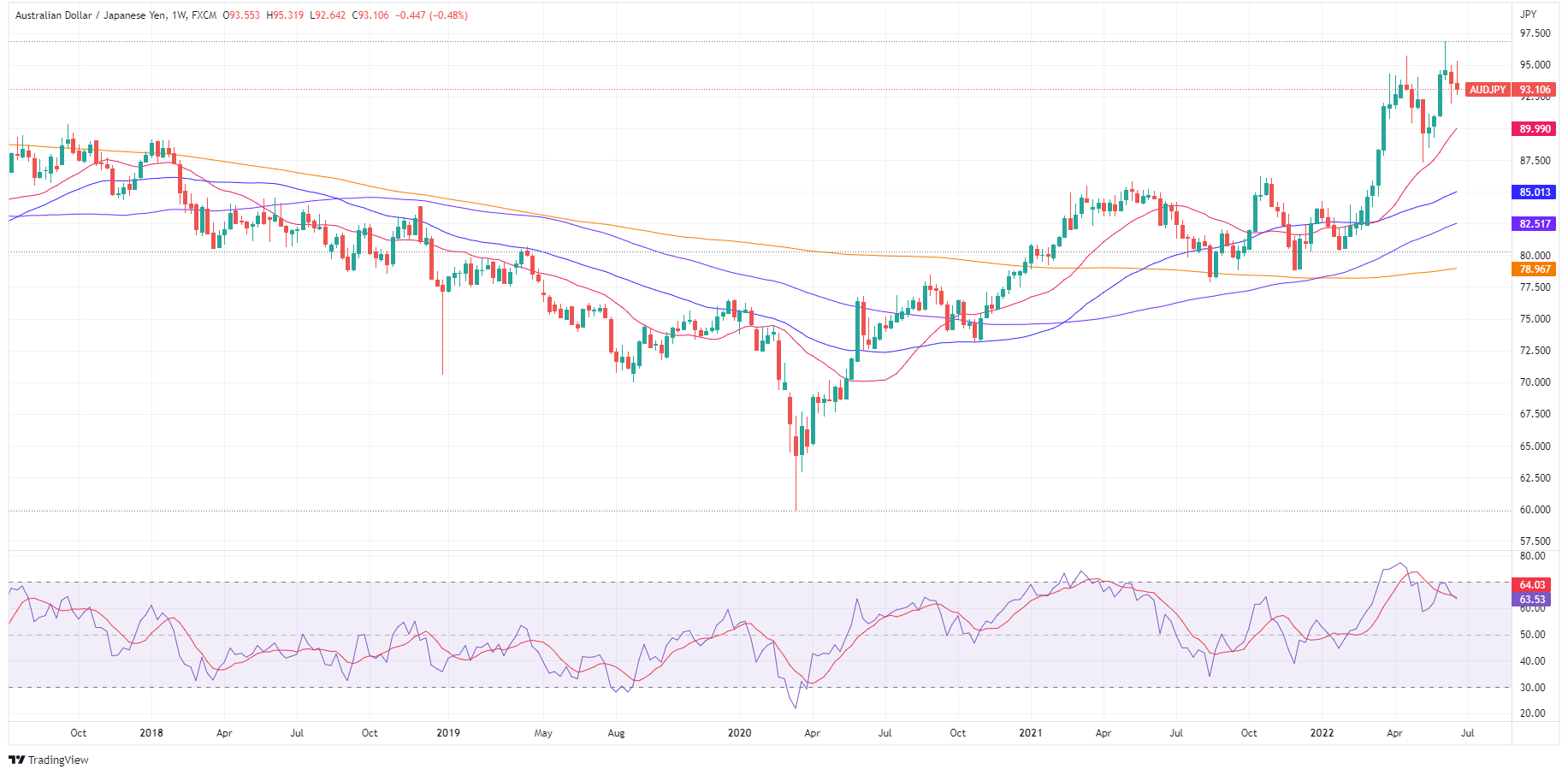
AUD/JPY Key Technical Levels
- EUR/USD has turned sideways after a vulnerable Eurozone/US PMI performance.
- Investors are keeping an eye on the release of the US Durable Goods Orders for further guidance.
- The asset has displayed a balanced market profile this week, which may bring an imbalance action further.
The EUR/USD pair has turned sideways to 1.0520 after facing barricades around 1.0550 in the New York session. In this entire week, the asset has displayed topsy-turvy moves in a range of 1.0444-1.0606 despite the availability of potential triggers, which were able to provide a decisive move to the asset. On Thursday, the major was expected to deliver an upside break of the consolidation range, however, the downbeat eurozone Purchase Managers Index (PMI) data weighed pressure on the shares currency bulls near the round-level resistance of 1.0600.
The IHS Markit reported the Composite PMI at 51.9, much lower than the estimates of 54 and the prior print of 54.8. Separate scrutiny of Manufacturing and Services PMI also displayed a vulnerable performance. The Manufacturing PMI landed at 52, significantly lower than the estimates and the prior print of 53.9 and 54.6 respectively. Also, the Services PMI released extremely lower at 52.8 than the consensus of 55.5 and the former figure of 56.1.
Meanwhile, the US dollar index (DXY) is following the footprints of the EUR/USD pair and has turned rangebound around 104.41 on lower-than-expected PMI data. The Manufacturing and Services PMI have landed at 52.4 and 51.6 respectively, however, their forecasts and prior prints were significantly higher.
Going forward, investors will keep an eye on the release of the US Durable Goods Orders, which are due on Monday. As per the market consensus, the economic data may improve to 0.6% from the prior print of 0.5%. This indicates a higher demand for those goods, which will last for at least three years.
- Gold is on the back foot as the US dollar and risk step up a gear.
- The price is trading within a phase of consolidation between $1,810 and $1,875.
At $1,822, the price of gold has taken a step backwards despite a soft dollar bias in the markets. XAU/USD is down some 0.8% and has fallen from a high of $1,846.12 to a low of $1,822.60 so far. The US dollar bulls put in a potentially last-ditch effort to defend against a full-on break out to the downside in the latter part of the day on wall Street, but they are not out of the woods yet and are climbing walls within the bear's cage looking for a way out.
The dollar index (DXY), which measures the currency against six key rivals, slipped to 104.06 in the final hours of the day which took the price close to a critical level on the hourly chart, as illustrated below. However, the bulls managed to see that the dollar moved into positive territory, by some 0.2% at the time of writing around the close of the US forex session.
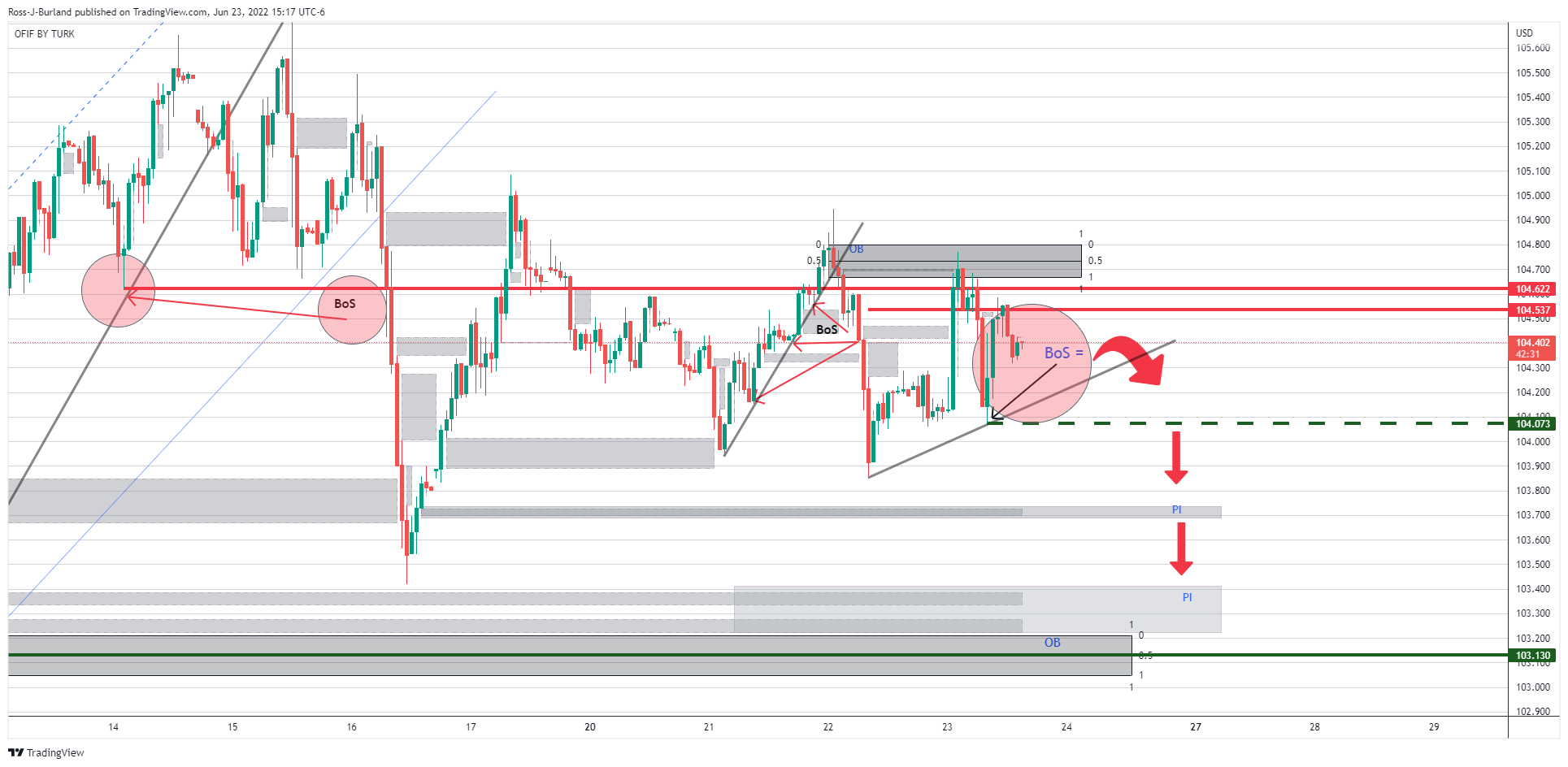
The DXY is already down to a decline since Friday to 0.5%. It has fallen 1.57% from the two-decade peak of 105.79 reached on June 15, when the Federal Reserve raised rates by 75 basis points, which was the biggest hike since 1994.
This is due to the concerns that the Fed's commitment to quelling red-hot inflation will spur a recession that has sent the 10-year Treasury yields sliding to an almost two-week low.
"Powell's semi-annual testimony has taken some steam out of the USD, his comments regarding elevated recession risk evidently weighing more than his unconditional commitment to restore price stability," Westpac analysts recently said.
"But with 75bp still on the table for July and Fed Funds set to rise above 3% by year’s end, USD interest rate support should ultimately continue to build."
The analysts at Westpac have observed the risks and forecast that the DXY will drop to as far as the 102 level in the near term.
Meanwhile, analysts at TD Securities argued that ''gold prices are overvalued relative to real rates, but the market has been hard-pressed to find a catalyst for a repricing.''
''Market pricing for Fed hikes has soared in recent months, leading real rates substantially higher amid an aggressive quantitative tightening program, without a commensurate meltdown in gold prices. Gold's outperformance is partially attributable to the massive amount of potentially complacent speculative length from proprietary traders in the yellow metal.''
On the second and last day of his testimony, Powell reiterated the Fed's commitment to bringing inflation under control. He said on Wednesday that a recession was "certainly a possibility" and that nothing was off the table in response to a question about the odds of a 100-basis-point hike.
US stocks have managed to end in the green on a volatile day with the Dow Jones Industrial Average adding 0.6% to 30,677.36. The S&P 500 was up 1% to 3,795.73 and the Nasdaq Composite climbed 1.6% to 11,232.19. This is all despite hawkish rhetoric at the Fed and dismal data.
The June flash reading of manufacturing conditions from S&P Global fell to 52.4 in June from 57 in May, compared with 56 expected in a survey compiled by Bloomberg. After falling 8.6% in February, 3.0% in March and 2.6% in April, existing-home sales dropped another 3.4% in the US in May to 5,410K (seasonally adjusted and annualized), bringing the total drawback over four months to 16.6%. This was also the lowest level of sales observed in nearly two years.
Gold technical analysis
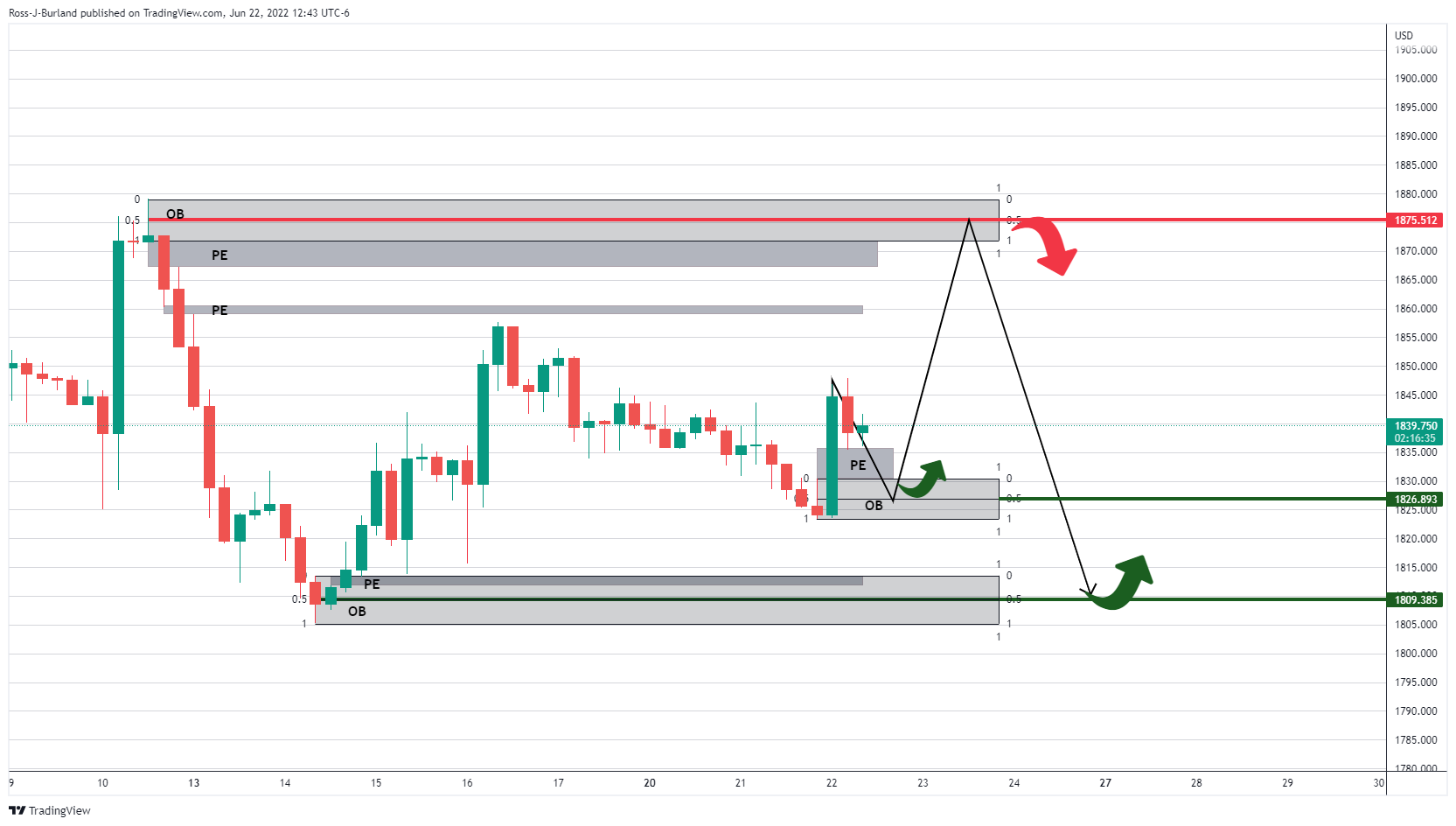
In the prior day's analysis, the price of gold was anticipated to move lower in order into the $1,820s, albeit not quite as far as it has done so. Nevertheless, the break of structure is a compelling feature of the 4-hour time frame that gives rise to the prospects of a deeper advance towards $1,810 if the bulls throw in the towel:
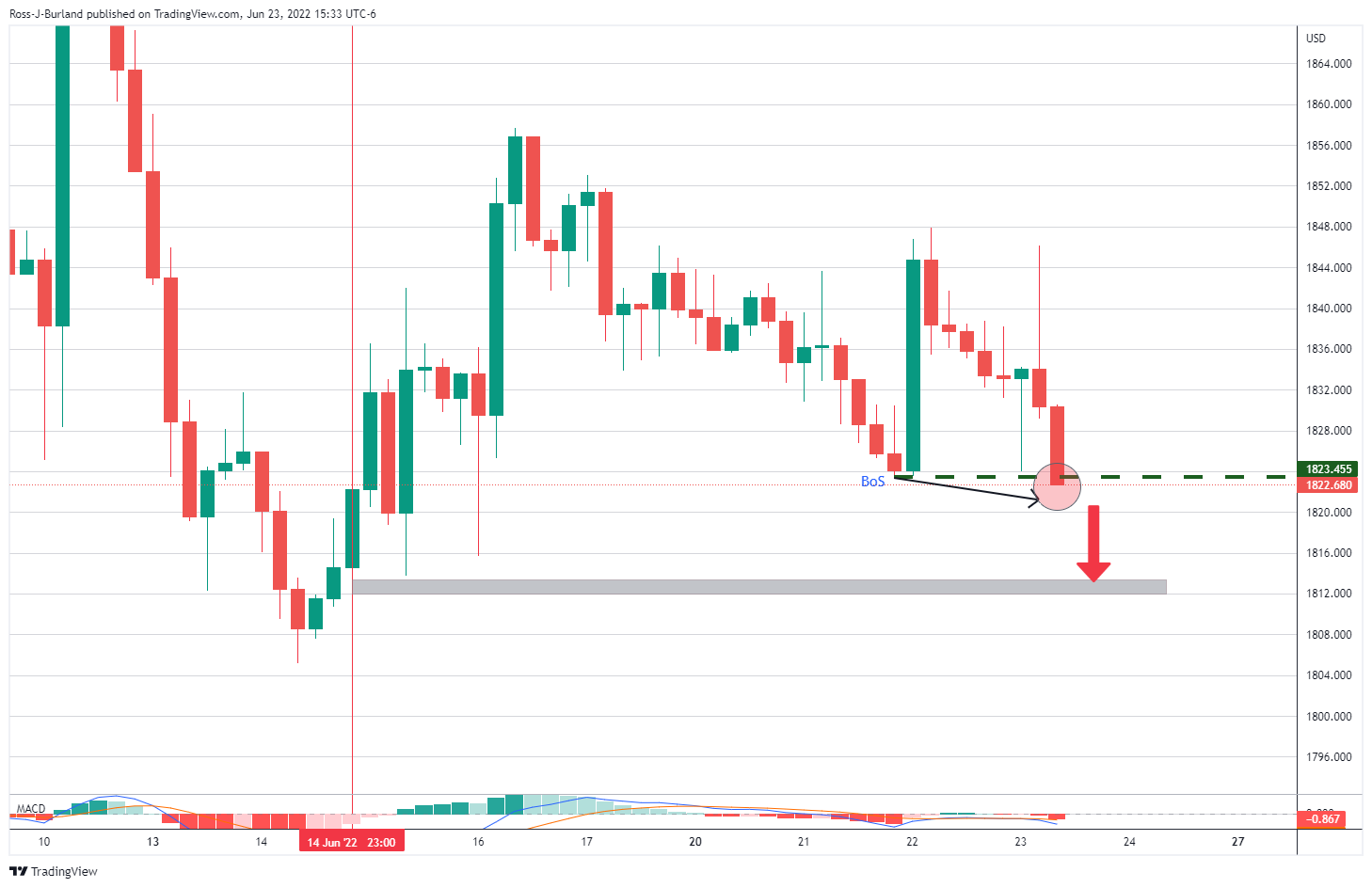
The above analysis of the 4-hour time frame pinpoints the areas of liquidity in the order blocks (OBs), or the expected levels of demand and supply, and the areas where the price is yet to mitigate the price inefficiencies (PI), or 'price imbalances' (a miss-match in bids and offers). This leaves the price trapped between $1,810, or thereabout, on the downside and $1,875, or there about on the upside. If the bulls commit within the current ranges, then there will be a case for a move higher towards areas of imbalance above on the way towards $1,875.
- The New Zealand dollar is crawling in the week, down 0.61%.
- US Fed pace tightening, recession fears, and sentiment were headwinds for the NZD/USD.
- US S&P Global PMIs begin to show that the economy is slowing at a faster pace than estimated.
The NZD/USD dives for the second consecutive day, though late in the session recovered some ground, and bounced off daily lows around 0.6247 amidst a risk-off impulse, as shown by global equities fluctuating between gains and losses. At the time of writing, the NZD/USD is trading at 0.6276.
NZD/USD traders must be aware that New Zealand will observe a holiday on Friday, so beware of thin liquidity conditions during Asia’s session. Meanwhile, the NZD/USD slid due to a buoyant greenback, which, illustrated by the US Dollar Index, gained 0.22%, at 104.405.
Recession fears and sentiment kept the NZD/USD heavy
Sentiment shifted sour on US recession fears. Fed’s Chief Jerome Powell testified at the US House of Representatives, matching Wednesday’s speech and answers, reiterating the Fed’s commitment to tackle inflation and, albeit challenging, expects to achieve a “soft landing.” Further, Fed speaking, in the name of Michelle Bowman, a member of the Board of Governors, backed a 75 bps for July and stated that inflation is unacceptably high, showing no signs of moderating.
In the meantime, Thursday’s US calendar featured Initial Jobless Claims for the last week (ending June 17), which rose by 229K more than the 227K estimated. Later, June’s S&P Global PMIs were revealed, with all three readings missing expectations.
Chris Williamson, Business Economist at S&P Global Market Intelligence, said, “Businesses have become much more concerned about the outlook as a result of the rising cost of living and drop in demand, as well as the increasingly aggressive interest rate path outlined by the Federal Reserve and the concomitant deterioration in broader financial conditions. Business confidence is now at a level which would typically herald an economic downturn, adding to the risk of recession.”
In the week ahead, the NZ economic docket is absent on holiday. In the US, the calendar will feature the Michigan Consumer Sentiment Final for June, alongside May’s New Home Sales.
NZD/USD Key Technical Levels
What you need to take care of on Thursday, June 23:
Fears continued to back the dollar, which ended the day with gains against most of its major rivals. The focus remained on overheating inflation and potential recessions among major economies.
German Economy Minister Robert Habeck announced the country would move to stage two of its three-stage gas plan amid reduced Russian flows. Ever since the war began in Ukraine, fuel shortages have been Europe's main concern. This particular phase does not mean state intervention, scheduled for the next one.
The EU flash S&P Global PMIs for June painted a gloomy picture as EU economic activity hit a 16-month low, reflecting a stalling of demand growth. The manufacturing PMI contracted to 52, while the services index shank to 52.8 from 56.1 in May. Australian data beat expectations while UK figures were mixed, although not much different from May ones. Finally, the US manufacturing index slowed to 52.4 in June, an almost two-year low, while the Services PMI contracted to 51.6 from 53.4 in the previous month, a five-month low. The reports fueled recession-related concerns.
FOMC Chairman Jerome Powell testified before the House Financial Services Committee on Monetary Policy and the State of the Economy. Fed's head said that a big part of inflation wouldn't be affected by the central bank's tools, although another part will be. On a positive note, he added that growth this year should still be fairly strong, but his comments clearly reflect concerns about inflation and growth, as he repeated that it would be "very challenging" to ensure a smooth landing.
Wall Street spent the day in the red but managed to post modest gains on Thursday. US Treasury yields, on the other hand, edged lower amid demand for safety.
Major pairs remained within familiar levels. The EUR/USD pair trades around 1.0530, while GBP/USD stands at around 1.2260. The AUD/USD pair struggles around 0.6900 while USD/CAD nears 1.3000. Safe-haven CHF and JPY posted modest advances against the dollar.
Gold finished the day near its weekly low, now trading at around $1,825 a troy ounce. Crude oil prices were stable, with WTI settling at $104.00 a barrel.
Like this article? Help us with some feedback by answering this survey:
- AUD/USD is finding solace in firmer stocks and in the weakness of the US dollar and prospects of lower levels in DXY to come.
- Analysts eye 102 for DXY near term, and this leaves AUD in limbo.
At 0.6896, AUD/USD is down some 0.4% on the day although the US dollar remains under pressure on Thursday as it looked set to extend declines against major peers to a fourth day. Nevertheless, the Aussie struggles across the board and vs the greenback, it has fallen from a high of 0.6927 to a low of 0.6869 so far as the Wall Street close approaches.
The greenback has been dented by Treasury yields wallowing near two-week lows amid rising concerns of a recession following two days of testimony from the Federal Reserves Chairman, Jerome Powell.
Powell said in testimony to Congress on Wednesday that the central bank is fully committed to bringing prices under control even if doing so risks an economic downturn. He said a recession was "certainly a possibility," reflecting fears in financial markets that the Fed's tightening pace will throttle growth.
On his second day of testifying before Congress, Powell said the Fed's commitment to reining in 40-year-high inflation is "unconditional" but also comes with the risk of higher unemployment. However, there has been less of an impact on Thursday from his comments as the narrative moved over from inflation and towards the rising likelihood of a recession following alarmingly poor US data.
Markit’s flash composite PMI cooled from 53.6 in May to a 5-month low of 51.2 in June. While still above the 50-point mark separating expansion from contraction, this result was the second weakest since July 2020, when the economy was emerging from a pandemic-induced lockdown. The manufacturing sector tracker fell from 57.0 to a 23-month low of 52.4, marking one of the largest monthly declines in data going back to 2007. The services sub-index, for its part, decreased from 53.4 to a 5-month low of 51.6.
After falling 8.6% in February, 3.0% in March and 2.6% in April, existing-home sales dropped another 3.4% in the US in May to 5,410K (seasonally adjusted and annualized), bringing the total drawback over four months to 16.6%. This was also the lowest level of sales observed in nearly two years.
Nevertheless, Wall Street's main indexes were mixed in choppy trading on Thursday and the benchmark S&P 500 is headed for a positive close as gains in defensive shares countered declines for economically sensitive groups amid growing worries about a recession. Benchmark U.S. Treasury yields fell to two-week lows, supporting tech and other growth stocks and keeping the Nasdaq in positive territory.
However, trading is set to remain volatile in the wake of the S&P 500 last week logging its biggest weekly percentage drop since March 2020. Investors are weighing how far stocks could fall after the index earlier this month fell over 20% from its January all-time high, confirming the common definition of a bear market, which is not going to be favourable for the high better currencies such as the Aussie.
US dollar bulls throwing in their towels
In the meantime, it can take refuge in the softness of the greenback and the prospects of lower levels to follow, as per the following technical analysis:
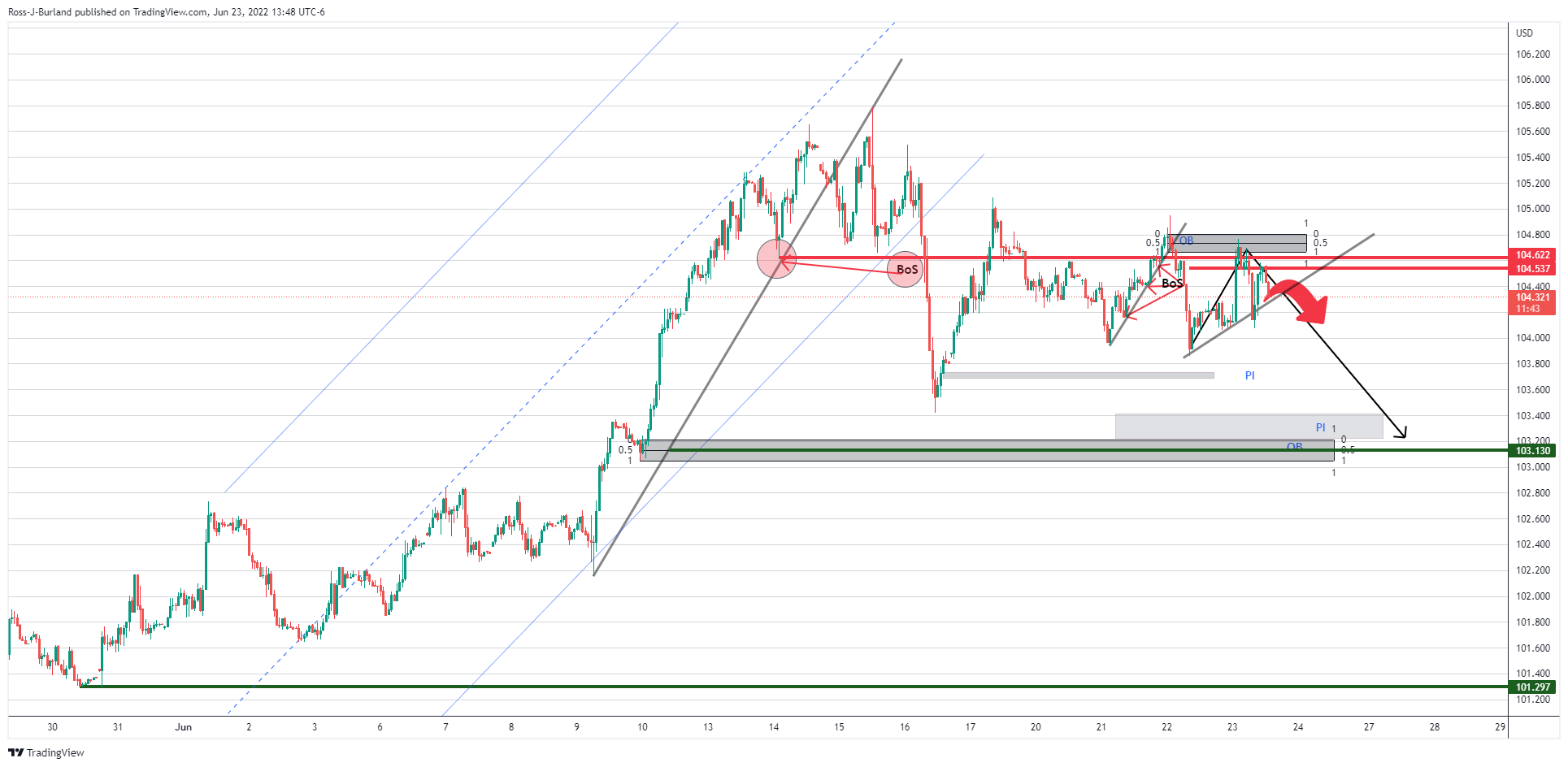
The dollar index (DXY), which measures the currency against six key rivals, slipped 0.14% to 104.06 in recent trade which is leaving an hourly H&S on the chart, taking it towards a test of the neckline at the time of writing:
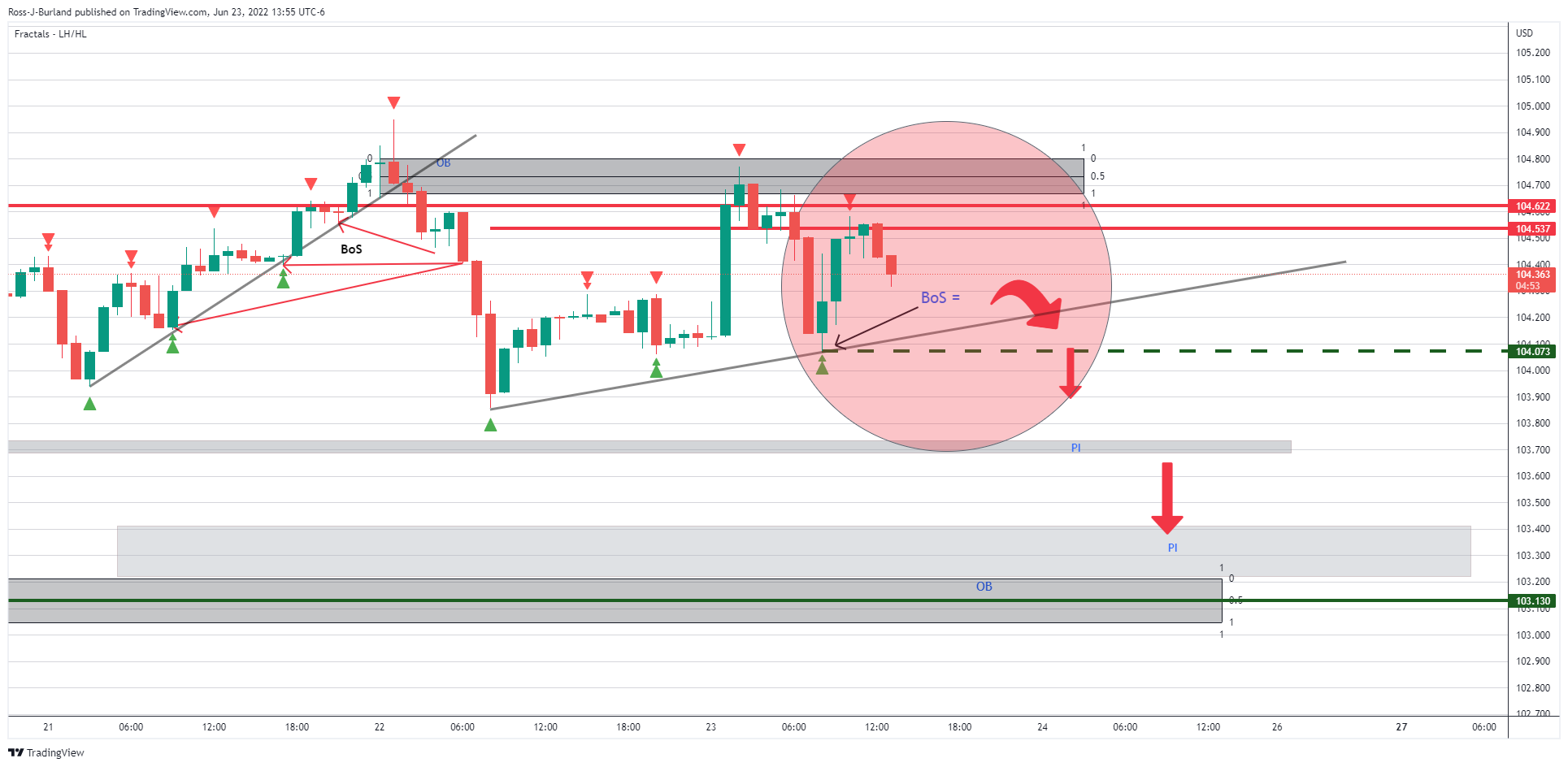
A break of structure, BoS, will open risk to run on the price imbalances, PI, below and that will leave 103.13 (a mid-point of an important bullish order block, OB) and below exposed.
- US Dollar Price Analysis: Bears taking out short-term structure, 103 vulnerable of a test below
The DXY is already down to a decline since Friday to 0.5%. It has fallen 1.57% from the two-decade peak of 105.79 reached on June 15, when the Federal Reserve raised rates by 75 basis points, which was the biggest hike since 1994.
This is due to the concerns that the Fed's commitment to quelling red-hot inflation will spur a recession that has sent the 10-year Treasury yields sliding to an almost two-week low.
"Powell's semi-annual testimony has taken some steam out of the USD, his comments regarding elevated recession risk evidently weighing more than his unconditional commitment to restore price stability," Westpac analysts recently said.
"But with 75bp still on the table for July and Fed Funds set to rise above 3% by year’s end, USD interest rate support should ultimately continue to build."
The analysts at Westpac have observed the risks and forecast that the DXY will drop to as far as the 102 level in the near term.
As for the Aussie, analysts at Rabobank said, ''we expect AUD/USD to hold close to current levels on a 1-month view and rise moderately to the 0.73 area by year-end. ''
''The AUD is likely to be sensitive to risks regarding Chinese economic output and broader concerns regarding slowing global growth.''
- The white metal remains on the defensive and dives more than 2% on Thursday.
- Fed officials backed further rate hikes, though Fed chair Powell acknowledged that the US might get into a recession.
- Silver Price Forecast (XAG/USD): Stays downward biased, and a break below $21.00 might pave the way for fresh YTD lows.
Silver (XAG/USD) plunges in the mid-North American session, falling from daily highs around $21.50 just above the $21.00 figure, weighed by a buoyant greenback amidst a mixed market mood, portrayed by US equities advancing, while European bourses closed in the red. At the time of writing, XAG/USD is trading at $21.03.
Recession fears and robust greenback drag metals prices down
The US and global recession fears struck the white metal price and Gold also. On Wednesday, US Federal Reserve chief Jerome Powell admitted that achieving a “soft landing” would be challenging while accepting that the US economy might tip into a recession. Nevertheless, he reiterated Fed’s compromise to tame inflation, and Powell stated that he is not taking any size of rate increases off the table.
Today at the US House of Representatives, Powell reiterated his and the commitment of the Fed to tame inflation, and his narrative stuck around Wednesday’s speech. Meanwhile, one of his colleagues at the Fed, Governor Michelle Bowman, said that she supported a 75 bps in July and commented that inflation is unacceptably high, showing no signs of moderating.
Therefore, the greenback advanced as Fed officials laid the ground for another rate hike. The US Dollar Index, a measure of the buck’s value vs. a basket of currencies, climbs 0.15% to 104.339, contrarily to the US 10-year Treasury yield, which is sliding seven basis points, yielding 3.085%.
Elsewhere US 10-year TIPS (Treasury Inflation-Protected Securities), a proxy for US Real yields, slumps nine bps and is back below 0.60%. Usually, lower Real yields would mean that appetite for precious metals augments, but a strong US dollar puts a lid on precious metals prices.
Meanwhile, the US 10s-2s yield spread remains positive at 0.078%, though it remains to push towards 0%. A reading below 0% would imply that traders forecast a recession in the US.

Data-wise, the US economic docket reported Initial Jobless Claims, which rose by 229K higher than the 227K estimated, illustrating that the labor market is tight. Later US S&P Global PMIs, on its Manufacturing, Services, and Composite numbers for June, exposed that the US economy is slowing down, which unnerved investors.
Silver Price Forecast (XAG/USD): Technical outlook
Silver remains downward biased from a technical perspective, though facing strong support around the $21.00 figure. Oscillators, in this case, the Relative Strenght Index (RSI) is signaling that selling pressure is piling; but failure to achieve a daily close below $21.00 would keep XAG/USD buyers hopeful of a rebound towards the 20-EMA at $21.74.
So as the XAG/USD path of least resistance is downwards, the first support would be $21.00. Break below would send prices towards June 13 low at 20.96, followed by the YTD low at $20.45.

In what will be a long rd to membership, Ukraine has won its candidate status in a bid to gain EU membership.
EU leaders have accepted both Ukraine and Moldova as membership candidates of the European Union, European Council President Charles Michel said on Thursday evening.
"Agreement. #EUCO has just decided EU candidate status to Ukraine and Moldova. A historic moment", Michel said in a tweet referring to the European Council of EU leaders (EUCO).
Ukraine's Zelensky welcomed the EU move to grant candidacy status, calling it a unique and historic moment in the bilateral relationship
Meanwhile, in the latest updates with regards to the crisis, the BRICS countries, which include Brazil, Russia, India, China and South Africa, said they support talks between Russia and Ukraine in a joint statement published on the Kremlin's website on Thursday.
“We have discussed the situation in Ukraine and recall our national positions as expressed at the appropriate fora, namely the UN [Security Council] and UN [General Assembly]. We support talks between Russia and Ukraine,” the statement read.“We have also discussed our concerns over the humanitarian situation in and around Ukraine and expressed our support to efforts of the UN Secretary-General, UN Agencies and ICRC to provide humanitarian assistance in accordance with the basic principles of humanity, neutrality and impartiality established in UN General Assembly resolution 46/182,” they added.
The BRICS summit, hosted by Beijing, marks Russian President Vladimir Putin’s first international forum with other heads of major economies since he launched his invasion in Ukraine back in February.
Since the beginning of Russia's invasion, Ukraine's President Volodymyr Zelensky has indicated that he was willing to hold direct talks with Putin.
However, Russian forces have continued to pound Ukraine's second largest city Kharkiv and surrounding countryside with rockets.
- For GBP, all eyes are on the sentiment surrounding the BoE.
- GBP/USD is stalled within a channel between 1.2160 and 1.2315.
- Should the bulls commit, then there will be prospects of a large area of imbalance (PI) between 1.2469 and 1.2414.
At 1.2220, GBP/USD is down on the day so far by some 0.33%, falling from a high of 1.2294 to a low of 1.2170 so far after UK PMIs came in roughly in line with expectations in June and in choppy market conditions.
It's been a two-way street in global equities, with a rally in the US session vs risk-off day overnight with European bourses pressured overall. The euro was impaired by poor local PMIs which lifted the US dollar index, DXY, to a 104.78 peak that pressured peers in turn, including the pound.
UK economy and BoE in focus
However, yesterday’s UK inflation print coupled with today's UK PMI outcome underpins sentiment that the UK's central bank, the Bank of England, BoE, is on track to hike by 50bps rate hike in the next meeting. The Bank of England is watching for signs that the recent jump in inflation, which hit a 40-year high of 9.1% in May, might turn into a permanent problem for the British economy.
However, observers will argue that Britain's economy is showing signs of stalling as high inflation hits new orders and businesses report levels of concern that normally signal a recession. This was evident in today's S&P Global's Purchasing Managers' Index (PMI), that was covering services and manufacturing firms. The data showed companies were raising pay and passing higher costs on to clients, which is a concern for the Bank of England.
The PMI's preliminary composite index held at 53.1 in June, above the median forecast of 52.6 in a Reuters poll of economists and unchanged from May. But the PMI's measure of new orders effectively stagnated as it fell to 50.8, the lowest in over a year. Factory orders dipped below the 50.0 growth threshold to 49.6.
"The economy is starting to look like it is running on empty," Chris Williamson, a chief business economist at S&P Global Market Intelligence, said, adding that the economy was likely to show a fall in output in the second quarter that could deepen in the third quarter. "Business confidence has now slumped to a level which has in the past typically signalled an imminent recession," he also explained. Growth was being propped up by previously placed orders. Manufacturers had reported especially weak demand for exports, and service firms were seeing their post-lockdown bounce reverse as the cost of living rose, Williamson explained further.
Moreover, the PMI's business expectations index fell by 4.6 points in June, the largest monthly decline since the start of the COVID-19 pandemic, with manufacturers and service providers both reporting their lowest business optimism levels since May 2020.
On the upside, job creation was the strongest in three months, in the latest sign of the strength in the labour market.
''The UK is in danger of being the slowest-growing major advanced economy next year, with the highest inflation rate and the biggest current account deficit,'' Kit Juckes at Societe Generale said.
''That's quite a collection, and it represents a clear threat to the pound. Sentiment is already poor and there are plenty of speculative shorts out there too, but further weakness is likely. Whether it falls more as the US dollar continues to rise, or under-performs a recovering euro, it will struggle. Longer-term, we will see sterling make new trade-weighted lows.''
Meanwhile, the BoE said last week it was ready to act "forcefully" if it saw signs of persistent inflation pressures, suggesting it might raise interest rates by more than its standard quarter-point increase despite fears of a recession. Overnight index swaps are continuing to price in 50bp moves by the BoE at the next 3 meetings. This lays out a path that would leave Bank Rate above 3% by year-end.
On the charts, this could see the pound steady from the monthly support area and there are upside prospects in the near term so long as the market structure on the four-hour chart holds up.
GBP/USD technical analysis
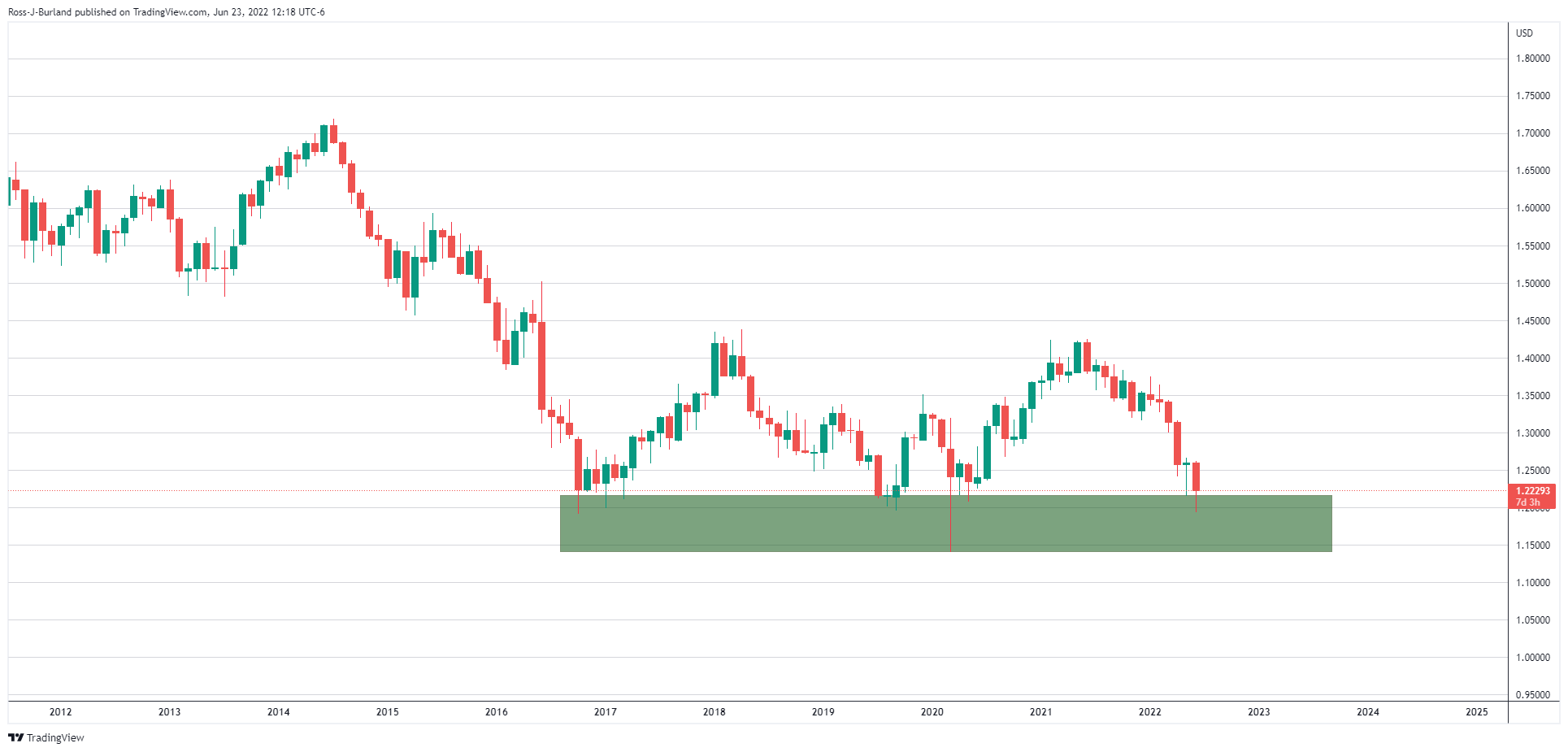
The monthly chart above is concerning given the strong bearish bias in 2022. However, there are some bullish features on the nearer-term charts that are encouraging as follows:
GBP/USD H4 chart, bullish mitigation prospects

As illustrated, the price recently moved sideways out of an uptrend but has since stalled within a channel between 1.2160 and 1.2315. Should the bulls commit, then there will be prospects of a large area of imbalance (PI) between 1.2469 and 1.2414 that could be mitigated giving way to chances of a move in to test 1.25 the figure thereafter, the highs o the order block (OB). However, there is still a slight inefficiency of price to the downside to 1.2154 that could be mitigated first of all as a last defence. If the bears commit through there, then the market structure will be broken and the bias will shift bearish again.
- The Swiss franc extends its weekly gains to almost 1%, as shown by the USD/CHF falling from weekly highs above 0.9700.
- Through the New York sesión, risk aversion pushed equities to negative territory and gave a fresh impulse to safe-haven assets, boosting the CHF.
- USD/CHF Price Analysis: The formation of a double tops looms and will target 0.9150.
The USD/CHF extends to four, its fall from around the 50-day moving average (DMA), at that time around 0.9707, aiming towards the 0.9600 figure, for the first time since early June. At the time of writing, the USD/CHF is trading at 0.9600.
The market sentiment shifted sour as US equities dwindled, trading in the red. The risk-off impulse boosted the Swiss franc, which has accumulated gains of almost 1% in the week, as the USD/CHF has fallen from 09712 to the 0.9600 area. Nevertheless, the uptick of the greenback, as shown by the US Dollar Index, a gauge of the buck’s value against a basket of six peers, gaining 0.24%, sitting at 104.440, capped any USD/CHF falls.
USD/CHF Price Analysis: Technical outlook
Daily chart
From a daily chart perspective, the USD/CHF remains neutral biased. However, once the Relative Strength Index (RSI) collapsed from overbought territory and broke below the RSI’s 7-day SMA, it opened the door for further losses. Besides, the formation of a double top that has failed to be confirmed so far, unless the USD/CHF breaches the necklines around 0.9544, will send the pair tumbling towards 0.9150.
Therefore, the USD/CHF first support would be the 0.9600 figure. A breach of the latter would pave the way towards the double top neckline at 0.9544. Once cleared, the major’s next support would be the 100-day moving average (DMA) around 0.9499.
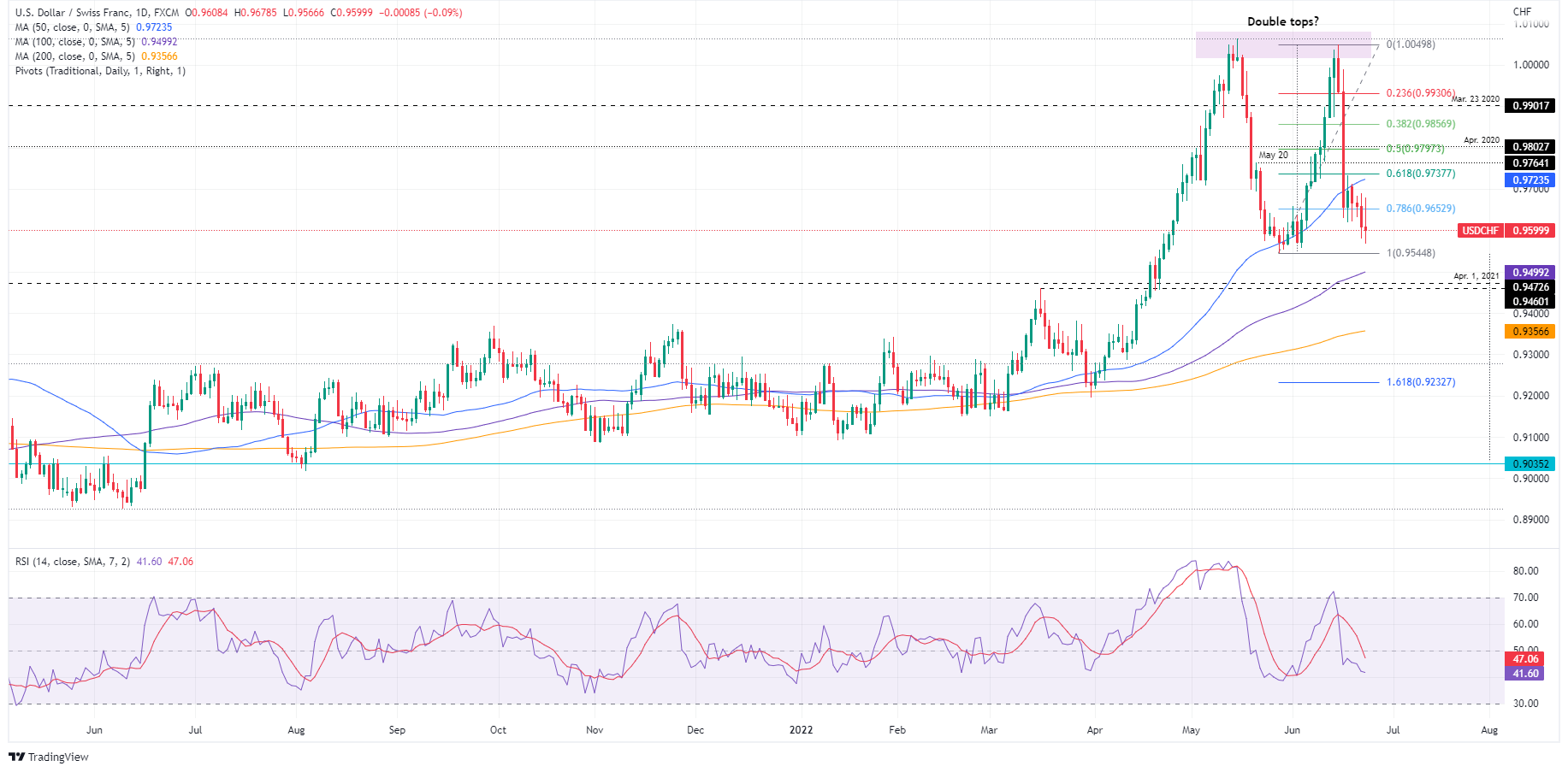
USD/CHF Key Technical Levels
The New Zealand dollar is losing ground on a softer economic outlook warn analysts at CIBC. They forecast the NZD/USD pair at 0.62 during the third quarter and at 0.61 by year-end.
Key Quotes:
“The NZD is facing depreciation pressure sourced in a number of factors, including that from broad negative global risk sentiment. We see pressures continuing to build in coming weeks, and anticipate a retest of recent NZD/USD lows below 0.6200.”
“Already there has been evidence of slowing in consumer and business sentiment, and of a decline in house prices. Challenges to domestic activity from sharply higher rates are a negative that will be exacerbated by weak activity in China – New Zealand’s largest trading partner, and by the outrun of higher rates and softer outlooks globally. In this environment, higher policy rates in New Zealand will not support the currency beyond present levels.”
“A key area of resistance in NZD/USD is between 0.6530 (January low) and 0.6576 (June high). While spot is held below this band, risk is for another test of the downside.”
Analysts at CIBC see the USD/CAD pair trading around 1.29 during the third quarter and rising toward 1.31 by year-end. They consider markets are overpricing tightening this year from the Bank of Canada and the Federal Reserve.
Key Quotes:
“A likely 75 bp hike by the Bank of Canada in July, and the potential for another move of that magnitude in September if we don't see enough of an inflation deceleration by then, should be aggressive enough to allow USDCAD to remain around current levels over the next three months.”
“Contrary to market expectations, the BoC is unlikely to send Canada's overnight rate beyond the Fed's destination of 3.25%. Canada’s debtburdened households and mortgage renewals will see rate hikes weigh more on discretionary consumer spending in Canada. That points to a slightly lower terminal rate for the BoC overnight rate, although we're leaning towards a 3% peak rather than our prior 2.75% after the May inflation data.”
“Markets appear to be overpricing both BoC and Fed tightening this year, but comparatively more for the BoC, and that recalibration will lead the CAD to end the year weaker, with USDCAD expected to reach 1.31 by then.”
“All told, look for USDCAD to reach 1.33 in early 2023, before recouping some of that ground further into the year as the USD loses favour globally.”
- US S&P Global PMIs showed that the US economy is expanding at a slower pace.
- Worst than expected, Eurozone PMIs, tripped the EUR/USD towards daily lows below 1.0500.
- Fed’s Powell said he would be reluctant to cut rates when asked at the US House of Representatives.
The EUR/USD slides for the first day in the week, down by 0.30%, courtesy of a mixed market mood and dismal S&P Global PMIs figures on the Euro area reported in the European session, which tumbled the EUR/USD from daily highs around 1.0580s to daily lows near 1.0482. At 1.0509, the EUR/USD prints losses and is ready to continue its path towards the 1.0500 figure.
A risk-off impulse and dismal EU reported PMIs, tumbled the euro
Sentiment is mixed in the markets. Worst than forecasted EU S&P Global PMIs, all the readings missed expectations, though it weighed more in France. The slowdown in Europe gathers pace even as the European Central Bank (ECB) prepares to lift rates in the July meeting, aiming to tame inflation under control.
The EUR/USD fell on the back of the abovementioned, alongside a risk-off impulse that caused a jump in the greenback. In the meantime, the US S&P Global PMIs also failed to achieve expectations, showing that the US economy is also slowing, but Fed speaking, put a lid on the EUR/USD’s recovery.
The US Federal Reserve Chair Jerome Powell, in his appearance at the House of Representatives, said that the Fed has an “unconditional commitment to fighting inflation” and added that bringing inflation without impacting the labor market would be challenging.
Furthermore, when Jerome Powell was asked about cutting rates, he said he is reluctant to do it while adding inflation expectations are anchored, but that’s not enough as, over time, they will come under pressure.
In the meantime, the Fed’s Governor Michell Bowman said that another 75 bps rate hikes would be needed, and she added that further rate hikes would be required. Bowman said that inflation is unacceptably high and has shown no signs of moderating.
Elsewhere, the US Dollar Index, a gauge of the buck’s value against its peers, pops up 0.25% sitting at 104.445, while US Treasury yields, fall, reflecting investors are reassessing not as aggressive as expected Fed tightening, as the US S&P Global PMIs crossed wires.
In the week ahead, the EU calendar will feature ECB speaking, with McCaul, Fernandez-Bollo, Vice-President de Guindos, and Germany’s Ifo indices for June. Across the pond, US New Home Sales and Michigan Consumer Sentiment for June on its final reading will shed some light regarding the US economy
EUR/USD Key Technical Levels
- Swiss franc among top performers on Thursday.
- Eurozone and US data add to concerns about the growth outlook.
- EUR/CHF approaches parity again, bearish pressure intact while under 1.0150.
After moving sideways for four days, EUR/CHF broke to the downside falling to as low as 1.0067, the lowest level since early March. The cross remains under 1.0100, about to post the second-lowest daily close since 2015.
A recovery back above 1.0150 should alleviate the bearish pressure. On the downside, support levels might be seen at 1.0040 followed by the parity zone and then the February low at 0.9970.
Yields down for the wrong reasons
Eurozone June PMIs surprised sharply to the downside across the service and manufacturing indices. For the region, the headline manufacturing came in at 52.0 against a market consensus of 53.8 down from 54.6 while the service dropped from 54.8 to 51.9.
“June PMI data show Europe teetering on the brink of recession. We now expect the euro area to enter into a mild recession in 2022H2”, wrote analysts at TD Securities. They point out that central banks, including the European Central Bank are likely to continue down their plotted paths for now, but they expect them to turn more cautious in their tone into year-end.
Easing tightening expectations from the European Central Bank have eased following the negative economic reports. The German 10-year yield is falling more than 10%, as it stands at 1.42% (on Monday it was at 1.80%). Even Italian yields are lower with the 10-year at 3.48%, the lowest since June 9.
Technical levels
FOMC Chairman Jerome Powell is testifying before the House Financial Services Committee on "Monetary Policy and the State of the Economy."
Key takeaways
"Our tools affect inflation, not necessarily wage inflation."
"Some of these wage increases are substantially bigger than is consistent with 2% inflation."
"Fed isn't looking for new tools."
"A big part of inflation won't be affected by our tools, but a big part of it will be."
"Our tools are blunt but they are the right tools to deal with demand."
"That's a bigger piece than energy and food prices."
"We are not seeking deeper involvement in the economy."
"We are not seeking new tools, though it's up to Congress if it wants to change Fed mandate."
Market reaction
The US Dollar Index edged higher after these comments and was last seen rising 0.2% on the day at 104.38.
- USD/JPY drops almost two hundred pips on Thursday.
- US S&P Global PMI falls to monthly lows
- US yields collapse as recession fears increase.
The USD/JPY dropped further following the release of US economic data and bottomed at 134.21, reaching the lowest level in six days. Bonds are rising across the globe, supporting the Japanese yen.
The pair then rebounded modestly, and it is hovering around 134.60/70, down more than 200 pips from Wednesday’s multi-year high. Below 134.40, the next support is seen at 133.80.
Yen gains as growth outlook worsen
Earlier on Thursday, Eurozone PMIs came in below expectations and triggered a rally in European bonds and helped the yen. More recently, the US S&P Global PMI also showed a significant decline in activity. Both the manufacturing and service numbers fell to the lowest level in months at 52.4 (consensus: 56) and 51.6 (53.5), respectively. Despite the worrying data, Wall Street is rising, with the Nasdaq up 1.25% and the S&P 500 climbs 0.63%.
The report added to concerns about the economy and weighed on monetary policy expectations. The US 10-year yield fell to 3.00%, the lowest in two weeks; just on Friday, it was trading near 3.50%, while the 30-year fell to 3.15%.
The US lost momentum across the board after the report. The DXY erased daily gains and pulled back to 104.20/30. The dollar’s losses against the yen are offset by a slide of EUR/USD as German bonds have the best day in years.
Fed Chair Powell is testifying again at Congress. Regarding concerns about the economic outlook, he mentioned is possible to have a strong labor market while curbing inflation. Fed’s Bowman said another 75 bps rate hike will be appropriate in July.
Technical levels
Federal Reserve Governor Michelle Bowman said on Thursday another 75 basis points (bps) rate increase in July and at least 50 bps of hikes at the next few meetings would be appropriate, as reported by Reuters.
Additional takeaways
"Further rate hikes may be needed after that, depending on how economy evolves."
"I am committed to a policy that will bring real federal funds rate back into positive territory."
"With inflation unacceptably high, doesn't make sense to have nominal fed funds rate below near-term inflation expectations."
"Our number one responsibility is to reduce inflation."
"Labor market will remain strong as rates rise, though actions are not without risk."
"Makes sense to eventually sell Fed's MBS holdings."
"My longer-term goal is to get Fed out of indirectly intervening in real estate market."
"I strongly supported Fed's June rate hike."
"Inflation has shown little sign of moderating."
"Labor market tightness is contributing to inflation."
"Labor shortages will likely persist in many sectors."
"Inflation at these levels threatens sustained job growth, overall health of the economy."
"Little prospect of inflationary effects of Ukraine invasion abating soon."
"Global supply chain issues continue as China COVID lockdowns slow production, shipping."
"We need to use tools to address inflation before expectations become entrenched."
Market reaction
The US Dollar Index showed no immediate reaction to these comments and was last seen posting small daily gains at 104.25.
FOMC Chairman Jerome Powell is testifying before the House Financial Services Committee on "Monetary Policy and the State of the Economy."
Key takeaways
"We need to get supply and demand back in better balance."
"Financial markets have been functioning well, banking system is very strong, well-capitalized."
"Liquidity in the treasury market has come down from where it was; looking at ways to address that."
"US is on an unsustainable fiscal path."
"There's a problem with longer-term housing supply."
"Housing market is slowing down to some extent now due to higher mortgage rates."
"Growth this year should still be fairly strong."
"We are trying to moderate demand so inflation can come down."
"We can't fail on getting inflation down."
"Would be reluctant to cut rates."
Market reaction
The greenback stays relatively quiet after these comments. The US Dollar Index was last seen posting small daily gains at 104.23.
- US stocks indices recover some ground after registering minimal losses on Wednesday.
- S&P Global PMIs indices missed expectations, dragging equities lower.
- The Nasdaq Composite leads the pack, followed by the S&P 500 and the Dow Jones.
- The greenback recovers some ground though US Treasury yields are falling as traders backpedaled against an aggressive Fed.
US equities opened in the green as Wall Street began within familiar ranges, though S&P Global PMIs where the three indices missed expectations, stocks seesawed and pullback from daily highs, but resumed the upward recovery.
The S&P 500 has regained composure, rising 0.53%, up at 3,777.04, though shy of Wednesday highs around 3800. Meanwhile, the tech-heavy index, the Nasdaq 100, again leads the pack to the upside, gaining 0.90%, up at 11,151.78, followed by the Dow Jones Industrial (DJIA) climbing 0.37%, advancing 30,595.05
Digging into the broader market index, the leading sectors are Consumer Staples, up by 1.60%, followed by Utilities, and Health, each recording gains of 1.148% and 1.46%, respectively. In negative territory stays commodity-related sectors like Energy, Materials, and Industrials, dropping by 1.12 %, 0.75%, and 0.68% each.
The greenback has recovered some territory and edges towards 104.374, up by 0.18%. Meanwhile, US Treasury yields remain on the defensive, with the US 10-year Treasury yield tumbling 14 bps, yielding 3.018%, retreating from weekly highs near 3.317%.
On Thursday, the S&P Global PMIs for the US missed expectations, showing that business activity in the manufacturing and services sector is expanding but at a weaker pace after sliding to 52.4 from 57 (Mfg.) and 51.6 from 53.4 (Services), with the latter readings in May. In the meantime, US Federal Reserve Chair Jerome Powell speaks at the US Congress for the second consecutive day.
At the time of writing, the Fed Board Governor Michelle Bowman stated that another 75 bps rate hike in July would be appropriate, followed by at least 50 bps at next subsequent meetings.
In the commodities complex, the US crude oil benchmark, WTI, slides 0.75%, exchanging hands at $105.47 BPD. At the same time, precious metals like gold (XAU/USD) rise 0.23%, trading at $1842.70 a troy ounce.
SP 500 Chart
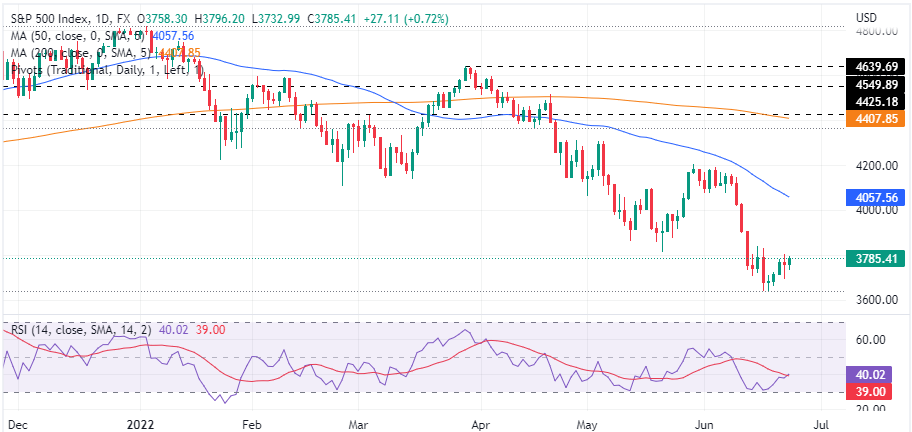
Key Technical Levels
FOMC Chairman Jerome Powell is testifying before the House Financial Services Committee on "Monetary Policy and the State of the Economy."
Key takeaways
"Possible to have strong labor market while curbing inflation."
"Challenge now is we are tightening, which should drive growth down."
"We don't have precision tools."
"There is a risk that unemployment will move up."
"But remember, that's from a historically low level."
"Labor market is overheated."
"Our intention is to achieve a soft landing, path to do that has gotten more and more challenging.""
Market reaction
The US Dollar Index continues to edge higher after these comments and was last seen rising 0.22% on the day at 104.40.
"The risk of inflation expectations becoming de-anchored has risen over the past months," European Central Bank (ECB) Governing Council member and German central bank head Joachim Nagel said on Thursday, as reported by Reuters.
"If monetary policy falls behind the curve, even stronger hikes in interest rates could become necessary to get inflation under control," Nagel further added. "This would create much higher economic costs."
Market reaction
The shared currency stays on the back foot after these comments and the EUR/USD pair was last seen losing 0.45% on a daily basis at 1.0518.
FOMC Chairman Jerome Powell is testifying before the House Financial Services Committee on "Monetary Policy and the State of the Economy."
Key takeaways
"As economy returns to normal, we expect profit margins to also normalize."
"We have unconditional commitment to fighting inflation."
"Labor market is unsustainably hot."
"We need sustained period of maximum employment and bringing down inflation is necessary to do that."
"Significantly more challenging to bring down inflation without impacting the labor market."
"Effects of shrinking balance sheet will be marginal compared to impact of rising interest rates."
Market reaction
The greenback stays relatively resilient against its rivals after these comments and the US Dollar Index was last seen rising 0.13% on the day at 104.32.
- S&P Global Services PMI for the US fell sharply in June.
- Major equity indexes in the US trade modestly higher.
Business activity in the US service sector expanded at a very weak pace in early June with the S&P Global Services PMI falling to 51.6 from 53.4 in May. This print missed the market expectation of 53.5.
The report showed that contractions in output and new orders weighed heavily on the headline figure.
Assessing the survey, "having enjoyed a mini-boom from consumers returning after the relaxation of pandemic restrictions, many services firms are now seeing households increasingly struggle with the rising cost of living, with producers of non-essential goods seeing a similar drop in orders," noted Chris Williamson, Chief Business Economist at S&P Global Market Intelligence. "There has consequently been a remarkable drop in demand for goods and services during June compared to prior months."
Market reaction
Despite the disappointing data, Wall Street's main indexes cling to modest gains in the early American session. As of writing, the Dow Jones Industrial Average and the S&P 500 indexes were up 0.35% and 0.3%, respectively.
- Gold attracted some dip-buying in the vicinity of the weekly low and shot to a fresh daily high.
- The ongoing slide in the US bond yields capped the USD and offered support to the commodity.
- Hawkish Fed expectations might hold back bulls from placing aggressive bets around the metal.
Gold reversed an intraday slide to the $1,824 area, back closer to the weekly low touched the previous day and shot to a fresh daily high during the early North American session. The XAUUSD was last seen trading, around the $1,840-$1845 region, up 0.25% for the day, with bulls still awaiting a sustained move beyond the very important 200-day SMA.
The ongoing steep decline in the US Treasury bond yields forced the US dollar to trim a part of its intraday gains, which, in turn, offered support to the dollar-denominated commodity. That said, a combination of factors held back bulls from placing aggressive bets and kept a lid on any meaningful intraday upside for gold, for the time being.
A turnaround in the global risk sentiment - as depicted by a generally positive tone around the equity markets - acted as a headwind for the safe-haven precious metal. Apart from this, expectations that the Fed would tighten its monetary policy at a faster pace to curb soaring inflation might also contribute to capping gains for the non-yielding gold.
The worsening global economic outlook, however, might continue to lend support to the XAUUSD and help limit any meaningful decline. Investors remain concerned that a more aggressive move by major central banks would pose challenges to the global economic recovery. Adding to this, Thursday's disappointing Eurozone PMIs further fueled fears about a possible recession.
The mixed fundamental backdrop warrants caution before positioning for any firm near-term direction for gold prices. This makes it prudent to wait for strong follow-through buying beyond the overnight swing high, around the $1,847-$1,848 region, to support prospects for additional near-term gains, possibly towards the $1,870-$1,880 supply zone.
Technical levels to watch
- EUR/USD remains under pressure below the 1.0600 mark.
- A drop to the June low at 1.0358 appears on the horizon.
EUR/USD reverses three consecutive daily retracements and opens the door to further downside in the short-term horizon.
So far, and as long as the 4-month line in the 1.0690/1.0700 region limits the upside, extra pullbacks in the pair should remain on the cards in the near term. Against that, the next support of note comes at the June low at 1.0358 (June 15) ahead of the 2022 low at 1.0348 (May 13).
In the longer run, the pair’s bearish view is expected to prevail as long as it trades below the 200-day SMA at 1.1142.
EUR/USD daily chart
- US manufacturing sector lost growth momentum in early June.
- US Dollar Index clings to modest daily gains after the data.
The S&P Global Manufacturing PMI plunged to 52.4 (flash) in June from 57 in May, missing the market expectation of 56 by a wide margin. This report revealed that the business activity in the manufacturing sector expanded at a much weaker pace in early June than it did in May.
Further details of the publication revealed that the Composite PMI declined to 51.2 from 53.6, compared to analysts' estimate of 53.7.
Commenting on the data, "the pace of US economic growth has slowed sharply in June, with deteriorating forward-looking indicators setting the scene for an economic contraction in the third quarter," said Chris Williamson, Chief Business Economist at S&P Global Market Intelligence.
Market reaction
The US Dollar Index edged slightly lower after this report and was last seen posting small daily gains at 104.30.
- DXY trades on a range bound theme above 104.00.
- Next on the upside comes the 2022 peak near 105.80.
DXY regains some composure above the 104.00 yardstick, reversing at the same time three consecutive daily pullbacks.
Ideally, the index should surpass the weekly highs at the 105.00 area in the near term to allow for the recovery to gather momentum and attempt a visit to the nearly 20-year peak in the 105.80 zone (June 15).
As long as the 4-month line around 102.00 holds the downside, the near-term outlook for the index should remain constructive.
Looking at the longer run, the outlook for the dollar is seen bullish while above the 200-day SMA at 97.79.
DXY daily chart
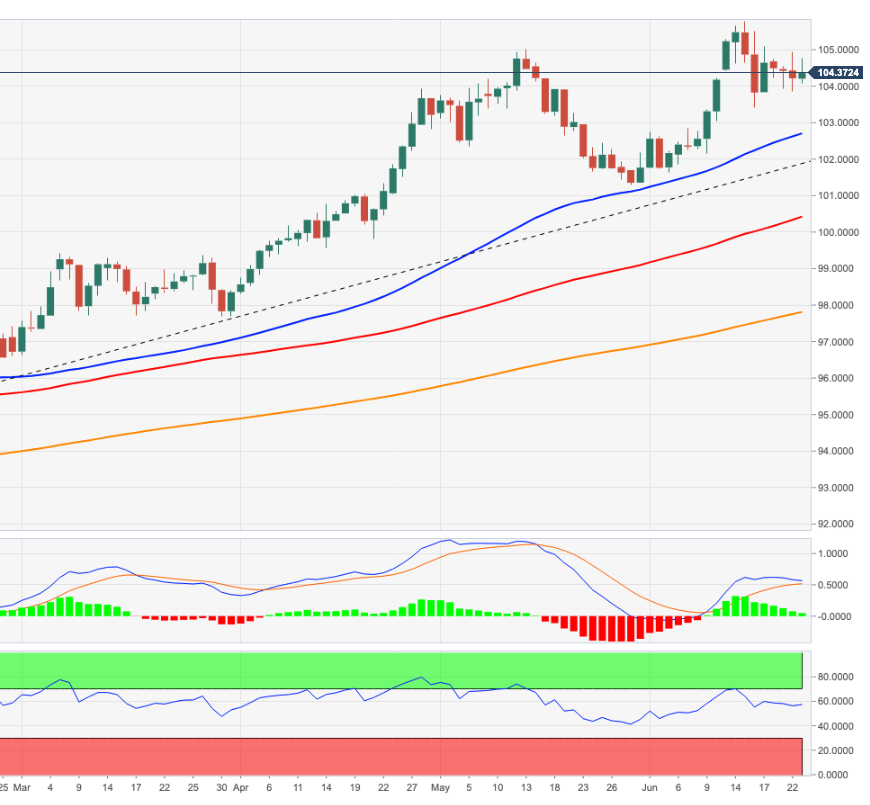
- EUR/JPY adds to Wednesday’s small loses and breaches 142.00.
- Further upside is likely while above the 138.00 area.
EUR/JPY flirts with new 3-day lows in the sub-142.00 region on Thursday.
Despite the corrective move, the cross keeps the upside momentum well and sound and the continuation of this move should retest the 2022 high at 144.25 (June 8) in the near term.
Once cleared, the next target of note should come at the 2015 high at 145.32 (January 2) prior to the 2014 high at 149.78 (December 8).
In the meantime, while above the 3-month support line around 138.00, the short-term outlook for the cross should remain bullish. This area appears reinforced by the proximity of the 55-day SMA.
EUR/JPY daily chart
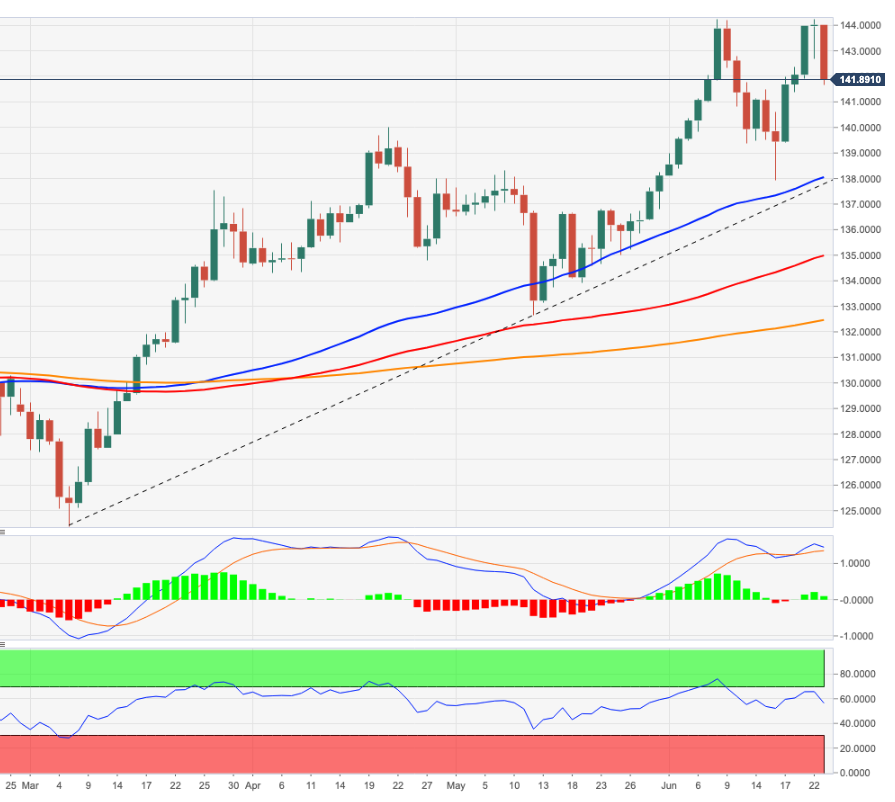
- GBP/USD found decent support ahead of the weekly low following the release of UK PMIs.
- Some cross-driven strength stemming from a slump in EUR/GBP further benefitted the GBP.
- Hawkish Fed expectations continued acting as a tailwind for the USD and might cap the pair.
The GBP/USD pair attracted some dip-buying near the 1.2170 area on Thursday and recovered around 80-85 pips from the vicinity of the weekly low touched the previous day. The pair was seen trading just above mid-1.2200s during the early North American session, nearly unchanged for the day.
The British pound drew support from better-than-expected UK PMI prints for June and some cross-driven strength stemming from the dismal Eurozone PMIs-led turnaround in the EUR/GBP cross. This, in turn, was seen as a key factor that offered some support to the GBP/USD pair, though a combination of factors might hold back bulls from placing aggressive bets.
The US dollar was back in demand amid firming expectations that the Fed hike interest rates at a faster pace to combat stubbornly high inflation. In fact, the markets have been pricing in another 75 bps rate hike move at the upcoming FOMC meeting in July. Apart from this, the worsening global economic outlook offered additional support to the safe-haven buck.
On the economic data front, the US Department of Labor there were 229K initial jobless claims in the week ending June 18 as against 227K anticipated. The previous month's reading was also revised higher to 231K from the 229K reported earlier. This, however, did little to dent the intraday USD bullish tone, which acted as a headwind for the GBP/USD pair.
Apart from this, speculations that the Bank of England would opt for a more gradual approach towards raising interest rates further contributed to capping the GBP/USD pair. This, along with the UK-EU impasse over the Northern Ireland Protocol of the Brexit agreement, supports prospects for some meaningful downside for the major.
Technical levels to watch
- Initial Jobless Claims declined by 2,000 in the week ending June 18.
- US Dollar Index holds in positive territory near 104.50.
There were 229,000 initial jobless claims in the week ending June 18, the weekly data published by the US Department of Labor (DOL) showed on Thursday. This print followed the previous week's print of 231,000 (revised from 229,000) and came in slightly higher than the market expectation of 227,000.
Further details of the publication revealed that the advance seasonally adjusted insured unemployment rate was 0.9% and the 4-week moving average was 223,500, an increase of 4,500 from the previous week's revised average.
"The advance number for seasonally adjusted insured unemployment during the week ending June 11 was 1,315,000, an increase of 5,000 from the previous week's revised level," the DOL's publication read.
Market reaction
There was no immediate market reaction to these figures and the US Dollar Index was last seen rising 0.25% on the day at 104.45.
- USD/JPY extended the overnight pullback from a 24-year high and edged lower for the second straight day.
- Speculations that authorities could intervene, along with recession fears underpinned the safe-haven JPY.
- Modest USD strength, the Fed-BoJ policy divergence support prospects for the emergence of some dip-buying.
The USD/JPY pair witnessed some selling for the second straight day on Thursday and moved further away from a 24-year high, around the 136.70 region touched the previous day. The pair maintained its offered tone through the mid-European session and was last seen trading just below mid-135.00s, down over 0.60% for the day.
Traders turned cautious and opted to lighten their bullish bets around the USD/JPY pair amid speculations that any further depreciation of the Japanese yen might force some form of practical intervention. Apart from this, the worsening global economic outlook drove haven flows towards the JPY and exerted downward pressure on the major.
Investors remain sceptic that major central banks could hike interest rates to curb soaring inflation without affecting economic growth. Adding to this, the disappointing release of the flash Eurozone PMI prints for June further fueled worries about a possible recession and boosted demand for traditional safe-haven assets.
Bearish traders further took cues from declining US Treasury bond yields, though the emergence of fresh US dollar buying helped limit deeper losses for the USD/JPY pair, at least for now. The USD drew support from firming expectations that the Fed would stick to its aggressive policy tightening path to combat stubbornly high inflation.
In fact, the markets have been pricing in another 75 bps rate hike move at the upcoming FOMC policy meeting in July. The bets were reaffirmed by Fed Chair Jerome Powell's remarks on Wednesday, saying that the ongoing rate increases will be appropriate. In contrast, the Bank of Japan remains committed to keeping interest rates very low.
It is worth recalling that the BoJ last week decided to maintain the massive stimulus programme and vowed to defend the 0.25% cap for the 10-year JGB yield to support a still-fragile economy. This, along with a turnaround in the global risk sentiment, assisted the USD/JPY pair to find support ahead of the 135.00 psychological mark.
The fundamental backdrop supports prospects for the emergence of some dip-buying around the USD/JPY pair. Hence, the negative move witnessed over the past two trading sessions might still be categorized as a corrective pullback and is more likely to be bought into, warranting some caution for aggressive bearish traders.
Next on tap is the US economic docket, featuring the release of the usual Weekly Jobless Claims data and the flash PMI prints for June. Traders will also take cues from Fed Chair Jerome Powell's second day of testimony. Apart from this, the US bond yields, the USD price dynamics and the broader risk sentiment might provide some impetus to the USD/JPY pair.
Technical levels to watch
- USD/TRY trades close to the 2022 high near 17.40.
- The CBRT left the interest rate unchanged at 14.00%.
- Focus now shifts to the release of the CPI on July 4.
The Turkish lira retreats modestly and allows USD/TRY to trade at shouting distance from the 2022 highs near 17.40 on Thursday.
USD/TRY: Next on the upside comes 17.50
USD/TRY adds to Wednesday’s marginal gains and approaches the 17.40 region after the Turkish central bank (CBRT) left the One-Week Repo Rate unchanged at 14.00% at its meeting earlier in the session.
The lack of action from the CBRT surprised no one on Thursday, as it was well telegraphed by the bank’s authorities in past weeks as well as by President Erdogan’s usual comments against any tightening of the monetary policy.
There were no changes of note in the CBRT statement, where elevated domestic inflation remains largely due to the geopolitical conflict and high energy prices as well as supply-demand imbalances. The CBRT keeps favouring the “liraization” strategy and remains stubbornly attached to the 5% inflation target in the medium term.
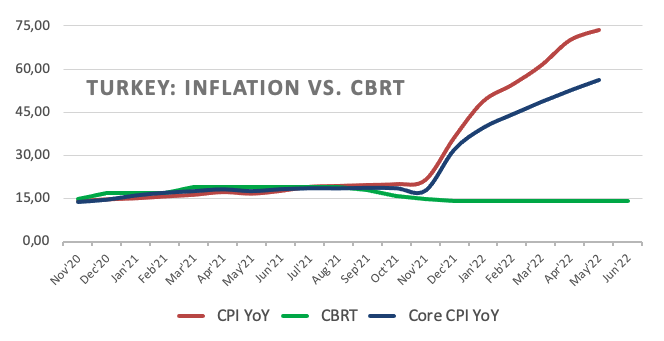
Investors, in the meantime, should now shift their focus to the publication of June’s inflation figures due on July 4 (prev: 73.50% YoY).
What to look for around TRY
USD/TRY keeps the underlying upside bias well and sound and now surpasses the 17.00 mark, an area last traded back in December 2021.
So far, price action in the Turkish currency is expected to gyrate around the performance of energy prices, the broad risk appetite trends, the Fed’s rate path and the developments from the war in Ukraine.
Extra risks facing TRY also come from the domestic backyard, as inflation gives no signs of abating, real interest rates remain entrenched in negative figures and the political pressure to keep the CBRT biased towards low interest rates remain omnipresent.
Key events in Turkey this week: Consumer Confidence (Wednesday) - CBRT interest rate decision (Thursday) – Capacity Utilization, Manufacturing Confidence (Friday).
Eminent issues on the back boiler: FX intervention by the CBRT. Progress (or lack of it) of the government’s new scheme oriented to support the lira via protected time deposits. Constant government pressure on the CBRT vs. bank’s credibility/independence. Bouts of geopolitical concerns. Structural reforms. Upcoming Presidential/Parliamentary elections.
USD/TRY key levels
So far, the pair is gaining 0.27% at 17.3637 and faces the next up barrier at 17.3728 (2022 high June 22) seconded by 18.2582 (all-time high December 20) and then 19.00 (round level). On the flip side, a breach of 16.3136 (monthly low June 3) would aim to 16.1431 (low May 27) and finally 15.6684 (low May 23).
- EUR/NOK alternates gains with losses near 10.50.
- The Norges Bank raised the policy rate by 50 bps.
- Higher Brent prices fail to lend support to NOK.
EUR/NOK navigates the middle of the daily range near 10.50 in the wake of the interest rate hike by the Norges Bank on Thursday.
EUR/USD now trades close to monthly peaks
EUR/NOK attempted a move higher earlier in the session, although the bullish attempt seems to have run out of steam around 10.52 despite the Norges Bank raised the key rate to 1.25% at its meeting on Thursday.
The Nordic central bank stressed that domestic fundamentals look solid and unemployment continues to decline. However, inflation is forecast to remain above the bank’s target for some time on the back of rising wage growth and prices of imported goods.
The Norges Bank also announced that the policy rate “will most likely be raised further to 1.5% in August”.
On another front, the Norwegian kroner appears indifferent to the current rebound in prices of the barrel of the European reference Brent crude, which regain the $111.00 mark after bottoming out near $107.00 on Wednesday.
EUR/NOK significant levels
As of writing the cross is gaining 0.09% at 10.4767 and faces the next resistance at 10.5393 (2022 high June 16) followed by 10.6323 (monthly high August 20 2021) and then 10.7035 (2021 high July 20). On the other hand, a breach of 10.3158 (weekly low June 21) would open the door to 10.0230 (monthly low June 1) and finally 9.9693 (200-day SMA).
The Central Bank of the Republic of Turkey (CBRT) left its benchmark interest rate, the one-week repo rate, unchanged at 14.00% on Thursday.
In its policy statement, the CBRT reiterated that it will continue to use all available instruments decisively within the framework of liraization strategy until strong indicators point to a permanent fall in inflation.
Market reaction
The USD/TRY pair showed no immediate reaction to this announcement and was last seen trading flat on the day at 17.35.
Additional takeaways
"Level of capacity utilization and other leading indicators show that robust growth in the beginning of the year continues in the second quarter as well."
"Sustainable components of economic growth increase with tourism-related improvements."
"Risks on current account balance due to energy prices continue."
"Sustainable current account balance is important for price stability."
"Credit growth and allocation of funds for real economic activity purposes are closely monitored."
"Ready to take additional macroprudential policy measures when needed."
- AUD/USD remained under some selling pressure for the second straight day on Thursday.
- Hawkish Fed expectations acted as a tailwind for the USD and dragged the major lower.
- Recession fears weighed on investors’ sentiment and undermined the risk-sensitive aussie.
The AUD/USD pair witnessed some selling for the second successive day on Thursday and dropped to over a one-week low, around the 0.6870-0.6875 region during the early part of the European session.
The market sentiment remains fragile amid doubts that major central banks could hike interest rates to curb soaring inflation without affecting economic growth. Adding to this, the disappointing release of the flash Eurozone PMI prints further fueled worries about a possible recession and continued weighing on investors' sentiment. This, in turn, was seen as a key factor that acted as a headwind for the risk-sensitive aussie.
Apart from this, a goodish pickup in the US dollar demand exerted some downward pressure on the AUD/USD pair. The prevalent caution market mood offered some support to the safe-haven greenback, which drew additional support from hawkish Fed expectations. The markets seem convinced that the Fed would stick to its aggressive policy tightening path to combat stubbornly high inflation and deliver another 75 bps at its upcoming meeting in July.
Fed Chair Jerome Powell reaffirmed market bets and said on Wednesday that the ongoing rate increases will be appropriate. During his testimony before the Senate Banking Committee, Powell added that Fed is strongly committed to bringing inflation back down and the pace of future rate increases will continue to depend on incoming data. This, in turn, favours the USD bulls and supports prospects for additional near-term losses for the AUD/USD pair.
Even from a technical perspective, acceptance below the 0.6900 round-figure mark could be seen as a fresh trigger for bearish traders. Hence, a subsequent slide towards the monthly low, around mid-0.6800s, looks like a distinct possibility. The downward trajectory could further get extended towards the YTD low, around the 0.6830-0.6825 region touched in May. Next on tap will be the US macro data ahead of Powell's second day of testimony.
Thursday's US economic docket features the release of the usual Weekly Initial Jobless Claims, followed by the flash PMI prints for June later during the early North American session. Apart from this, Powell's remarks, the US bond yields and the broader market risk sentiment will influence the USD price dynamics, producing short-term opportunities around the AUD/USD pair.
Technical levels to watch
The Confederation of British Industry's (CBI) latest Distributive Trades Survey showed on Thursday, the UK’s Retail Sales Balance dropped to -5 in June versus May’s -1 print.
Additional details
June Retail Sales 3-month average -14 vs. May -9, lowest in more than a year.
Retail Sales balance for the time of year -19 in June vs. 0 in May.
Market reaction
GBP/USD is trading around 1.2200, consolidating the recovery induced by the upbeat UK Services PMI. Bulls remain wary amid broad risk-aversion and a stronger US dollar.
According to Reuters, New Zealand’s Fonterra said on Thursday that it is likely to pay a higher price to farmers for milk supply for the next fiscal year, courtesy of a jump in dairy demand and the appreciation in the US dollar.
“The world's biggest dairy exporter expects to pay between NZ$8.75 and NZ$10.25 ($5.49 and $6.43) per kilogram of milk solid (kgMS) in the 2022-2023 financial year, up from a prior forecast of NZ$8.25 to NZ$9.75 per kgMS,” Reuters noted.
Fonterra’s Chief Executive Miles Hurrell said, “commodity prices have soared in response to strong continued demand for dairy, contributing to the higher price outlook.”
“Global interest rates and inflation have risen well above the company's earlier assumptions,” he added.
Market reaction
NZD/USD is trading 0.30% lower on the day at 0.6252, as of writing. The encouraging news fails to impress kiwi bulls.
- GBP/USD edged lower for the second successive day amid a pickup in the USD demand.
- Hawkish Fed expectations and recession fears continued acting as a tailwind for the buck.
- Mostly upbeat UK PMI prints extended support to sterling and limited losses for the pair.
The GBP/USD pair struggled to capitalize on the overnight solid bounce of around 100 pips from the weekly low and attracted some selling for the second successive day on Thursday. Spot prices dropped to the 1.2170-1.2165 area during the early part of the European session, albeit managed to rebound a few pips thereafter.
The US dollar was back in demand amid hawkish Fed expectations and drew additional support from the worsening global economic outlook, which, in turn, exerted downward pressure on the GBP/USD pair. The markets seem convinced that the Fed would stick to its policy tightening path to combat stubbornly high inflation and have been pricing in another 75 bps rate hike at the next FOMC meeting in July. The bets were reaffirmed by Fed Chair Jerome Powell on Wednesday, saying that the ongoing rate increases will be appropriate.
Furthermore, investors remain worried that a more aggressive move by major central banks to curb soaring inflation would pose challenges to the global economic recovery. Adding to this, the disappointing release of the flash Eurozone PMI prints for June further raised fears about a possible recession and further underpinned the greenback's safe-haven status. The anti-risk flow led to an extension of the recent decline in the US Treasury bond yields, which capped gains for the USD and extended some support to the GBP/USD pair.
Apart from this, mostly upbeat flash UK PMI prints assisted spot prices to recover near 50 pips from the daily low. It, however, remains to be seen if the GBP/USD pair is able to capitalize on the attempted recovery amid expectations that the Bank of England would opt for a more gradual approach toward raising interest rates. This, along with the UK-EU impasse over the Northern Ireland Protocol of the Brexit agreement, favours bearish traders and supports prospects for a further near-term depreciating move for the GBP/USD pair.
Market participants now look forward to the US economic docket, featuring the release of the usual Weekly Initial Jobless Claims and the flash PMI prints for June. Traders will further take cues from Fed Chair Jerome Powell's second day of testimony before the House Financial Services Committee. This, along with the US bond yields and the broader market risk sentiment, would influence the USD and provide some impetus to the GBP/USD pair.
Technical levels to watch
- WTI price remains vulnerable amid fears of an inevitable global recession.
- Big build in API crude stocks, Biden’s gas tax holiday undermine oil.
- Any rebound in WTI will likely get sold-off, as bears keep their sights on $100.
WTI (NYMEX futures) is reversing a sell-off from the $101 level, as bears take a breather before the next push lower.
A combination of bearish factors continues to keep the downside exposed in WTI, despite the latest rebound. Increasing odds of an incoming global recession undermine the sentiment around the black gold. The euro area preliminary Business PMIs disappointed and revived recession fears.
Meanwhile, a big build in the US stockpiles combined with US President Joe Biden’s gasoline tax holiday add to the weight on the price of oil. The American Petroleum Institute (API) reported a build this week for crude oil of 5.607 million barrels. It is the biggest inventory rise of over 5 million barrels since mid-February.
On Wednesday, Biden urged Congress to pass a three-month suspension of the federal gasoline tax to help combat record pump prices. All eyes now remain on the US PMIs and sentiment on Wall Street for fresh trading opportunities in WTI.
It’s worth noting that the US Energy Information Administration said its weekly crude stocks change data, due for release on Thursday, will be delayed due to systems issues until at least next week.
From a short-term technical perspective, WTI is likely to challenge the bullish 100-Daily Moving Average (DMA) at 104.37, which was the critical support a day before.
Acceptance above the latter will unleash the additional recovery towards 105, above which doors will open up towards the horizontal 50 DMA at 109.09.
WTI: Daily chart
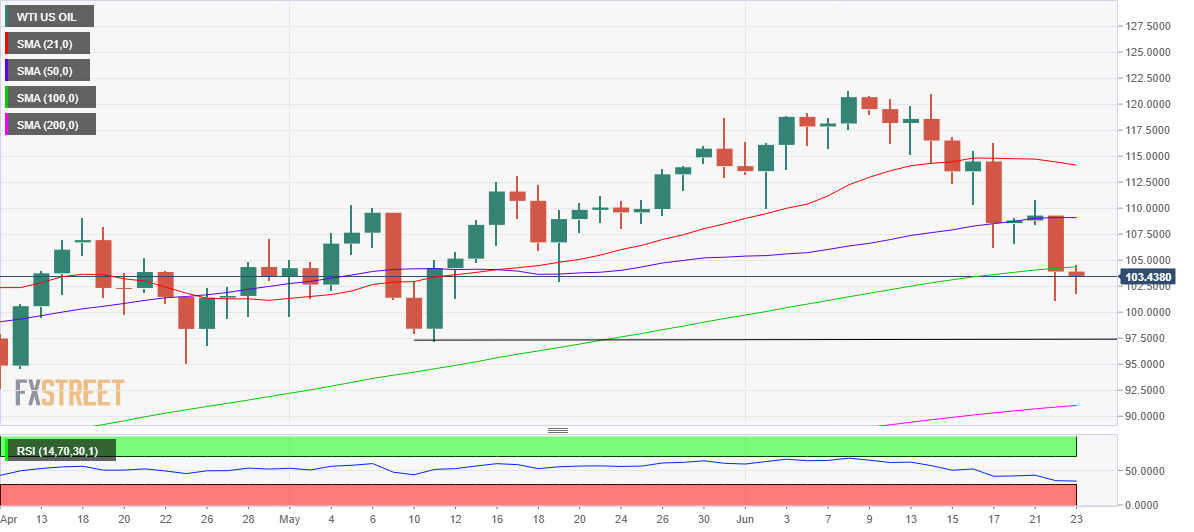
The 14-day Relative Strength Index (RSI) is sitting just above the oversold region, suggesting that any recovery could be a good selling opportunity.
The immediate downside target is seen at Wednesday’s low of 101.17, below which a fresh downswing will kick in towards the 100 mark.
Further south, the My 11 low of 97.21 will be on the sellers’ radars.
WTI: Additional levels to watch
- EUR/USD debilitates and breaks below the 1.0500 mark.
- EMU, Germany Flash PMIs surprised to the downside.
- Powell, Initial Claims next of note across the pond.
The single currency loses the grip and motivates EUR/USD to breaches the key support at 1.0500 the figure.
EUR/USD: Weekly upside capped above 1.0600
After three consecutive daily advances, EUR/USD now shows some signs of weakness and revisits the sub-1.0500 region, as concerns over a probable economic slowdown in the region have been exacerbated following the poor results from flash PMIs for the current month in the core Euroland.
Indeed, preliminary figures expect the Manufacturing PMI to retreat to 51.0 in France, 52.0 in Germany and 52.0 in the broader euro area. Regarding the Services gauge, it is seen dropping to 54.4 in France, 52.4 in Germany and 52.8 in the euro bloc.
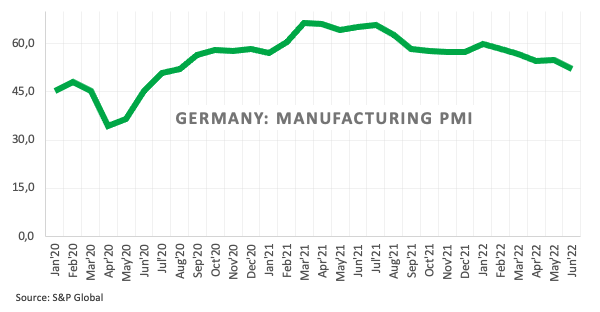
In the meantime, market participants continue to digest the recent testimony by Chief Powell before the US Senate, where he suggested that further tightening could cause recession despite the probability of such scenario is not elevated right now. Powell also kept a 100 bps rate raise on the table.
Later in the domestic calendar ECB Enria is due to speak. In the NA session, Initial Claims and the EIA’s report are due along with another testimony by Chair Powell.
What to look for around EUR
Recession fears following the release of flash PMIs in the core euro area sparked a moderate sell-off in the risk-linked galaxy and forced EUR/USD to once again break below the 1.0500 support.
In the meantime, the single currency continues to closely follow any developments surrounding the ECB and its plans to design a de-fragmentation tool in light of the upcoming start of the hiking cycle.
However, EUR/USD is still far away from exiting the woods and it is expected to remain at the mercy of dollar dynamics, geopolitical concerns and the Fed-ECB divergence, while higher German yields, persistent elevated inflation in the euro area and a decent pace of the economic recovery in the region are also supportive of an improvement in the mood around the euro.
Key events in the euro area this week: ECB General Council Meeting, Flash EMU, Germany PMIs (Thursday) – Germany IFO Business Climate (Friday).
Eminent issues on the back boiler: Fragmentation risks. Kickstart of the ECB hiking cycle in July? Asymmetric economic recovery post-pandemic in the euro bloc. Impact of the war in Ukraine on the region’s growth prospects.
EUR/USD levels to watch
So far, spot is down 0.64% at 1.0496 and faces the next support at 1.0358 (monthly low June 15) followed by 1.0348 (2022 low May 13) and finally 1.0300 (psychological level). On the other hand, a breakout of 1.0605 (weekly high June 22) would target 1.0629 (55-day SMA) en route to 1.0786 (monthly high May 30).
- Gold witnessed some selling on Thursday and was pressured by a combination of factors.
- Hawkish Fed expectations underpinned the USD and exerted pressure on the commodity.
- Recession fears weighed on investors’ sentiment and should limit losses for the XAUUSD.
Gold continued with its struggle to gain any meaningful traction and remained below the very important 200-day SMA through the early part of the European session. The XAUUSD was last seen trading just below the $1,935 level, down over 0.25% for the day.
The markets seem convinced that the Fed would retain its aggressive policy tightening path and have been pricing in another 75 bps rate hike at the next FOMC meeting in July. The bets were reaffirmed by Fed Chair Jerome Powell, saying that the ongoing rate increases will be appropriate. During his testimony before the Senate Banking Committee, Powell added that Fed is strongly committed to bringing inflation back down and the pace of future rate increases will continue to depend on incoming data. This, in turn, was seen as a key factor that continued acting as a headwind for the non-yielding gold.
Apart from this, the emergence of fresh US dollar buying exerted some downward pressure on the dollar-denominated commodity. The downside, however, seems cushioned, at least for the time being, amid the prevalent risk-off mood, which tends to benefit the safe-haven gold. The market sentiment remains fragile amid doubts that major central banks could hike interest rates to curb soaring inflation without affecting economic growth. Adding to this, the disappointing release of the flash Eurozone PMI prints for June added to worries about a possible recession and weighed on investors' sentiment.
The global flight to safety dragged the US Treasury bond yields lower, which might hold back the USD bulls from placing aggressive bets and further help limit losses for gold. That said, acceptance below a technically significant 200-day SMA favours bearish traders and suggests that the path of least resistance for spot prices is to the downside. It, however, would be prudent to wait for strong follow-through selling before traders start positioning for any further near-term depreciating move. Market participants now look forward to Fed Chair Jerome Powell's second day of testimony for a fresh trading impetus.
Technical levels to watch
In an Economic Bulletin article published on Thursday; the European Central Bank (ECB) underscored challenges to the economy from higher inflation.
Additional takeaways
The Governing Council will make sure that inflation returns to its 2% target over the medium term.
The June 2022 Eurosystem staff macroeconomic projections for the euro area foresee annual inflation at 6.8% in 2022, before it is projected to decline to 3.5% in 2023 and 2.1% in 2024 – higher than in the March projections.
Russia’s unjustified aggression towards Ukraine continues to weigh on the economy in Europe and beyond.
This outlook is broadly reflected in the Eurosystem staff macroeconomic projections, which foresee annual real GDP growth at 2.8% in 2022, 2.1% in 2023 and 2.1% in 2024.
the Governing Council intends to raise the key ECB interest rates by 25 basis points at its July monetary policy meeting.
Looking further ahead, it expects to raise the key ECB interest rates again in September. The calibration of this rate increase will depend on the updated medium-term inflation outlook.
Market reaction
EUR/USD is extending its decline, as the US dollar gains the upside traction on risk-off sentiment-led by recession fears. The pair is losing 0.76% on the day, currently trading at 1.0481.
- UK Manufacturing PMI drops to 53.4 in June, misses estimates.
- Services PMI in the UK comes in at 53.4 in June, a positive surprise
- GBP/USD briefly rebounds to 1.2200 on mixed UK Preliminary PMIs.
The seasonally adjusted S&P Global/CIPS UK Manufacturing Purchasing Managers’ Index (PMI) dropped to 53.4 in June versus 53.7 expected and 54.6 – May’s final reading.
Meanwhile, the Preliminary UK Services Business Activity Index for June arrived at 53.4 when compared to May’s final score of 53.4 and 53.0 expected.
Chris Williamson, Chief Business Economist at S&P Global, commented on the survey
“The economy is starting to look like it is running on empty. Current business growth is being supported by orders placed in prior months as companies report a near-stalling of demand. Manufacturers, in particular, are struggling with falling orders, especially for exports, and the service sector is already seeing signs of the recent growth spurt from pent-up pandemic demand move into reverse amid the rising cost of living.”
“Business confidence has now slumped to a level which has in the past typically signaled an imminent recession. The weakness of the broad flow of economic data so far in the second quarter points to a drop in GDP which the forward-looking PMI numbers suggest will gather momentum in the third quarter.”
FX implications
Positive surprise on the Services PMIs allowed the GBP/USD pair to briefly rebound to 1.2200 in a knee-jerk reaction.
The spot was last seen trading at 1.2183, down 0.69% on a daily basis.
FX Strategists at UOB Group Lee Sue Ann and Quek Ser Leang believe USD/CNH could extend the 6.6600-6.7400 range in the next few weeks.
Key Quotes
24-hour view: “Yesterday, we highlighted that ‘the underlying tone has firmed somewhat and USD could edge higher but 6.7200 is unlikely to come into the picture’. While our view for USD to strengthen was not wrong, we did not expect the sharp rise to 6.7340. However, the advance was short-lived as USD pulled-back swiftly from the high. The pullback amidst overbought conditions suggest that USD is unlikely to advance further. For today, USD is more likely to trade between 6.6900 and 6.7300.”
Next 1-3 weeks: “On Monday (20 Jun, spot at 6.7080), we highlighted that USD is likely to trade between 6.6600 and 6.7400. There is no change in our view for now. That said, shorter-term upward momentum has improved somewhat and this could lead to a test of 6.7400. Looking ahead, a clear break of 6.7400 could lead to a move towards 6.7600.”
- DXY moves higher following poor PMI data in the euro area.
- US yields extend the weekly corrective downside on Thursday.
- Weekly Claims, Flash PMIs, Powell’s testimony next on tap.
The greenback, when tracked by the US Dollar Index (DXY), regains the smile and advances to daily highs around 104.70 on Thursday.
US Dollar Index focused on data and Powell
The index so far reverses part of the recent weakness and manages to revisit the 104.70 region in the second half of the week.
Indeed, poor prints from flash PMIs in the central euro area for the month of June sparked a sell-off in the risk complex and lent legs to the buck amidst further retracement in the US yields across the curve.
Later in the NA session, usual Initial Claims are due seconded by advanced June PMIs and the weekly report on US crude oil inventories by the EIA. In addition, Chief Powell will testify again, this time before the House of Representatives.
What to look for around USD
The index seems to have embarked on a consolidation theme with the upper end limited around 105.00 for the time being.
The dollar, in the meantime, remains well supported by the Fed’s divergence vs. most of its G10 peers (especially the ECB) in combination with bouts of geopolitical effervescence, higher US yields and a potential “hard landing” of the US economy, all factors supportive of a stronger dollar in the next months.
Key events in the US this week: Initial Claims, Flash PMIs, Powell’s Semiannual Testimony (Thursday) – Final Consumer Sentiment (Friday).
Eminent issues on the back boiler: Hard, soft, softish landing of the US economy. Escalating geopolitical effervescence vs. Russia and China. Fed’s more aggressive rate path this year and 2023. US-China trade conflict. Future of Biden’s Build Back Better plan.
US Dollar Index relevant levels
Now, the index is gaining 0.39% at 104.59 and a break above 104.94 (weekly high June 22) would expose 105.78 (2022 high June 15) and then 107.31 (monthly high December 2002). On the downside, the next support aligns at 103.41 (weekly low June 16) seconded by 102.70 (55-day SMA) and finally 101.29 (monthly low May 30).
- EUR/GBP shot to over a one-week low on Thursday, though the uptick lacked bullish conviction.
- The disappointing release of the Eurozone PMIs weighed on the euro and acted as a headwind.
- Dovish BoE expectations continued undermining sterling and supports prospects for further gains.
The EUR/GBP cross gained some follow-through traction on Thursday and climbed to over a one-week high, around the 0.8640 region during the early European session. Spot prices, however, lost steam and retreated to the 0.8625 area in reaction to the disappointing release of the Eurozone PMI prints.
The preliminary report from S&P Global/BME research showed that the French economy recorded a notable slowdown in growth at the end of the second quarter. Adding to this, the latest flash PMI data showed a sharp loss of momentum in the German economy in June. This fueled worries over a possible recession, which might derail the European Central Bank's plan to tighten its monetary policy.
Doubts that the ECB will keep hiking interest rates further in the month ahead turned out to be a key factor that undermined the shared currency and capped gains for the EUR/GBP cross. That said, the British pound's relative underperformance, led by expectations that the Bank of England would opt for a more gradual approach towards raising interest rates, acted as a tailwind for spot prices.
Apart from this, the UK-EU impasse over the Northern Ireland Protocol of the Brexit agreement might continue to weigh on sterling and supports prospects for a further near-term appreciation for the EUR/GBP cross. Market participants now look forward to the flash version of the UK PMI prints for a fresh impetus. Nevertheless, the fundamental backdrops favour bulls, suggesting that any meaningful pullback could be seen as a buying opportunity and is more likely to remain limited.
Technical levels to watch
German Economy Minister Robert Habeck said on Thursday, gas is from now on in short supply in the country.
Further comments
The current situation should not lull us into a wrong feeling of security.
We are now called on to reduce gas consumption, looking ahead at winter.
Wants to underscore that this situation was always a threat.
Political mistake in past not to build up renewable energy, needs to be rectified immediately.
Regardless whether we trigger price clause, consumers are going to be paying more.
All political measures must be taken to ensure we have enough gas, that burden shared fairly.
Triggering price increase clause would mean companies can immediately pass on price increases.
If gas doesn't come via Nord Stream 1 after maintenance, then further measures needed.
Also read: Economy Ministry: Germany enters Phase 2 of emergency gas plan
Market reaction
EUR/USD is consolidating the latest drop to 1.0499 on the above comments. The pair is currently trading at 1.0514, down 0.45% on the day.
Germany's Economy Ministry declared on Thursday phase two of the emergency gas plan due to a cut in supply from Russia and high prices.
Additional takeaways
Government will not trigger clause allowing companies to pass on price increases at this time.
Security of supply is currently guaranteed, but the situation is tense.
If gas supplies from Russia remain at current low level of 40%, 90% storage level by December hardly achievable without additional measures.
Prices are high already, need to be prepared for further increases.
Germany to provide 15 bln euros in credit lines for filling gas storages.
Germany will launch a gas auction model in summer to encourage industrial gas consumers to save gas.
Related reads
- EUR/GBP eases from one-week low on dismal Eurozone PMIs, still well bid around 0.8625-30
- German Preliminary Manufacturing PMI drops to 52.0 in June vs. 54.0 expected
Here is what you need to know on Thursday, June 23:
Markets remain risk-averse on Thursday as investors grow increasingly concerned over a global recession. US stock index futures and major equity indexes in Europe push lower in the European morning and the dollar continues to find demand as a safe haven. Later in the session, FOMC Chairman Jerome Powell will testify before the House Financial Services Committee. The S&P Global's Manufacturing and Services PMI will also be featured in the US economic docket alongside the US Department of Labor's weekly Initial Jobless Claims data.
Earlier in the day, the data from Germany and France showed that the business activity in the private sector grew at a softer pace than expected in early June. Similarly, the eurozone Composite PMI declined to 51.9 from 54.8 in May, missing the market expectation of 54.
While testifying before the Senate Banking Committee on Wednesday, Powell acknowledged that the Fed's rate hikes could cause a recession. When asked about the possibility of the Fed considering a 100 basis points rate hike in the near future, Powell said they would not take any size of rate increase off the table. Following these comments, the benchmark 10-year US Treasury bond yield lost nearly 4% on Wednesday and continued to push lower early Thursday, highlighting the cautious market mood.
After having spent the Asian session in a relatively tight range below 1.0600, EUR/USD lost its traction on Thursday and declined toward 1.0500. The disappointing PMI data from the euro area seem to be weighing heavily on the shared currency.
GBP/USD suffers heavy losses early Thursday and trades below 1.2200. The British pound is having a tough time finding demand as investors continue to move away from risk-sensitive assets. The UK's FTSE 100 Index was last seen losing nearly 1% on the day.
Despite the broad-based dollar strength, USD/JPY is pushing lower and was last seen trading deep in negative territory below 135.50. The JPY seems to be capitalizing on safe-haven flows so far on the day.
Gold struggles to find direction and moves up and down in a tight range near $1,840. Despite falling US T-bond yields, the renewed dollar strength is not allowing XAU/USD to gain traction.
AUD/USD stays under heavy bearish pressure and trades below 0.6900. Although the PMI data from Australia came in better than expected, the AUD continues to lose interest as market participants seek refuge.
Bitcoin is staging a rebound and trades near $20,500 early Thursday after having briefly dipped below $20,000 on Wednesday. Similarly, Ethereum is up more than 4% near $1,100 following Wednesday's 6.75% decline.
- Eurozone Manufacturing PMI arrives at 52.0 in June vs. 53.9 expected.
- Bloc’s Services PMI falls to 52.8 in June vs. 55.5 expected.
- EUR/USD keeps the red near 1.0500 on the downbeat Eurozone PMIs.
The Eurozone manufacturing sector's pace of expansion disappointed once again in June, the latest manufacturing activity survey from S&P Global research showed on Thursday.
The Eurozone Manufacturing purchasing managers index (PMI) arrived at 52.0 in June vs. 53.9 expectations and 54.6 last. The index hit a two-year low.
The bloc’s Services PMI dropped sharply to 52.8 in June vs. 55.5 expected and 56.1 prior. The indicator reached five-month lows.
The S&P Global Eurozone PMI Composite slumped to 51.9 in June vs. 54.0 estimated and 54.8 previous. The gauge booked the lowest level in 16 months.
Comments from Chris Williamson, Chief Business Economist at S&P Global
“Eurozone economic growth is showing signs of faltering as the tailwind of pent-up demand from the pandemic is already fading, having been offset by the cost-of-living shock and slumping business and consumer confidence.”
“Excluding pandemic lockdown months, June’s slowdown was the most abrupt recorded by the survey since the height of the global financial crisis in November 2008.”
FX implications
EUR/USD remains vulnerable near 1.0500 on dismal euro area PMIs. Money market now price in ~160 bps worth of rate increases as against the ~170 bps estimated before the PMI reports.
FX option expiries for June 23 NY cut at 10:00 Eastern Time, via DTCC, can be found below.
- EUR/USD: EUR amounts
- 1.0350 660m
- 1.0400 815m
- 1.0450 1.2b
- 1.0465 589m
- 1.0500 1.4b
- 1.0600 992m
- 1.0685 328m
- 1.0700 534m
- GBP/USD: GBP amounts
- 1.2300 429m
- 1.2380 358m
- 1.2400 726m
- USD/JPY: USD amounts
- 132.00 1.2b
- 132.81 520m
- 133.00 400m
- 133.50 250m
- 134.00 641m
- 135.00 999m
- 137.00 470m
- 138.00 452m
- USD/CHF: USD amounts
- 0.9300 264m
- 0.9350 284m
- 0.9500 260m
- 0.9550 260m
- 0.9580 288m
- 0.9630 427m
- 0.9645 332m
- 0.9700 600m
- AUD/USD: AUD amounts
- 0.7000 322m
- 0.7025 313m
- 0.7050 301m
- 0.7100 628m
- 0.7125 559m
- USD/CAD: USD amounts
- 1.2500 820m
- 1.2625 332m
- 1.2650 325m
- 1.2800 1.4b
- 1.2915 1.8b
- 1.3050 441m
- EUR/GBP: EUR amounts
- 0.8815 1.2b
- Silver edged lower for the second successive day and dropped back closer to a one-week low.
- The set-up remains tilted in favour of bearish traders and supports prospects for further losses.
- Sustained strength beyond the $22.00 mark is needed to negate the near-term negative outlook.
Silver struggled to capitalize on the previous day's late rebound from a one-week low and edged lower for the second successive day on Thursday. The white metal remained on the defensive through the early European session and was last seen trading around the $21.35-$21.30 region.
Given that the XAG/USD has repeatedly failed to find acceptance above the 200-period SMA on the 4-hour chart and faced rejection near the $22.00 mark, the bias seems tilted in favour of bearish traders. The negative outlook is reinforced by the fact that oscillators on 4-hour/daily charts have again started drifting into the bearish territory.
Hence, a subsequent fall below the $21.00 round-figure mark, en-route the monthly low around the $20.90 region, now looks like a distinct possibility. The downward trajectory could further get extended and drag the XAG/USD back towards the YTD low, around the $20.45 region set in May. Bears might then aim to challenge the $20.00 psychological mark.
On the flip side, the $21.50-$21.55 region now seems to have emerged as immediate strong resistance. Any meaningful recovery attempted beyond the said barrier could be seen as a selling opportunity near the $21.75 region (200-period SMA). This, in turn, should cap the upside for the XAG/USD near the $21.90-$22.00 supply zone, at least for now.
The latter should act as a pivotal point, which if cleared decisively would negate the negative outlook and shift the bias in favour of bullish traders. The XAG/USD might then accelerate the positive momentum towards an intermediate resistance near the $22.30 area en-route the $22.50-$22.60 hurdle and the $23.00 round-figure mark.
Silver 4-hour chart
-637915662686648938.png)
Key levels to watch
- German Manufacturing PMI arrives at 52.0 in June vs. 54.0 expected.
- Services PMI in Germany eases to 52.4 in June vs. 54.5 expected.
- EUR/USD remains pressured towards 1.0500 on mixed German PMIs.
The German manufacturing and services sectors slowed their pace of expansion in June amid falling exports and strong inflation, the preliminary manufacturing activity report from S&P Global/BME research showed this Thursday.
The Manufacturing PMI in Eurozone’s economic powerhouse came in at 52.0 this month vs. 54.0 expected and 54.8 prior. The index slumped to 23-month lows.
Meanwhile, Services PMI dropped from 55.0 booked previously to 52.4 in June as against the 54.5 estimated. The PMI registered the lowest level in five months.
The S&P Global/BME Preliminary Germany Composite Output Index arrived at 51.3 in June vs. 53.1 expected and May’s 53.7. The gauge reached six-month troughs.
Key comments from Phil Smith, Economics Associate Director at S&P Global
“June’s flash PMI data show that Germany’s economy has lost virtually all the momentum gained from the easing of virus-related restrictions, with growth in the service sector cooling sharply for the second month in a row in June.”
“But perhaps the biggest cause for concern is a broad-based decline in demand, with a deepening downturn in manufacturing new orders coinciding with a first fall in service sector new business for six months, as rising prices and elevated levels of uncertainty take a toll. Activity is still being supported to some extent by workloads built up earlier in the year, however.”
FX implications
EUR/USD is holding the lower ground near 1.0520, down 0.45% on the day. The spot caught a fresh selling wave as the downbeat French and German PMIs ring recession bells.
- USD/CAD gained some positive traction on Thursday, though lacked strong follow-through buying.
- Bets for a 75bps BoC rate hike, rebounding oil prices underpinned the loonie and acted as a headwind.
- Hawkish Fed expectations continued lending support to the USD and should help limit the downside.
The USD/CAD pair attracted some buying on Thursday, albeit struggled to capitalize on the move and the uptick faltered near the 1.2985 region. The pair now surrendered a major part of its intraday gains and was seen trading in neutral territory, just above mid-1.2900s during the early European session.
The Canadian dollar drew support from hotter-than-expected domestic consumer inflation figures released on Wednesday, which lifted bets for a 75 bps rate hike move by the Bank of Canada in July. Apart from this, a modest recovery in crude oil prices underpinned the commodity-linked loonie and acted as a headwind for the USD/CAD pair amid subdued US dollar price action.
The downside, however, seems cushioned, at least for the time being, amid expectations that the Fed would retain its aggressive policy tightening path and again hike rates by 75 bps in July. Fed Chair Jerome Powell, during his testimony before the Senate Banking Committee, reaffirmed market expectations and said that the ongoing rate increases will be appropriate.
Powell added that Fed is strongly committed to bringing inflation back down and the pace of future rate increases will continue to depend on incoming data. Apart from this, the prevalent caution mood, amid growing concerns over a possible recession, offered some support to the safe-haven greenback. This, in turn, should limit any meaningful slide for the USD/CAD pair.
Market participants now look forward to the US economic docket, featuring the release of the usual Weekly Initial Jobless Claims and flash PMI prints. Apart from this, Fed Chair Jerome Powell's second day of testimony might influence the USD. Traders will further take cues from oil price dynamics to grab short-term opportunities around the USD/CAD pair.
Technical levels to watch
- Global markets remain dicey as traders await more clues to confirm economic slowdown.
- US 10-year Treasury yields remain inactive, stock futures in the US, Europe print mild losses.
- Fed’s Powell failed to impress greenback bulls, chatters surrounding BOJ dominate bond markets.
- Preliminary readings of June’s PMIs, second round of Powell’s Testimony will be important for fresh directions.
Fears of economic setback keep traders on their toes during early Thursday morning in Europe. The market’s pessimism, however, lacked major data/events during the Asian session and hence magnified the inaction. Additionally restricting the moves could be the cautious sentiment ahead of the first readings of the monthly PMIs from the Eurozone, the UK and the US.
With this, the US 10-year Treasury yields dropped the most in one week the previous day before portraying inaction at around 3.15% by the press time. Further, the S&P 500 Futures drop 0.20% to 3755 whereas the Eurostoxx 50 Futures print a 0.40% intraday fall at the latest.
Be it recently downbeat data from the major economies or the fears of a further supply crunch, global traders fear that the economic slowdown is a next-door enemy. Adding to the market fears are confirmation of the further aggression of central bankers, recently confirmed by the US Federal Reserve (Fed) Chairman Jerome Powell.
Fed’s Powell considered the present monetary policy bias appropriate to battle the inflation woes. It’s worth noting, however, that the Fed Boss’s readiness to use the aggressive measures, irrespective of their consequences, seemed to have put a floor under the greenback. On the same line is the latest news from Reuters signaling an upbeat print of June’s jobs report.
Policymakers from the European Central Bank (ECB), Swiss National Bank (SNB), Bank of Canada (BOC) and the Bank of England (BOE) were also suggesting further rate hikes during the latest appearance.
An exception amid the aggressive central banks, namely the Bank of Japan (BOJ), fails to gain the market’s sympathy as the bond market suggests the foreign funds’ exit from Japanese Treasuries, which in turn pushes the last stone to turn.
Elsewhere, fears of German economic contraction due to the maintenance-linked halt of Russian gas supplies join pessimism surrounding China’s economy and the Sino-American trade prospects to weigh on the market sentiment.
However, traders await the preliminary readings of June’s activity numbers from the key economies to confirm the bearish bias. Also important to watch will be the UK’s by-elections and the second round of Fed Chair Powell’s testimony, not to forget the weekly prints of the US jobless claims.
Also read: Recession fears dominate
The rally in USD/JPY could extend to the 137.50 region in the next few weeks, according to FX Strategists at UOB Group Lee Sue Ann and Quek Ser Leang.
Key Quotes
24-hour view: “Our expectations for the ‘overbought rally in USD to extend’ did not materialize as it traded between 135.67 and 136.71. The movement is viewed as part of a consolidation and we expect USD to trade sideways for today, likely within a range of 135.50/136.60.”
Next 1-3 weeks: “There is no change in our view from yesterday (22 Jun, spot at 136.30). As highlighted, USD could rise further to 137.00, as high as 137.50. That said, overbought shorter-term conditions could lead to a couple of days of consolidation first. Overall, only a break of 135.00 (no change in ‘strong support’ level from yesterday) would indicate that the upside risk that started earlier this week has come to an end.”
Open interest in natural gas futures markets extended the downtrend for yet another session on Wednesday, now by around 9.3K contracts. In the same direction, volume remained choppy and dropped markedly by nearly 134K contracts.
Natural Gas looks supported around $6.50
Prices of natural gas charted another inconclusive session on Wednesday against the backdrop of diminishing open interest and volume, which is supportive of further range bound trading in the very near term. On the downside, the commodity appears underpinned by the $6.50 mark per MMBtu.
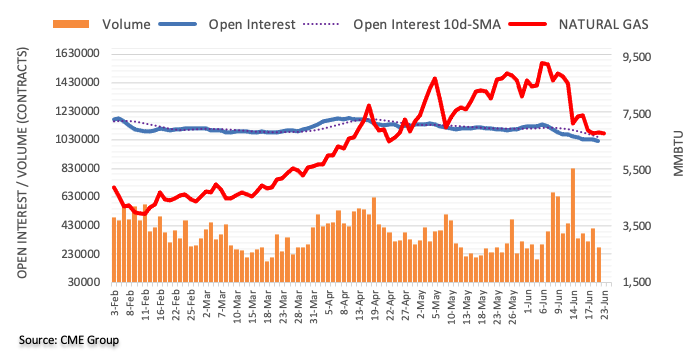
Further downside could prompt NZD/USD to breach the 0.6200 level in the next weeks, comment FX Strategists at UOB Group Lee Sue Ann and Quek Ser Leang.
Key Quotes
24-hour view: “While we expected NZD to weaken yesterday, we were of the view that ‘any weakness is unlikely to break the major support at 0.6265’. We did not expect the sharp drop as NZD plummeted to a low of 0.6244. Despite the rebound from the low, the risk is still on the downside. Fromm here, NZD could dip below 0.6240 but in view of the oversold conditions, it is unlikely able to maintain a foothold below this level (the next support at 0.6200 is not expected to come into the picture). Resistance is at 0.6300 followed by 0.6320.”
Next 1-3 weeks: “Three days ago (20 Jun, spot at 0.6320), we highlighted that the outlook for NZD is mixed and we expected NZD to trade sideways within a range of 0.6200/0.6410. While NZD is still trading within the range, shorter-term downward momentum has improved and the prospect of a break of 0.6200 has increased. The risk of NZD breaking 0.6200 would remain intact as long as NZD does not move above 0.6350 (‘strong resistance’ level) within these couple of days.”
Considering advanced prints from CME Group for crude oil futures markets, traders reduced their open interest positions by around 6.7K contracts on Wednesday, extending further the downtrend in place since June 7. Volume, instead, increased by around 113.2K contracts and partially reversed the previous pullback.
WTI: The $100 mark should hold the downside
Prices of the WTI retreated sharply and revisited the $101.00 region on Wednesday. The strong downtick was amidst shrinking open interest and hints at the idea that a deeper pullback is not favoured in the very near term. Against that, further downside in prices of the commodity should meet a tough support around the $100.00 neighbourhood.
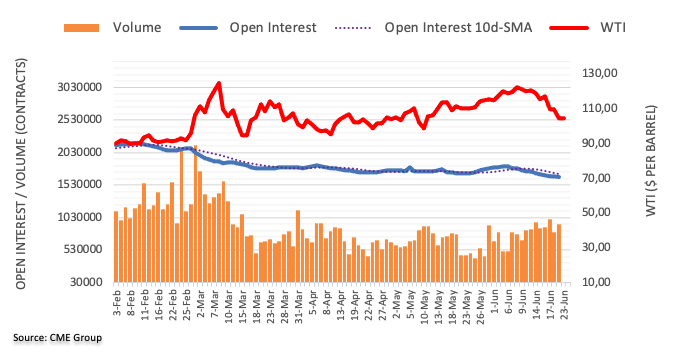
- GBP/JPY consolidates the biggest intraday losses in a week following the recent bounce.
- Weekly support-turned-resistance, short-term horizontal hurdle test recovery moves.
- Bearish MACD signals, downbeat RSI (14) hints keep sellers hopeful.
- Three-day-old resistance line adds to the upside filters, 100-SMA lures bears.
GBP/JPY picks up bids to pare intraday losses around 166.15-20 during Thursday morning in Europe. In doing so, the cross-currency pair jostles with the previous support line stretched from Tuesday.
Multiple supports surrounding 165.70-60 seem to have underpinned the quote’s latest rebound. However, a horizontal area including levels since June 13 and the support-turned-resistance line from Monday challenges the buyers around 166.20-30.
Also challenging the GBP/JPY buyers is the bearish MACD signals and the steady RSI.
It’s worth noting that even if the pair manages to cross the 166.30 hurdle, a downward sloping resistance line from Tuesday will challenge the upside momentum around 167.25.
Meanwhile, a clear downside break of the 165.60 could trigger a fresh fall targeting the 100-SMA level near 165.00.
Following that, the 50% Fibonacci retracement of June 09-16, near 164.40, will be important to watch as a break of which could direct GBP/JPY sellers towards the 200-SMA level of 162.35.
Overall, GBP/JPY is likely to consolidate the weekly gains despite the recent rebound.
GBP/JPY: Four-hour chart
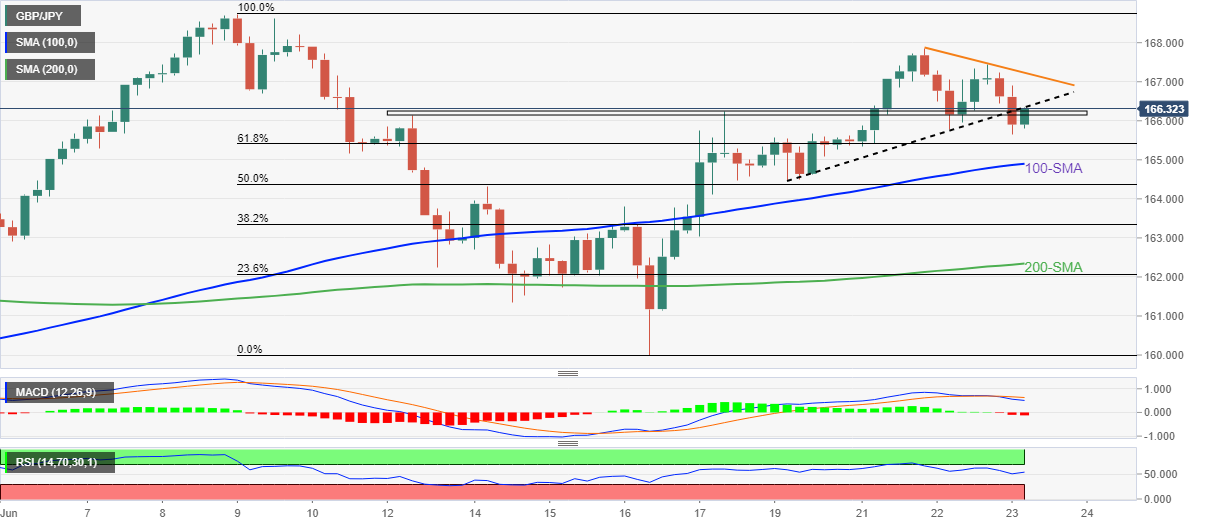
Trend: Further weakness expected
Germany is reportedly looking to enter a Phase 2 of its three-stage emergency gas plan on Thursday, Reuters reports, citing a source close to the matter.
The German network regulator will not yet trigger the price adjustment clause allowed with phase 2 of the emergency gas plan.
The Economy Ministry is set to hold a news conference at 0800 GMT.
Market reaction
EUR/USD is holding steady above 1.0550 ahead of the critical euro area PMI reports.
In the opinion of FX Strategists at UOB Group Lee Sue Ann and Quek Ser Leang, GBP/USD should keep navigating the 1.2040-1.2400 range in the next weeks.
Key Quotes
24-hour view: “Our expectations for GBP to ‘trade between 1.2225 and 1.2325’ yesterday were incorrect as it plunged briefly to 1.2163, soared to 1.2314 before dropping back down quickly to end the day slightly lower at 1.2265 (-0.11%). The sharp swings have resulted in a mixed outlook and further choppy price actions are not ruled out, likely within a range of 1.2200/1.2310.”
Next 1-3 weeks: “On Monday (20 Jun, spot 1.2225), we highlighted that the outlook is mixed and GBP could continue to trade in a choppy manner, likely between 1.2040 and 1.2400. There is no change in our view and we continue to expect GBP to trade between 1.2040 and 1.2400.”
CME Group’s flash data for gold futures markets noted open interest shrank by just 852 contracts on Wednesday after three consecutive daily builds. In the same line, volume resumed the downside and went down by around 28.1K contracts.
Gold: Gains remain capped by $1,880
Gold prices kept the familiar range and charted decent gains on Wednesday, always around the $1,840 region. The move was amidst diminishing open interest and volume, opening the door to some correction in the very near term and the continuation of the current consolidative mood at the same time.
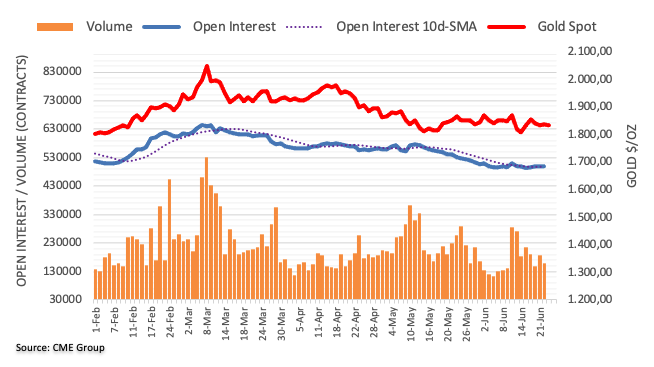
- Gold prices are juggling inside Wednesday’s value area amid the unavailability of any potential trigger.
- The DXY is displaying a lackluster performance ahead of the US PMI.
- Investors should brace for a consecutive 75 bps rate hike by the Fed.
Gold price (XAU/USD) is displaying volatility contraction as investors are awaiting the release of the US Purchase Managers Index (PMI) data, which is due in the New York session. The precious metal is auctioning inside the previous day’s range. On Wednesday, the precious metal traded in the boundary of $1,823.45-1,847.93. An auction inside the previous day’s value area dictates that the market participants are awaiting a potential trigger for a decisive move.
Meanwhile, the US dollar index (DXY) has turned sideways after facing barricades around 104.30. It looks like the DXY has failed to capitalize on hawkish guidance in Federal Reserve (Fed) chair Jerome Powell’s testimony. Fed Powell dictated that the US central bank is strongly committed to bringing price stability to the economy. Therefore a consecutive rate hike announcement by 75 basis points (bps) in July monetary policy looks likely as price pressures have not displayed even a minor impact of the prior interest rate hikes.
On the economic data front, the market participants are expecting a mixed performance from the PMI figures. The Manufacturing PMI is expected to slip to 56 from the prior print of 57. While the Services PMI may advance marginally to 53.5 from the former figure of 53.4.
Gold technical analysis
On an hourly scale, the gold prices have displayed a failed attempt of overstepping the downward sloping trendline placed from the June 16 high at $1,857.58 but is attempting to surpass again. The greenback bulls have defended the 200-period Exponential Moving Average (EMA) at $1,837.50. Meanwhile, the Relative Strength Index (RSI) (14) has returned into the 40.00-60.00 range after failing to sustain above 60.00.
Gold hourly chart
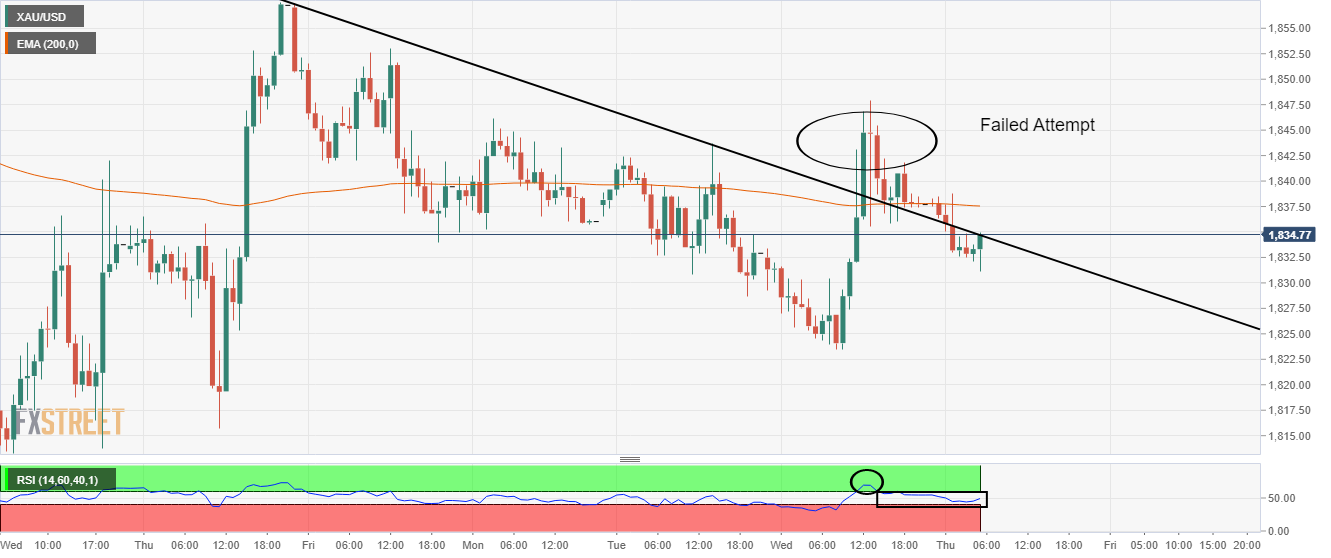
- EUR/USD remains sidelined after refreshing fortnight high the previous day.
- Recession woes mount in the Eurozone as Germany fears maintenance shutdown of Russian gas pipeline.
- Softer US inflation expectations, Fed Chair Powell’s Testimony put a floor under the prices.
- Sluggish session ahead of June’s PMI, Powell’s Testimony 2.0 challenges momentum traders.
EUR/USD lacks momentum strength as it takes round to 1.0560-70 heading into Thursday’s European session. The major currency pair’s latest inaction could be linked to the mixed catalysts surrounding the Eurozone and the US.
Starting with the bloc, economic slowdown fears mount in the old continent as Russia braces for a maintenance halt in the gas pipeline to Germany. It should be noted, however, that the Reuters poll suggesting the European Central Bank’s (ECB) 0.75% rate hike in 2022 challenges the pair’s downside move.
On other hand, a four-month low in the US inflation expectations and Fed Chair Jerome Powell’s Testimony in favor of the current monetary policy propel EUR/USD prices.
That said, the US inflation expectations, as per the 10-year breakeven inflation rate per the St. Louis Federal Reserve (FRED) data, dropped for the third consecutive day to the fresh low since late February, at 2.54%, by the end of Wednesday’s North American session. On the other hand, Fed’s Powell considered the present monetary policy bias appropriate to battle the inflation woes. It’s worth noting, however, that the Fed Boss’s readiness to use the aggressive measures, irrespective of their consequences, seemed to have put a floor under the greenback. On the same line is the latest news from Reuters signaling an upbeat print of June’s jobs report.
Elsewhere, a lack of moves in the bond markets, as well as by the stock futures, also restricts immediate EUR/USD performance.
It’s worth noting that the EUR/USD traders should wait for the preliminary readings of the S&P Global PMIs for June, to be initially published for Germany before figures relating to the Eurozone and the US. Also important will be the second round of Fed Chair Jerome Powell’s Testimony.
Should the scheduled PMIs arrive as softer, the EUR/USD pair may have a reason to consolidate the latest gains. Further, Fed Chair Powell’s rejection of further rate hikes, other than what’s already known, could also weigh on the quote.
Also read: S&P Global US PMI June Preview: Waiting for recession
Technical analysis
EUR/USD defends the previous day’s breakout of the 10-DMA, the first since early June, which in turn keeps buyers hopeful. Additionally suggesting the quote’s further upside is the looming bull cross of the MACD.
With this, the EUR/USD buyers are all set to challenge the 1.0610 hurdle comprising the 50-DMA and the 21-DMA.
On the contrary, pullback moves remain elusive until the prices remain beyond the 10-DMA level of 1.0500.
FX Strategists at UOB Group Lee Sue Ann and Quek Ser Leang expect EUR/USD to keep the side-lined trading within the 1.0390-1.0650 range in the next weeks.
Key Quotes
24-hour view: “We highlighted yesterday that ‘bias for EUR is tilted to the downside but any weakness is unlikely to challenge 1.0470’. We did not expect the spike in volatility as EUR dropped briefly to 1.0467, snapped back up to 1.0605 before easing off. Upward momentum is beginning to build and there room for EUR to retest the 1.0605 level. For today, the major resistance at 1.0650 is not expected to come under threat. On the downside, a breach of 1.0515 (minor support is at 1.0540) would indicate that the build-up in upward momentum has fizzled out.”
Next 1-3 weeks: “There is not much to add to our update from yesterday (22 Jun, spot at 1.0530). As highlighted, EUR is still consolidating and is likely to trade within a range of 1.0390/1.0650 for now.”
- AUD/USD remains depressed around intraday low, extending the previous week’s pullback towards monthly low.
- One-week-old trend line may offer intermediate support but the 0.6855 level is crucial for bears to watch.
- Convergence of 50-SMA, two-week-old resistance line challenge buyers.
AUD/USD holds lower ground near 0.6890 heading into Thursday’s European session. In doing so, the Aussie pair stretches the previous day’s losses towards the one-week-old support line amid bearish MACD signals.
It’s worth noting, however, that an upward sloping trend line from May 12, near 0.6855, appears a tough nut to crack for the AUD/USD sellers.
Should the quote drop below 0.6855, the yearly low marked in May, around 0.6830, will quickly return to the charts.
Following that, the 61.8% Fibonacci Expansion (FE) level of June 03-16 moves, near the 0.6800 round figure, will challenge the AUD/USD bears.
Meanwhile, the 50-SMA and a fortnight-long resistance line together restrict the Aussie pair’s short-term recovery around 0.6950-55.
In a case where AUD/USD rises past 0.6955, the odds of witnessing an upswing towards the mid-month peak surrounding 0.7070 can’t be ruled out. During the run-up, the 0.7000 threshold may offer an intermediate halt to the bulls.
Overall, AUD/USD bears attack short-term key supports but a lack of downside room might challenge the pair’s further declines.
AUD/USD: Four-hour chart
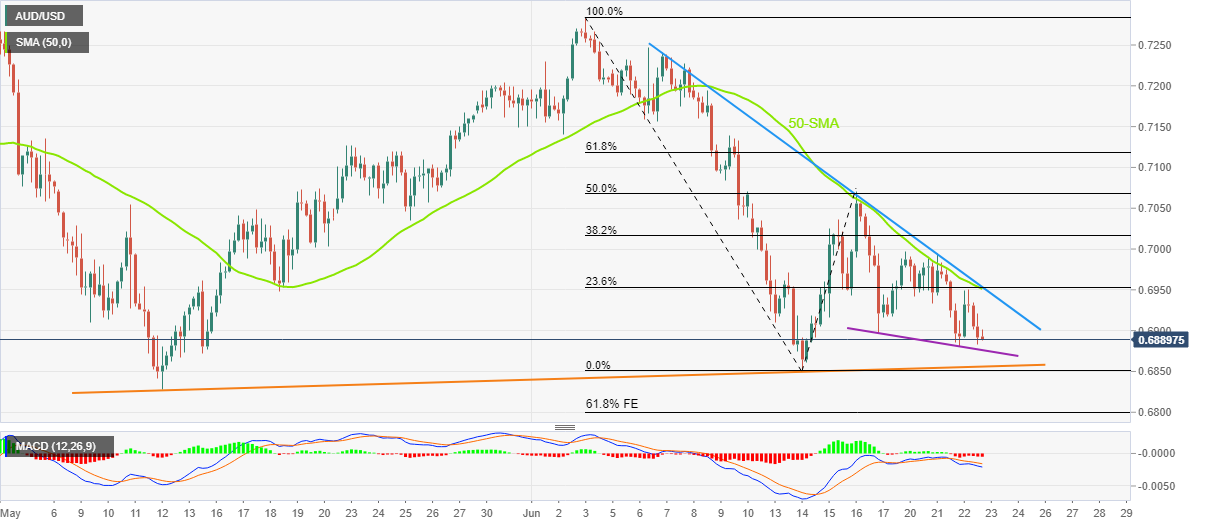
Trend: Further downside expected
- Steel prices have witnessed a steep fall after a three-day consolidation.
- Oversupply of steel has pushed the steel prices to four-month lows.
- Zero Covid-19 policy in China will keep the steel prices on the tenterhooks.
Steel prices have weakened further after a three-day consolidation on the Shanghai Futures Exchange. The asset has renewed its four-month lows as fears of overproduction of steel by China, the biggest consumer of building materials have escalated.
The zero-Covid policy by the Chinese administration has dented the demand for steel due to a halt in manufacturing activities. The Chinese economy is facing the headwinds of the resurgence in the Covid-19 pandemic. For the past three months, the Chinese manufacturing capacities are operating with extreme lockdown curbs. A strict restriction on the movement of men, materials, and machines has resulted in a serious fall in steel prices.
New data from Global Energy Monitor's Global Steel Plant Tracker states that the steel industry could face $518 billion in stranded asset risk as countries work towards meeting their long-term carbon neutrality commitments, if the 345.3 million tonnes per annum (mtpa) of emissions-heavy blast furnace basic oxygen furnace capacity (BF-BOF) proposed or under construction is fully developed, as per SME Times.
Earlier, supply constraints of steel were dictating the asset prices as most of the economies were committed to meeting their long-term goal of carbon neutrality commitments. Now, renewed demand worries in China due to the pandemic and heavy rains in some parts of China have pushed the steel prices significantly lower.
USD/CHF defends the previous day’s bounce off three-week low while picking up bids around 96.15 after declining for the last three consecutive days. Even so, the Swiss currency (CHF) pair remains lackluster heading into Thursday’s European session.
That said, the bullish bias in the options market seems to put a floor under the USD/CHF prices of late. The daily print of the one-month risk reversal (RR) of USD/CHF, a spread between the call and puts, rose to the highest levels in three days to 0.090 by the end of Wednesday’s North American session.
On the same line could be the hawkish comments from Swiss National Bank (SNB) Chairman Thomas Jordan. SNB’s Jordan said, “Inflation data shows they need to tighten monetary policy but noted that it was unclear when they would take that step, as reported by Reuters. SNB Chairman Jordan further added that they may need to raise rates again.
It’s worth noting, however, that the US dollar’s failure to benefit from Fed Chair Jerome Powell’s Testimony exerts downside pressure on the USD/CHF prices. That said, the US Dollar Index (DXY) drops for the fourth consecutive day as Fed’s Powell considered the present monetary policy bias appropriate to battle the inflation woes.
Also weighing on the USD/CHF prices could be the US inflation expectations, as per the 10-year breakeven inflation rate per the St. Louis Federal Reserve (FRED) data, which dropped for the third consecutive day to the fresh low since late February, at 2.54% by the end of Wednesday.
Also read: USD/CHF Price Analysis: Stability below inverted flag warrants downside to near 0.9450
- GBP/USD remains sidelined after bouncing off intraday low, maintains weekly inaction.
- UK politics, Brexit woes exert downside pressure amid BOE’s reluctance for heavy rate hikes.
- US dollar’s struggle probe pair bears amid a lackluster session.
- UK by-elections’ results, preliminary readings of June’s PMIs and Powell’s testimony 2.0 will be crucial.
GBP/USD struggles to extend the bounce off intraday low near 1.2250-60 heading into Thursday’s London open. In doing so, the Cable pair portrays the market’s inaction amid mixed concerns and anxious mood.
Increasing pessimism around UK PM Boris Johnson’s political position seems to exert downside pressure as Conservative leadership is at the test on Thursday due to the by-polls in Wakefield, West Yorkshire, and Tiverton and Honiton in Devon. “The Conservatives are braced to lose two parliamentary by-elections, according to senior party strategists, in moves that could prompt a renewed backlash against Boris Johnson,” per the Financial Times (FT). Additionally, fears that the UK’s Brexit will weigh on the British workers and fishers keep the GBP/USD at the lower grounds.
Elsewhere, the Bank of England’s (BOE) refrain from heavier rate hikes also challenges the GBP/USD buyers. On Wednesday, the UK Consumer Price Index (CPI) matched 9.1% YoY market forecasts for May, above 9.0% prior, which in turn cites inflation pressure in the UK.
Additionally, the latest news from Reuters signaling an upbeat print of June’s jobs report from the US also keeps the GBP/USD prices in the chain.
On the contrary, the four-month low inflation expectations in the US and Fed Chair Jerome Powell’s Testimony in favor of the current monetary policy propel the GBP/USD prices. That said, the US inflation expectations, as per the 10-year breakeven inflation rate per the St. Louis Federal Reserve (FRED) data, dropped for the third consecutive day to the fresh low since late February, at 2.54%, by the end of Wednesday’s North American session. On the other hand, Fed’s Powell considered the present monetary policy bias appropriate to battle the inflation woes. It’s worth noting, however, that the Fed Boss’s readiness to use the aggressive measures, irrespective of their consequences, seemed to have put a floor under the greenback.
Against this backdrop, the US 10-year Treasury yields remain pressured around 3.15%, after falling the most in one week the previous day, whereas the US stock futures print mild losses by the press time.
Given the recent inaction in the markets and cautious mood, the GBP/USD may grind lower ahead of the preliminary readings of the UK/US PMIs and second rounds of Fed Chair Powell’s testimony. That said, UK S&P Global/CIPS Manufacturing PMI is likely to ease to 53.7 from 54.6 while the Services PMI could recede to 53.0 versus 53.4. It’s worth noting that the likely downbeat PMIs could weigh on the cable prices.
Also read: S&P Global US PMI June Preview: Waiting for recession
Technical analysis
GBP/USD dribbles inside a 100-pip area comprising an upward sloping support line from last Thursday and a 12-day-old resistance line, respectively near 1.2180 and 1.2280. It’s worth noting that the sluggish RSI (14) weighs on the pair prices.
- Asian equities have rebounded firmly as Fed Powell’s testimony has underpinned dip-buying.
- Japan markets are underperforming on mixed PMI data.
- In today’s session, investors will keep an eye on the release of the US PMI.
Markets in the Asian domain have rebounded as dip-buying has kicked in after a bearish Wednesday. Asian equities have witnessed a responsive buying action, which dictates that the indices are extremely oversold and are a value-bet now.
At the press time, China A50 jumped 0.53%, Hang Seng gained almost 1%, and Nifty50 added 0.69% while Japan Nikkei225 eased 0.34%.
Federal Reserve (Fed) chair Jerome Powell’s testimony has infused fresh blood into the risk-perceived assets. Investors have ignored the hawkish guidance for July monetary policy but have focused on the statement that the US economy is strong enough to face the consequences of higher interest rates. Thanks to the upbeat growth prospects and tight labor market, which are acting as supportive catalysts for the Fed to tighten the policy without much hesitation.
The Japanese markets have diverged from the positive Asian indices amid mixed Purchase Managers Index (PMI) data. The Services PMI has landed at 54.2, significantly higher than the estimates and the prior print of 52.2 and 52.6 respectively. While the Manufacturing PMI has slipped to 52.7 from the consensus of 54.4 and the former figure of 53.3.
Going forward, investors’ focus will remain on the US PMI. As per the market consensus, the Manufacturing PMI is expected to slip to 56 from the prior print of 57. While the Services PMI may advance marginally to 53.5 from the former figure of 53.4.
- WTI remains on the back foot around six-week low.
- Upward sloping trend line from mid-March challenges further downside.
- 100-DMA, previous support line late 2021 guard recovery moves.
WTI crude oil prices keep the previous day’s downside break of the 100-DMA, despite bouncing off the three-month-old support line. That said, the black gold drops for the second consecutive day, down 1.0% around $102.90, amid early European morning on Thursday.
The energy benchmark is likely to decline further on the quote’s sustained break of the key DMA, as well as an upward sloping trend line from December 2021, not to forget the bearish MACD signals.
However, a clear downside break of the three-month-old support line, near $101.00 by the press time, appears necessary for the bears.
Following that, the $100.00 psychological magnet and lows marked during April and March, respectively around $92.65 and $92.35, will be important to watch.
On the flip side, the 100-DMA and the aforementioned support-turned-resistance line from 2021, close to $104.40 and $106.80, will challenge WTI’s short-term recovery.
In a case where the oil buyers manage to cross the $106.80, an upward trajectory towards late March’s high near $115.90 can’t be ruled out. Though, tops marked during mid-May around $113.20 and the $110.00 round figure may probe the WTI bulls during the run-up.
WTI: Daily chart
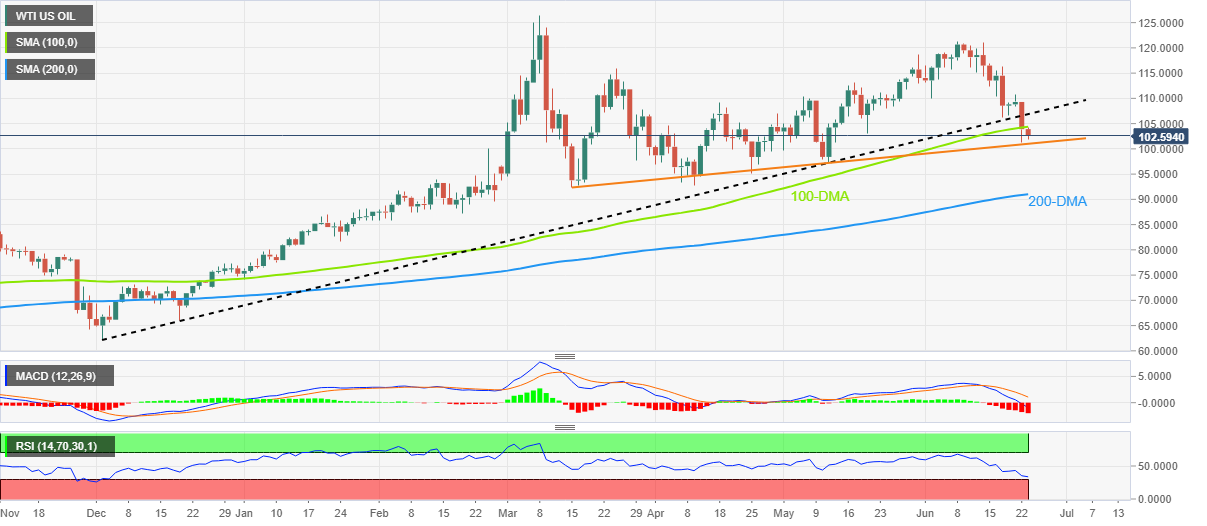
Trend: Limited downside expected
- USD/INR is aiming to recapture its all-time highs at 78.46 as odds of a bumper rate hike by the Fed escalate.
- The Fed is committed to bringing price stability to the US economy sooner.
- Oil prices have fallen like a house of cards on escalating recession fears.
The USD/INR pair is attempting to create a base in a range of 78.20-78.25 after a mild correction from its all-time-highs at 78.46. Considering the overall bullish structure, the asset is expected to recapture its all-time highs. A hawkish guidance from Federal Reserve (Fed) chair Jerome Powell’s testimony on interest rate projections in July monetary policy has underpinned the greenback against the Indian rupee.
Fed Powell in his testimony dictated that the central bank is ‘strongly committed to bringing price stability, which clearly states that the rate hike extent announced in June could repeat in July too. The Fed has already elevated its interest rates to 1.50-1.75% after announcing the biggest rate hike of 75 basis points (bps) in the past 28 years. Despite that, the inflation rate has not portrayed any pause signals yet. What was music to the ears was that the US economy is rock solid, taking into account the resilient demand and tight labor market, which is efficient to face the headwinds of higher interest rates.
On the oil front, falling oil prices are expected to provide support to the Indian rupee in the near term. The black gold has remained in the grip of bears on advancing odds of a recession in the world economy. Demand is what matters most for the oil prices rather than the supply. One could easily identify this fact by noting the momentum of oil price rise while supply constraints due to the ban of Russia were underpinned by the current fall due to recession fears.
- USD/JPY pares intraday losses during the two-day pullback from 24-year high.
- Foreign investors wager against Japanese Government Bonds (JGB) but domestic buyers weigh on yields.
- Mixed Japan PMI for June also exerts downside pressure, along with BOJ-linked chatters.
- US PMIs for June, Powell’s Testimony 2.0 will be important catalysts.
USD/JPY licks its wounds near intraday low, at 135.50 during Thursday’s European morning. The yen pair’s latest weakness could be linked to the mixed PMI data from Japan, as well as on chatters that the Bank of Japan’s (BOJ) Yield Curve Control (YCC) policy is under threat.
Japan’s Jibun Bank Manufacturing PMI eased to 52.7, below 54.4 expected and 53.3 prior, whereas the Services counterpart rose past 52.2 forecasts and 52.6 previous readouts to 54.2.
It’s worth noting that the downbeat performance of the US Treasury yields, recently pressured around 3.15%, also weighs on the USD/JPY prices. It should be noted that the US 10-year Treasury yields dropped the most in one week the previous day, poking the fortnight low of late.
Elsewhere, the Financial Times (FT) portrayed challenges to the BOJ’s status quo by citing the exodus of foreign investors from the Japanese bond markets. “Foreign fund managers’ renewed enthusiasm for wagers against Japanese government bonds — a trade that has backfired so frequently over the past two decades it earned the nickname ‘widow-maker’ — also puts them at odds with the majority of Japanese investors who think the BoJ will stick to its guns despite the collapse of the yen to a 24-year low,” said the FT.
It’s worth noting that four-month low inflation expectations in the US and Fed Chair Jerome Powell’s Testimony in favor of the current monetary policy also weigh on the USD/JPY prices. That said, the US inflation expectations, as per the 10-year breakeven inflation rate per the St. Louis Federal Reserve (FRED) data, dropped for the third consecutive day to the fresh low since late February, at 2.54%, by the end of Wednesday’s North American session. On the other hand, Fed’s Powell considered the present monetary policy bias appropriate to battle the inflation woes. It’s worth noting, however, that the Fed Boss’s readiness to use the aggressive measures, irrespective of their consequences, seemed to have put a floor under the greenback. On the same line is the latest news from Reuters signaling an upbeat print of June’s jobs report.
To sum up, the market’s inaction, mostly sluggish performance, keeps the USD/JPY on thin ice ahead of US S&P Global PMIs for June and the second round of Fed Chair Jerome Powell’s Testimony.
Technical analysis
Although overbought RSI conditions and bearish spinning top favor USD/JPY sellers, multiple supports around 134.50 restricts the short-term downside of the yen pair.
- Gold takes offers to refresh intraday low inside weekly symmetrical triangle.
- Fears of economic slowdown, monetary policy aggression weigh on prices amid a sluggish session.
- Concerns surrounding the US-China trade deal, Beijing’s economic growth also exert downside pressure.
- US PMIs, the second round of Fed Chair Powell’s testimony eyed for fresh impulse.
Gold Price (XAU/USD) renews intraday low around $1,832 as fears of economic slowdown join inflation woes to weigh on the metal prices amid a sluggish Asian session on Thursday. In doing so, the bullion stays on the way to the second consecutive weekly loss even as the US dollar fails to improve.
That said, the US Dollar Index (DXY) prints a four-day downtrend as Fed Chair Jerome Powell considered the present monetary policy bias appropriate to battle the inflation woes. It’s worth noting, however, that the Fed Boss’s readiness to use the aggressive measures, irrespective of their consequences, seemed to have put a floor under the greenback. On the same line is the latest news from Reuters signaling an upbeat print of June’s jobs report.
It’s worth noting that a slump in the US inflation expectations to the four-month low also drowns the greenback. That said, the US inflation expectations, as per the 10-year breakeven inflation rate per the St. Louis Federal Reserve (FRED) data, dropped for the third consecutive day to the fresh low since late February by the end of Wednesday’s North American session. That said, the inflation gauge’s latest print is 2.54%, the same as on February 25.
Elsewhere, a Reuters poll suggesting faster European Central Bank (ECB) rate hikes, to 0.75% by the year’s end, also challenge the gold prices. Additionally, the fall in the options market’s bullish bias over Gold Price, known as the risk reversal (RR), exerts downside pressure on the metal. That said, the spread between the call and put options, known as RR, dropped to the lowest levels in a week the previous day.
It should be noted, that the Fed and ECB aggression propel the market’s economic slowdown fears amid fragile activities.
Additionally, chatters that China President Xi Jinping may not be able to reach the optimistic growth targets, as well as the likely failures of the Sino-American trade talks, seem to weigh on the XAU/USD as well.
That said, S&P 500 Futures struggle for clear directions while US 10-year Treasury yields remain pressured around the weekly low, down 2.8 basis points to 3.13% by the press time.
Moving on, US S&P Global PMIs for June and the weekly Jobless Claims data will precede the second round of Fed Chair Jerome Powell’s Testimony will be important to watch for clear market directions.
Technical analysis
Gold extends pullback from the 200-SMA inside a one-week-old symmetrical triangle. The metal’s sidelined performance also gains support from steady RSI.
Hence, XAU/USD is likely declining towards the aforementioned triangle’s support line, around $1,825 by the press time.
However, the quote’s weakness past $1,825 will be challenged by an upward sloping support line from mid-May, around $1,809, as well as the $1,800 threshold.
On the contrary, recovery moves remain elusive until crossing the stated triangle’s resistance line, close to $1,847 at the latest. It’s worth noting that the 200-SMA level of $1,842 could guard the immediate rebound.
In a case where the bullion prices rally beyond $1,847, multiple hurdles around $1,870 could test the XAU/USD bulls before directing them to the monthly peak of $1,879.
Gold: Four-hour chart

Trend: Limited downside expected
- A Darvas Box formation is indicating a volatility contraction in the asset.
- The RSI (14) is attempting to shift into the bullish range of 60.00-80.00.
- The shared currency bulls have defended the 20-EMA confidently.
The EUR/USD pair is displaying a sideways move after a minor correction from the round-level resistance of 1.0600. On a broader note, the asset is auctioning in a range of 1.0444-1.0601 from the last week after witnessing a responsive buying action below 1.0400.
The asset is forming a Darvas Box on the hourly scale, which signals for a volatility contraction that is followed by an expansion in the same. A responsive buying action from July 16 low at 1.0384 is favoring an upside break of the volatility contraction.
The asset is comfortably holding itself above the 200-period Exponential Moving Average (EMA) at 1.0534, which underpins the shared currency bulls against the greenback. Also, the eurozone bulls have defended the 20-period EMA at 1.0558, which showcases their strength.
Meanwhile, the Relative Strength Index (RSI) (14) is attempting to shift into a bullish range of 60.00-80.00, which will strengthen the shared currency bulls further.
Should the asset decisively oversteps Wednesday’s high at 1.0606, a Darvas Box breakout will activate the bulls, which will drive the asset towards July 7 low at 1.0652. A breach of the latter will direct the eurozone bulls towards July 6 high at 1.0752.
Alternatively, the greenback bulls could regain their strength if the asset drops below Friday’s low at 1.0444. This will drag the asset towards June 14 low at 1.0397, followed by June 15 low at 1.0359.
EUR/USD hourly chart
Takehiko Nakao, a former Japanese Vice Finance Minister for International Affairs, warned in a statement on Thursday, the current weak yen is detrimental to the economy.
USD/JPY witnessed a fresh sell-off in the last hour, as some stops seemed to have triggered following a break below 135.50. Meanwhile, the return of risk-off flows also lifted the demand for the safe-haven yen. The pair is almost 100-pips down from its daily high of 136.27, currently trading at 135.40, down 0.63% on the day. The daily low was clocked at 135.15.
- AUDUSD returns to the red after the early recovery to near 0.6930.
- Recession fears revive the dollar’s safe-haven demand, as Powell disappoints.
- Daily technical setup risks a test of the critical support at 0.6855.
AUDUSD is trading close to 0.6900, having failed to sustain the tepid bounce near the 0.6930 region. The US dollar is seeing a fresh demand on the return of risk-off flows in Thursday’s Asian trading, as investors remain worried about a looming risk of a global recession.
Fed Chair Jerome Powell showed the central bank’s commitment to fighting inflation, which caused the market to believe that the aggressive Fed’s tightening stance could tip the US economy into a recession. Further, the ongoing Ukraine war and China’s covid lockdowns are likely to keep the pressure up on inflation, and therefore, would compel global central bankers to act firmly to combat it.
Meanwhile, amidst a dire global economic outlook, bulls are unable to capitalize on the expectations that the RBA will deliver bigger and more rapid rate increases. Attention once again turns towards the second day of Powell’s testimony for further clarity on the rate hike track. The US business PMI reports will be also closely examined.
From a short-term technical perspective, AUDUSD is heading back towards the previous day’s low of 0.6880, which if taken out on a sustained basis will open floors towards the rising trendline support at 0.6855.
A sharp sell-off below the latter cannot be ruled out, with sellers setting their eyes on the May 12 low of 0.6828.
The 14-day Relative Strength Index (RSI) is pointing south below the midline, backing the downside bias.
AUD/USD: Daily chart
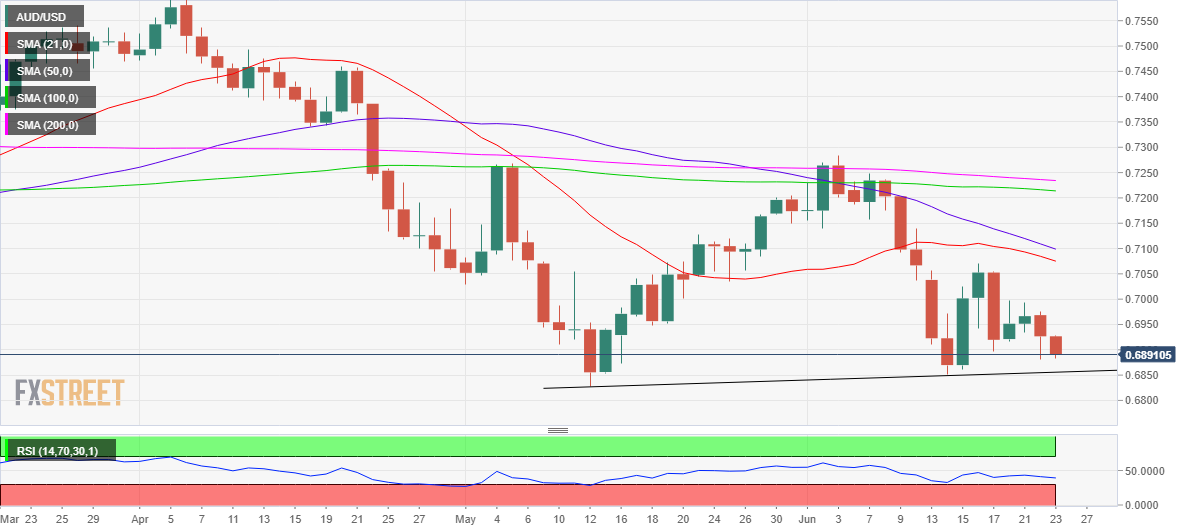
Alternatively, AUD bulls need to crack the daily highs at 0.6929 to initiate any meaningful recovery towards the 0.6950 psychological level.
Daily closing above the aforesaid resistance will put the focus back on the 0.7000 supply zone.
AUD/USD: Additional levels to consider
- Copper prices have renewed their 15-months low at $3.86 on advancing recession fears.
- More policy tightening measures by the central banks will shrink the aggregate demand.
- The resurgence of Covid-19 in China is impacting their manufacturing sector and henceforth the copper demand.
Copper, prices on COMEX, have witnessed a steep fall in the Asian session. The base metal has surrendered the potential cushion of $3.90 and has renewed its 15-month low at $3.86. The asset is declining firmly and is expected to find a cushion much lower.
The policy tightening approach adopted by the Western leaders to fix the inflation mess has brought a significant fall in the asset. The inflation rate is advancing at a runaway pace and central banks are featuring rate hikes to tighten their grip on the injection of liquidity into the economy. The unavailability of helicopter money into the economy along with costly funds will force the corporate sector to put more filters on their investment plans. More filters on the investment projects will leave few investment plans for the corporate and therefore a slippage in the demand for copper.
Meanwhile, the zero-Covid policy in China has raised concerns over the demand for copper. The Chinese economy is fighting the resurgence of Covid19 for the past three months. This has brought a major drop in manufacturing activities. It is worth noting that China consumes more than 50% of the total copper production and a slump in China’s demand has a significant impact on the copper prices.
On the dollar front, the US dollar index (DXY) is holding itself above 104.00 on growing expectations of one more 75 basis points (bps) rate hike by the Federal Reserve (Fed) in July. Fed chair Jerome Powell in his testimony on Wednesday has cleared that bringing price stability is their top priority and June’s rate hike extent could be repeated in July.
In a keynote speech to a virtual BRICS Business Forum on Wednesday, Chinese President Xi Jinping vowed to meet economic targets for the year despite the country battling with the covid outbreaks and a weak housing market.
Key quotes
China will “strengthen macro-policy adjustment and adopt more effective measures to strive to meet the social and economic development targets for 2022 and minimize the impacts of Covid-19.”
“China’s approach to fighting Covid not only protected people’s lives and health, but also stabilized the fundamentals of economic and social development as much as possible.”
Market reaction
Despite the optimism from the Chinese leader, AUD/USD remains unimpressed, as recession fears overwhelm the market. The pair was last seen trading down 0.56% on the day at 0.6887.
| Raw materials | Closed | Change, % |
|---|---|---|
| Brent | 110.21 | -3.73 |
| Silver | 21.418 | -1.18 |
| Gold | 1838.25 | 0.31 |
| Palladium | 1860.91 | -0.55 |
- USD/CAD picks up bids to refresh intraday high, keeps the previous day’s rebound.
- Bearish MACD signals, short-term horizontal resistance challenge buyers.
- One-week-old support line also restricts immediate downside before the mid-month low.
USD/CAD stays on the front foot for the second consecutive day, refreshing intraday high around 1.2970 during Thursday’s Asian session.
In doing so, the Loonie pair extends the previous day’s rebound from the 50-SMA towards a one-week-old descending resistance line.
However, a horizontal area comprising multiple levels marked since the previous Wednesday joins the bearish MACD signals to challenge the pair’s upside around 1.3000 psychological magnet.
Should the quote rises past 1.3000, the double tops around the monthly peak of 1.3078 will be crucial to watch.
Meanwhile, the 50-SMA and a weekly support line restrict immediate pullbacks of the USD/CAD pair, respectively near 1.2940 and 1.2925.
In a case where USD/CAD breaks the 1.2925 support, the bears could aim for the multiple lows marked during mid-June surrounding 1.2860.
It’s worth noting, however, that the pair’s weakness past 1.2860 will make it vulnerable to decline further towards the monthly low of 1.2517.
To sum up, USD/CAD is likely to extend the latest recovery but the upside room is limited.
USD/CAD: Four-hour chart
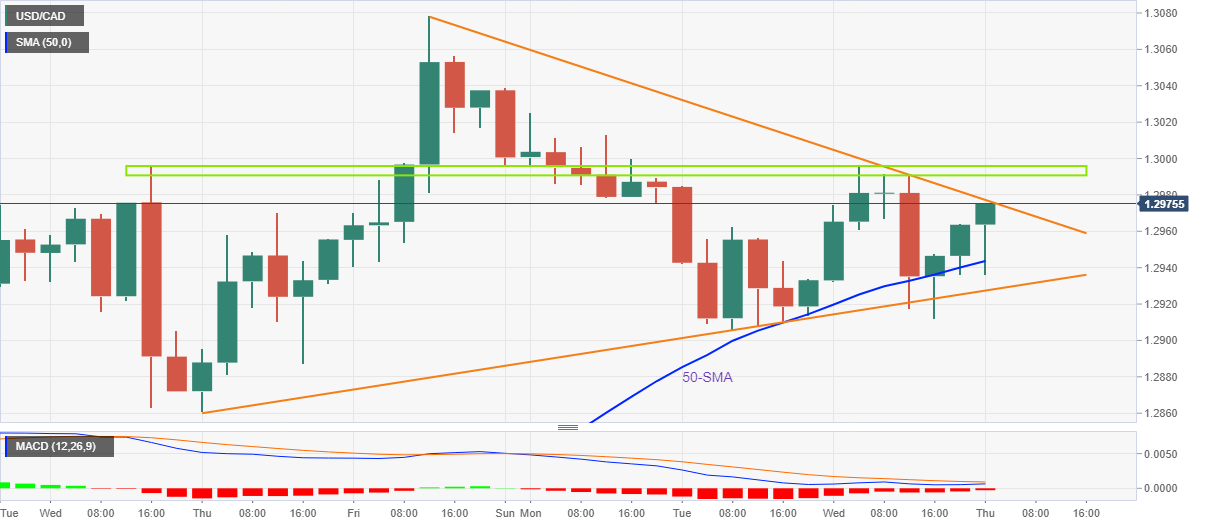
Trend: Limited upside expected
- NZD/USD bears home in on the 0.6250s demand area.
- Bulls are lurking below spot with their sights on the 0.6340s.
As per the prior analysis from earlier on Wednesday, NZD/USD Price Analysis: Bulls lurking near 0.6250, rallies to 0.6340 eyed, the bird has fallen out of the sky but could be destined for a soft landing in the 0.6250s.
NZD/USD prior analysis

In the 1-hour chart above, it was explained that there was ''a recent break of structure to the upside.'' It stated that ''should the price fail to move higher from the 38.2% Fibo area near 0.6280, then there is a higher probability that the price imbalance between 0.6270 and 0.6261 will be mitigated which guards the mid point of the demand area, or order block (OB) at 0.6252.''
On the flip side, it was argued that ''this would be expected to result in a flurry of bids and a subsequent run towards liquidity towards 0.6340.''
NZD/USD live market

Progress has been made towards the demand area with a low of 0.6259 printed so far.
US inflation expectations, as per the 10-year breakeven inflation rate per the St. Louis Federal Reserve (FRED) data, dropped for the third consecutive day to the fresh low since late February by the end of Wednesday’s North American session. That said, the inflation gauge’s latest print is 2.54%, the same as on February 25.
The US dollar seems to bear the burden of the latest reduction in the inflation expectations as it remains pressured around 104.20 following a three-day downtrend. With this, the greenback gauge also braces for the first weekly loss in four.
It’s worth noting that Fed Chair Jerome Powell has also shown readiness for higher rates but highlighted the data-dependency for the out-of-the-box lift in the benchmark rates. The same appears to have exerted downside pressure on the US Treasury yields and allowed equities to consolidate losses.
That said, S&P 500 Futures struggle for clear directions while US 10-year Treasury yields remain pressured around the weekly low, down 2.8 basis points to 3.13% by the press time.
Looking forward, US S&P Global PMIs for June and the weekly Jobless Claims data will precede the second round of Fed Chair Jerome Powell’s Testimony will be important to watch for clear market directions.
Also read: US Dollar Index stays pressured around 104.00 as Fed’s Powell lacks aggression, US PMI eyed
South Korea's Finance Minister Choo Kyung-ho came out with verbal intervention on Thursday, noting that they “will work to minimize adverse impact from weakening won.”
He said that they “will announce measures to stabilize FX market if needed.”
Market reaction
The talking up of the South Korean won by the South Korean authorities briefly helped the beleaguered currency, as USD/KRW dropped from daily highs of 1,302.79. At the time of writing, the pair is trading at 1,300, up 02.17% on the day.
The won tumbled below the 1,300 mark vs. the US dollar for the first time in 13 years amid looming global recession worries.
- GBP/USD fades bounces off intraday low, stays pressured around weekly bottom.
- Fortnight-old resistance line, 100-EMA guard immediate run-up, RSI hints at sideways grind.
- Weekly support line restricts downside targeting yearly low.
GBP/USD licks its wounds around 1.2250 while fading the recent bounce off intraday low during Thursday’s Asian session. Even so, the cable pair remains pressured below the short-term key resistances.
In addition to the nearby hurdles, sluggish RSI (14) also weighs on the GBP/USD prices. However, an upward sloping support line from last Thursday, near 1.2180, puts a floor under the pair.
That said, a 12-day-old resistance line, at 1.2280 by the press time, guards the Cable pair’s immediate upside ahead of the 100-EMA level near 1.2330. Following that, the mid-June peak surrounding 1.2410 could lure the bulls.
It’s worth noting that there are multiple hurdles surrounding 1.2430 and 1.2470 that could challenge GBP/USD bulls past-1.2410.
Meanwhile, a downside break of the 1.2180, could avail the 1.2100 and the 1.2000 round figures as intermediate halts during the south run targeting the yearly low of 1.1933.
In a case where the GBP/USD bears dominate past 1.1933, the year 2016 low near 1.1900 may act as the last defense of the buyers before directing the quote to March 2020 bottom surrounding 1.1410.
Overall, GBP/USD is likely to extend the bearish grind towards the latest trough.
GBP/USD: Four-hour chart
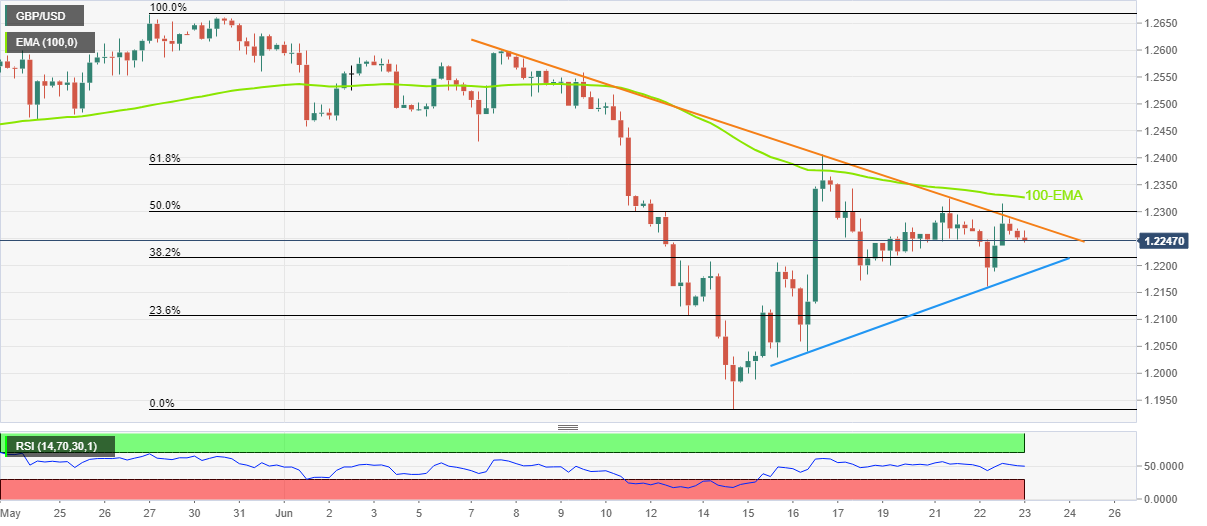
Trend: Bearish
- USD/JPY bulls have thrown in the towel again and the focus is on a test of 135 the figure.
- Bears are moving in on the 135.80 psychological support.
As per the prior multi-timeframe analysis from the Tuesday New York session, USD/JPY Price Analysis: Bears are lurking and a significant correction could be on the cards, a topping formation was highlighted on the 5-min chart:
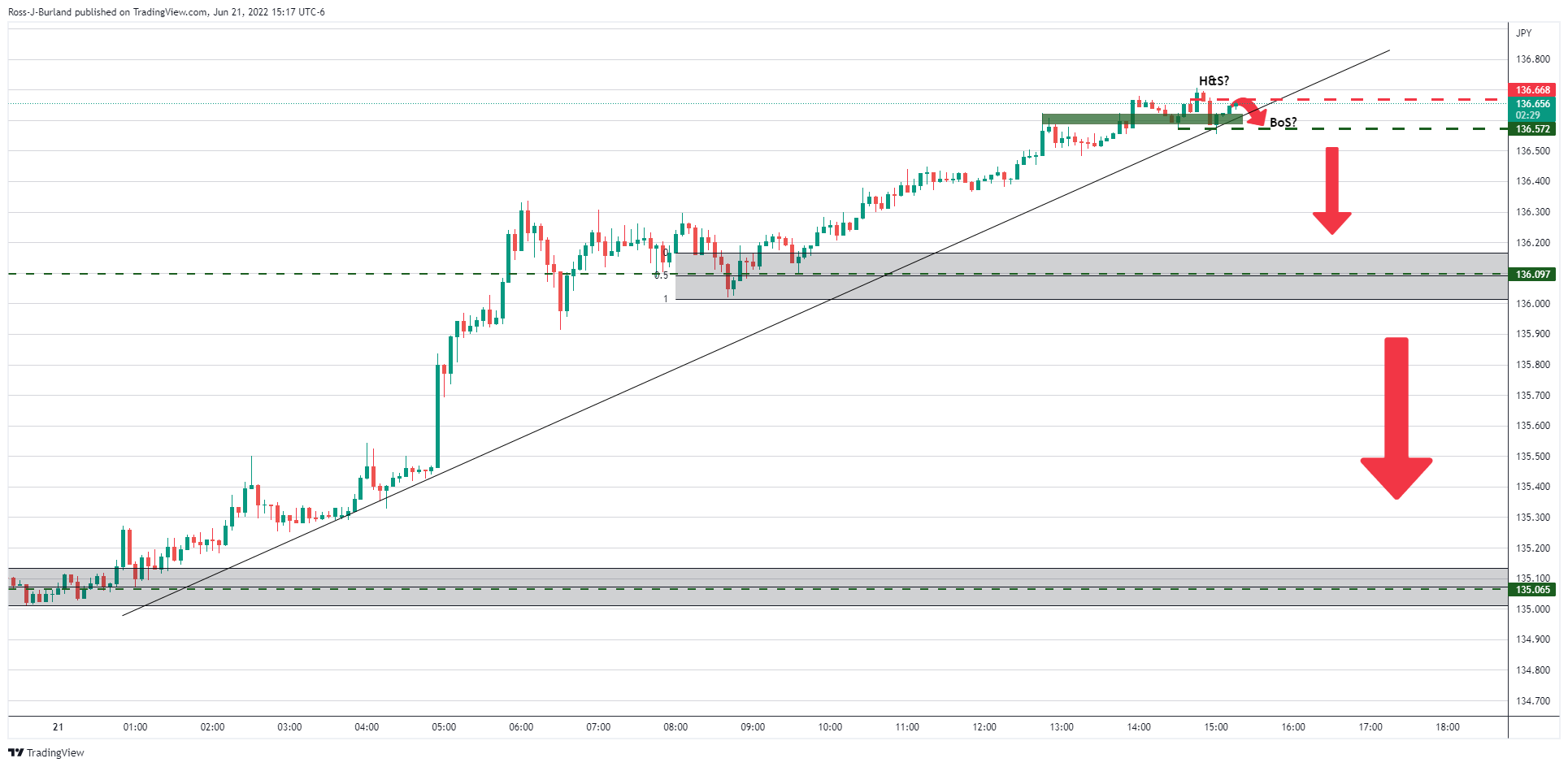
The price subsequently melted and the bear's committed to the M-formation on the 10-min chart as illustrated in the prior analysis:
If the bears commit at this juncture, then the 36.2% Fibo may be confirmed as a strong enough correction:
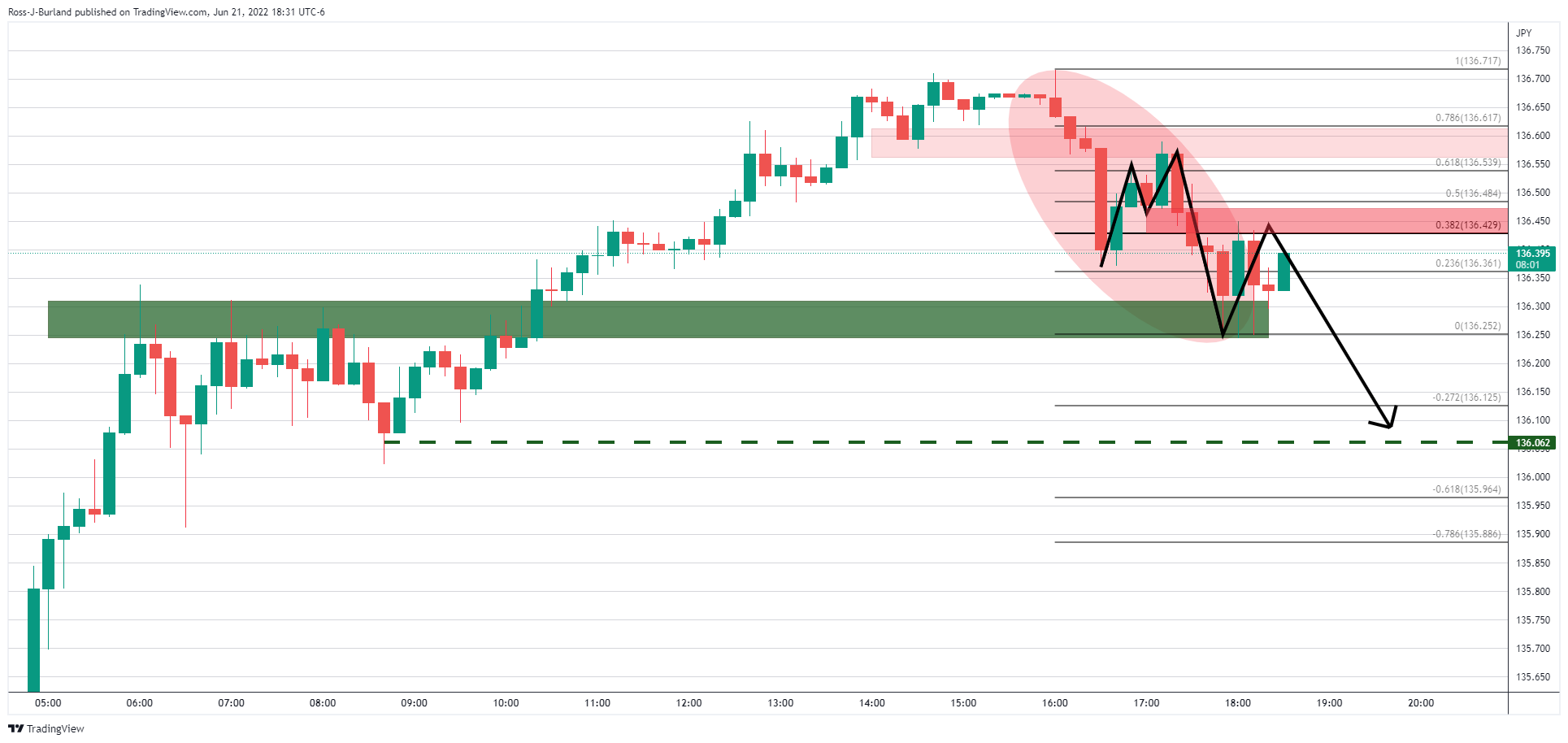
The 10-min chart's M-formation's neckline aligns with the Fibo, offering additional conviction to the downside case.
USD/JPY live market update
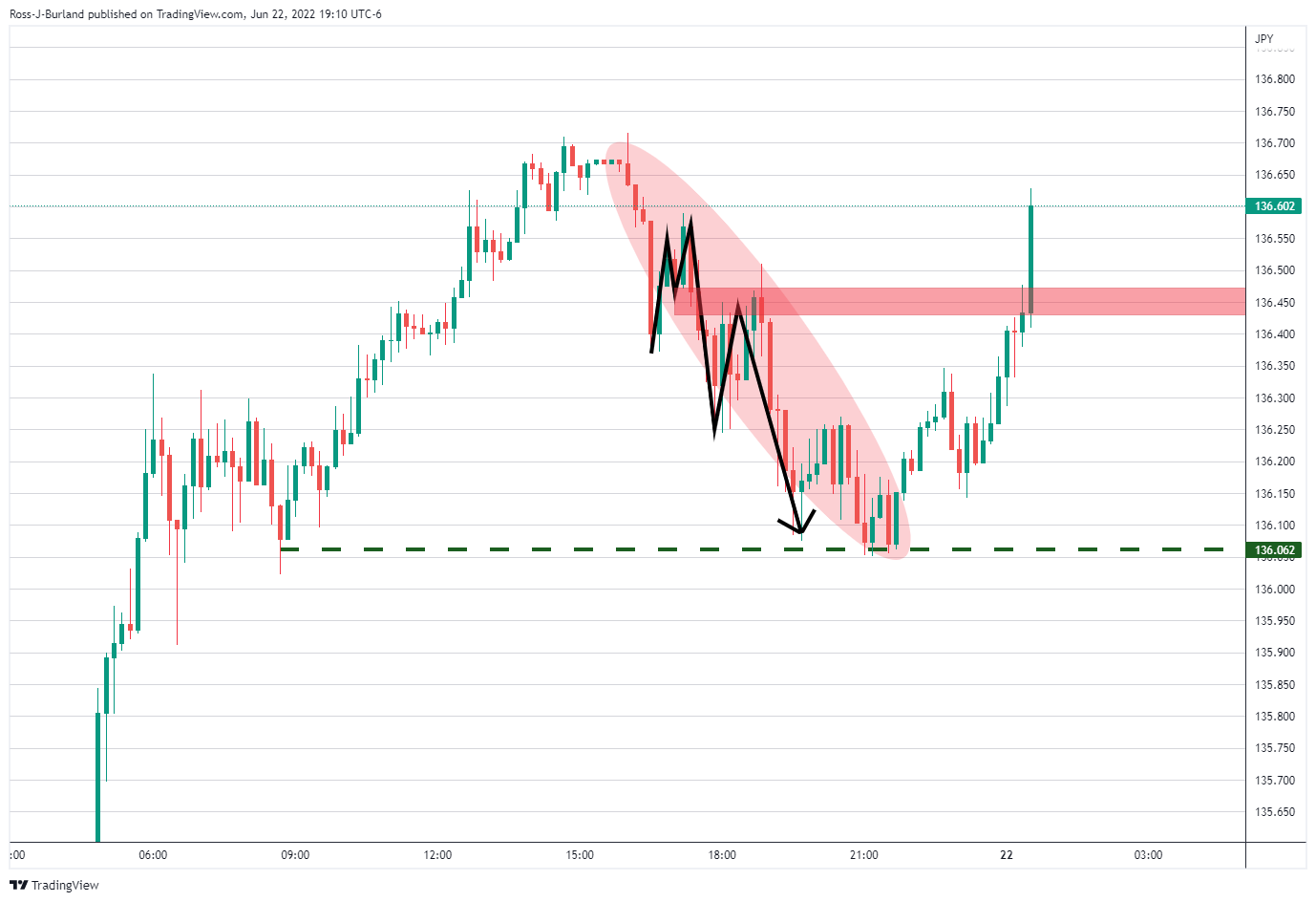
As illustrated, the price moved in for an accurate test of the target and surged higher from there before melting once again to print fresh lows of 135.68 which leaves lower levels, 135.00/10, as per the original analysis, on the cards for the sessions ahead:

The price is on the path to mitigating the price imbalance as illustrated don the hourly chart above, (PI) and thereafter, the demand area or order block, (OB) could be in the runnings for a test which exposes the risk of a break of the 135 psychological level if bulls do not commit. However, so long as they do, then the upside is still to play for longer-term.
In recent trade today, the People’s Bank of China (PBOC) set the yuan (CNY) at 6.7079 vs. the estimated 6.7046 and the previous 6.7109.
About the fix
China maintains strict control of the yuan’s rate on the mainland.
The onshore yuan (CNY) differs from the offshore one (CNH) in trading restrictions, this last one is not as tightly controlled.
Each morning, the People’s Bank of China (PBOC) sets a so-called daily midpoint fix, based on the yuan’s previous day's closing level and quotations taken from the inter-bank dealer.
- AUD/USD bounces off intraday low, stays around weekly bottom.
- Market sentiment dwindles amid confusion over Fed Powell’s testimony and recent fears surrounding recession.
- Aussie PMIs came in mixed for June but support the RBA’s hawkish bias.
- US preliminary PMIs for June, the second round of Powell’s testimony eyed for fresh impulse.
AUD/USD consolidates recent losses around the weekly low during Thursday’s Asian session. In doing so, the Aussie pair picks up bids from intraday bottom to 0.6920 by the press time.
The Aussie pair’s latest rebound could be linked to the US dollar’s retreat amid chatters surrounding no major deviation in the Fed’s monetary policy path versus already known. It’s worth noting that Aussie PMIs also put a floor under the AUD/USD prices earlier in the day.
Preliminary readings of Australia’s S&P Global PMIs for June came in mixed as the Manufacturing and Services PMIs rose past market forecasts and priors but the Composite PMI eased below the previous readouts. The Manufacturing PMI rose to 55.8 versus 54.7 expected and 55.7 prior whereas the S&P Global Services PMI rose past 49.1 market consensus to 52.6, versus 53.2 previous readings. It should be noted that the Composite PMI eased below 52.9 to 52.6 in June.
Elsewhere, US Dollar Index (DXY) fades bounce off the weekly low as sellers flirt with 104.10 of late. Federal Reserve (Fed) Chairman Jerome Powell’s justification for the recent rate hike, the biggest since 1994, managed to gain acceptance, at least during the first round of the Testimony on the bi-annual Monetary Policy Report. However, Powell’s rejection of the need for a heavy rate increase seemed to exert downside pressure on the greenback afterward.
Additionally, the latest weakness in commodity prices, especially the oil prices and recently downbeat US data could also be linked to the AUD/USD pair’s latest recovery. That said, WTI crude oil prices dropped 0.85% to $103.50, down for the second consecutive day around the lowest levels in six weeks. The black gold’s latest weakness could be linked to the bearish weekly inventory data from the American Petroleum Institute (API). Furthermore, talks that US President Joe Biden will announce gas tax relief by the end of the week also weighed on the oil prices.
It’s worth observing that the latest US figures concerning housing and activities have been softer for May, which in turn eases the pressure on the Fed to tame inflation.
Alternatively, fears of higher US employment data for June, spread by Reuter’s piece, seem to challenge AUD/USD bulls. The news said, “An early look at the state of the US job market in June from payroll provider UKG suggests some strengthening, even as the Federal Reserve lifts interest rates sharply and economists raise alarms over the likelihood of a recession. On the same line is Reuters’ poll suggesting ECB’s rate hikes to 0.75% by the end of 2022, versus 0.0% at the latest.
Against this backdrop, S&P 500 Futures struggle for clear directions while US 10-year Treasury yields remain pressured around the weekly low, down 2.8 basis points to 3.13% by the press time.
Moving on, US S&P Global PMIs for June and the weekly Jobless Claims data will precede the second round of Fed Chair Jerome Powell’s Testimony will be important for the AUD/USD traders to determine short-term moves. However, major attention will be given to recession fears.
Technical analysis
AUD/USD remains sidelined between a six-week-old support line and a downward sloping resistance trend line from June 08, respectively near 0.6880 and 0.6955.
- A double top formation has paused the juggernaut eurozone bulls rally for a while.
- The bearish negative divergence is hinting at exhaustion in the uptrend.
- The 50- and 200-period EMAs are still advancing, which adds to the upside filters.
The EUR/JPY pair has rebounded firmly after a downside move to near 143.52 in the Asian session. It looks like that the cross witnessed a minor correction after sensing exhaustion in the upside rally.
On an hourly scale, the asset has witnessed selling pressure after re-testing its previous highs at 144.25, recorded earlier on June 8. This resembles a double top formation, which indicates a minor pause in the uptrend but needs more filters for claiming it as a bearish reversal.
Also, the cross has displayed a bearish negative divergence while testing its previous highs in which the asset forms a higher high while the momentum oscillator records a lower high. The Relative Strength Index (RSI) (14) has displayed a bearish negative divergence that signals a loss of the upside momentum.
The 50- and 200-period Exponential Moving Averages (EMAs) at 141.90 and 143.28 are advancing, which favors a bullish bias.
A decisive move above June 8 high at 144.25 will negate the double top formation, which will drive the asset towards the 5 January 2015 high at 144.61, followed by the 23 December 2013 high at 145.70.
Alternatively, the yen bulls could regain strength if the asset drops below Wednesday’s low at 142.68. This will drag the asset towards Tuesday’s low at 141.95. A violation of Tuesday’s low will expose the asset to more downside towards June 15 high at 141.50.
EUR/JPY hourly chart
-637915430990114713.png)
- Gold fades bounce off weekly low, takes offers to refresh intraday low.
- Market sentiment dwindles after Fed’s Powell defends current monetary policy outlook.
- Yields remain pressured, stock futures print mild losses amid lack of clarity.
- Powell’s Testimony 2.0, US PMIs for June will be important to watch for fresh impulse.
Gold Price (XAU/USD) remains on the back foot, reversing the previous day’s rebound from the weekly low, as traders await fresh clues during Thursday’s Asian session. That said, the yellow metal renews intraday low around $1,835 by the press time.
Earlier in the day, Reuters said, “An early look at the state of the US job market in June from payroll provider UKG suggests some strengthening, even as the Federal Reserve lifts interest rates sharply and economists raise alarms over the likelihood of a recession.” The news seems to have exerted fresh downside pressure on gold prices.
That said, the precious metal’s latest losses could also be linked to the market’s reassessment of Fed Chair Jerome Powell’s Testimony on the bi-annual Monetary Policy Report, which took place on Wednesday. Federal Reserve (Fed) Chairman Jerome Powell’s justification for the recent rate hike, the biggest since 1994, managed to gain acceptance, at least during the first round of the Testimony on the bi-annual Monetary Policy Report. However, Powell’s rejection of the need for a heavy rate increase seemed to have favored the risk appetite and gold prices afterward, before the latest weakness.
On a different page, easing fears of aggressive central bank moves, mainly due to a reduction in the oil prices and recently downbeat US data, could also be linked to the XAU/USD’s previous rebound. That said, WTI crude oil prices dropped 0.85% to $103.50, down for the second consecutive day around the lowest levels in six weeks. The black gold’s latest weakness could be linked to the bearish weekly inventory data from the American Petroleum Institute (API). Additionally, talks that US President Joe Biden will announce gas tax relief by the end of the week also weighed on the oil prices.
Furthermore, the latest US figures concerning housing and activities have been softer for May, which in turn eases the pressure on the Fed to tame inflation.
Amid these plays, Wall Street managed to pare the day-start losses but ended Wednesday with mild losses whereas the US 10-year Treasury yields marked the biggest daily fall in a week by ending the day at around 3.16%, down two basis points near 3.14% by the press time. That said, the S&P 500 Futures drop 0.50% at the latest.
Looking forward, US S&P Global PMIs for June and the weekly Jobless Claims data will precede the second round of Fed Chair Jerome Powell’s Testimony to direct short-term gold price moves.
Technical analysis
Gold extends pullback from an eight-day-old resistance line as sellers attack the key HMAs.
Given the RSI retreat from the overbought territory backing the metal’s latest weakness, the XAU/USD prices may decline below the immediate HMA confluence surrounding $1,835.
However, an upward sloping support line from June 14, near $1,825 by the press time, could challenge the quote’s short-term downside.
On the contrary, recovery moves need to cross the one-week-old trend line resistance, close to $1,848 at the latest, to recall the gold buyers.
Gold: Hourly chart
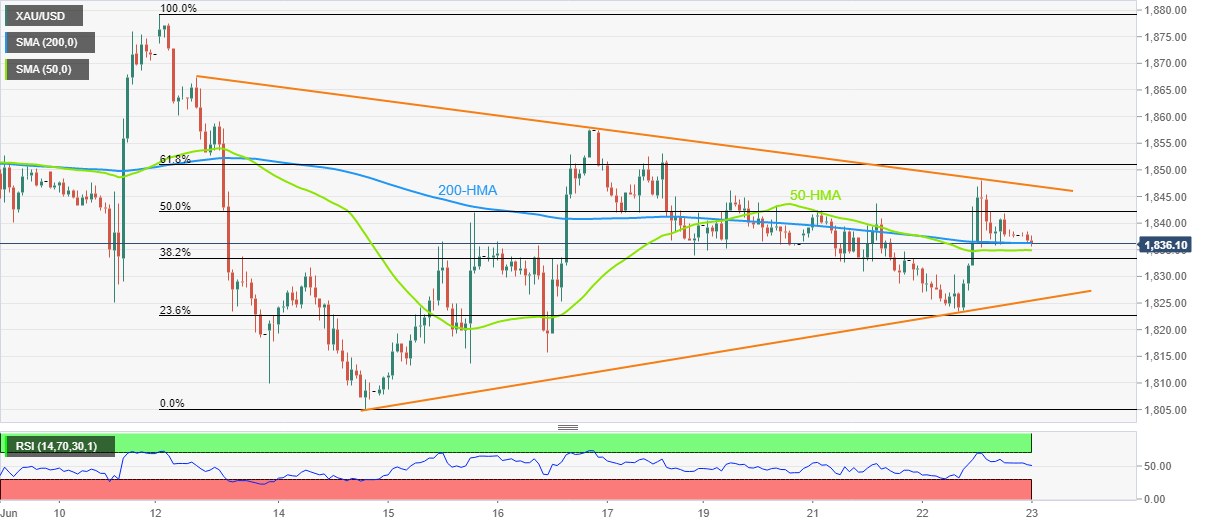
Trend: Further weakness expected
The European Central Bank (ECB) will raise its deposit rate above zero for the first time in a decade in September, according to most economists polled by Reuters. The survey also portrays expectations of a rate hike at least 50 basis points higher than previously anticipated by year-end.
Key findings
The June 15-22 poll showed all but two of the 55 economists expected the ECB to deliver a quarter-point raise on July 21 to -0.25%.
Two expected it to hike by 50 basis points, compared to none in the last poll.
A strong majority of 91% or 50 of 55 economists expected the Bank to hike its policy rate by 50 basis points in September, taking the deposit rate out of negative territory to 0.25%.
Last month forecasters were expecting the ECB to wait until the fourth quarter to bring the deposit rate, currently -0.50%, to positive territory.
About 60% or 33 of 55 economists saw another 25 basis point hike in October and about 85% or 47 of 55 expected the same rise in December, bringing the deposit rate to 0.75% by end-year.
But some forecasts for where it would be by end-December were as high as 1.25%, underscoring the possibility of bigger moves.
The poll predicted 25 basis point hikes in the first, second and third quarters next year, pushing the deposit rate to 1.50%, within the terminal rate range of 1.25%-1.50%.
The economy was expected to grow 2.6% on average during 2022 and then expand 1.8% next year, median forecasts of about 70 economists showed.
Over 70% or 25 of 34 economists said in response to an extra question that eurozone inflation was yet to peak. Twenty said it would happen in the third quarter, four said this quarter and one said in the fourth quarter.
Also read: EUR/USD Price Analysis: Bulls flex muscles on the way to 1.0610 hurdle
- EUR/USD eases back from the 1.06 mile stone and overnight highs.
- US Fed Chair Powell testified to Congress and emphasised the Fed’s determination to bring inflation back to target (2.0%).
At 1.0570, EUR/USD is flat on the day with the market giving back a little ground that was made overnight in the absence of a bid in the US dollar and a bias towards the euro.
The European Central Bank's monetary policy committee meets next on July 21 when it is expected to begin its tightening cycle and the euro looked cheaper on the back of a less hawkish outcome from Wednesday's testimony from the Federal Reserve's chairman.
The greenback slipped up as US Treasury yields slid on worries that the US economy could slide into recession. Fed Chair, Jerome Powell said at a hearing of the US Senate Banking Committee that higher rates are painful but are the means the US central bank has to slow inflation.
Powell said that the Fed is not trying to engineer a recession to heel inflation but is fully committed to bringing prices under control. He was adamant that this was more important that the risks of an economic downturn.
During his testimony in the Senate on Wednesday, Powell made no mention of the size of future hikes, but he did admit that the Fed had failed to do its job and that it would be difficult to engineer a soft landing. ''The Fed will not take any rate action off the table and will do what it needs to do, Powell said. Powell noted that the magnitude of future rate rises will depend on the incoming data and outlook for the economy. He said achieving a soft landing will be difficult, but it remains their expectation,'' analysts at ANZ Bank said,
Meanwhile, the US 10-year yield dropped like a stone by 14.7 basis points to 3.16%, extending a decline from 3.49% last week that followed the move by the Fed when the central bank lifted its target rate range by the most in three decades in a 75 basis points hike.
The US dollar index, DXY, fell 0.31% off the bat, with the single currency up 0.47% at 1.0574 before climaxing around 1.06 the figure. The high of the day was 1.0605.
Nevertheless, stocks on Wall Street turned lower in volatile trade as investors weighed Federal Reserve Chair Jerome Powell's commentary. The Dow Jones Industrial Average lost 0.2% to 30,483.13, the S&P 500 was 0.1% worse off at 3,759.89, and the Nasdaq Composite was losing some 0.2% to 11,053.08.
- US Dollar Index prints a four-day downtrend as buyers fail to praise Fed’s Powell.
- Powell’s reluctance for aggressive rate hikes join recently softer oil prices, downbeat US data to favor DXY bears.
- Testimony 2.0, preliminary readings for June’s US PMI will be eyed for fresh impulse.
US Dollar Index (DXY) fades bounce off weekly low as sellers flirt with 104.20 during Thursday’s Asian session. In doing so, the greenback’s gauge versus the six major currencies drops for the fourth consecutive day as traders await the first readings of the US S&P Global PMIs for June.
Federal Reserve (Fed) Chairman Jerome Powell’s justification for the recent rate hike, the biggest since 1994, managed to gain acceptance, at least during the first round of the Testimony on the bi-annual Monetary Policy Report. However, Powell’s rejection of the need for a heavy rate increase seemed to exert downside pressure on the greenback afterward.
Elsewhere, a reduction in the oil prices and recently downbeat US data could also be linked to the DXY’s latest weakness. That said, WTI crude oil prices dropped 0.85% to $103.50, down for the second consecutive day around the lowest levels in six weeks. The black gold’s latest weakness could be linked to the bearish weekly inventory data from the American Petroleum Institute (API). As per the API Weekly Crude Oil Stock for the period ended on Jun 17, stockpiles rose 5.607 million barrels versus an increase of 0.736 million barrels the previous week. Additionally, talks that US President Joe Biden will announce gas tax relief by the end of the week also weighed on the oil prices.
It should be noted that the latest US figures concerning housing and activities have been softer for May, which in turn eases the pressure on the Fed to tame inflation. Earlier in the day, Reuters said, “An early look at the state of the US job market in June from payroll provider UKG suggests some strengthening, even as the Federal Reserve lifts interest rates sharply and economists raise alarms over the likelihood of a recession.
Against this backdrop, Wall Street managed to pare the day-start losses but ended Wednesday with mild losses whereas the US 10-year Treasury yields marked the biggest daily fall in a week by ending the day at around 3.16%, down two basis points near 3.14% by the press time. That said, the S&P 500 Futures drop 0.50% at the latest.
Having witnessed the initial reaction to Fed Chair Powell’s testimony, DXY watchers await the US S&P Global PMIs for June and the weekly Jobless Claims data. Also important will be the second round of Fed Chair Jerome Powell’s Testimony. Should Fed’s Powell keep rejecting the monetary policy aggression, the US Dollar Index will have a further downside to track.
Technical analysis
A clear downside break of a fortnight-old ascending trend line directs DXY towards the previous week’s low near 103.40.
| Index | Change, points | Closed | Change, % |
|---|---|---|---|
| NIKKEI 225 | -96.76 | 26149.55 | -0.37 |
| Hang Seng | -551.25 | 21008.34 | -2.56 |
| KOSPI | -66.12 | 2342.81 | -2.74 |
| ASX 200 | -15.3 | 6508.5 | -0.23 |
| FTSE 100 | -62.88 | 7089.22 | -0.88 |
| DAX | -148.12 | 13144.28 | -1.11 |
| CAC 40 | -48.03 | 5916.63 | -0.81 |
| Dow Jones | -47.12 | 30483.13 | -0.15 |
| S&P 500 | -4.9 | 3759.89 | -0.13 |
| NASDAQ Composite | -16.22 | 11053.08 | -0.15 |
- GBP/JPY has picked bids around 166.50 despite lower expectations for the UK PMI.
- Japan's inflation rate is seen at 2.9% while the core CPI may slip to 0.4%.
- UK’s Inflation at 9.1% is compelling the BOE to announce a jumbo rate hike in July.
The GBP/JPY pair was portraying selling pressure in the early trade. The cross moved gradually lower in the initial hour and later extended its losses to near 166.45, however, some recovery has been witnessed. On a broader note, the asset is rock solid on the continuation of the ultra-loose monetary policy by the Bank of Japan (BOJ).
The June meeting minutes from the BOJ released on Wednesday dictated that the majority of the BOJ policymakers are in favor of sticking to a prudent monetary policy and injecting liquidity into the economy to support the aggregate demand. A weak yen is beneficial for increasing exports.
Although the annual inflation rate has comfortably crossed the target rate of 2%, the price pressures are mostly contaminated by healthy food and fossil fuel prices. Therefore, considering a hawkish tone on policy rates won’t be an optimal decision. Going forward, the release of the Japanese inflation will keep investors busy. As per the market consensus, the annual Japanese inflation rate is seen at 2.9%, higher than the prior print of 2.5%. While the core Consumer Price Index (CPI) may be half to 0.4%.
On the pound front, a higher inflation rate at 9.1% released on Wednesday has bolstered the odds of a 50 basis point (bps) interest rate hike by the Bank of England (BOE) in its July monetary policy. The UK economy is displaying the highest price rise rate than the other Western leaders.
In today’s session, the focus will remain on the Purchase Managers Index (PMI) figures. Japan’s Manufacturing PMI is seen at 54.4 vs. 53.3 recorded earlier. While the Services PMI may slip to 52.2 from the former figure of 52.6.
The UK’s Manufacturing PMI is seen lower at 53.7 from the prior print of 54.6. And, the Services PMI will slip to 53 vs. 53.4 prior.
- WTI remains pressured around multi-day low, down for the second consecutive day.
- Concerns surrounding Biden’s gas tax relief, recession fears join downbeat API data to favor bears.
- Preliminary US PMIs for June, EIA inventories eyed for fresh clues.
WTI crude oil prices fade bounce off intraday low, retreating towards the $103.00 during Thursday’s Asian session. In doing so, the black gold drops for the second consecutive day after poking the lowest levels in six weeks the previous day.
The energy benchmark’s latest weakness could be linked to the bearish weekly inventory data from the American Petroleum Institute (API), as well as US President Joe Biden’s push for gas tax relief and recession fears.
As per the API Weekly Crude Oil Stock for the period ended on Jun 17, stockpiles rose 5.607 million barrels versus an increase of 0.736 million barrels the previous week.
Talks that US President Biden will announce gas tax relief by the end of the week weighed on the oil prices as energy producers are already struggling with the higher supplies and fears of a slowdown in the demand due to the recession woes, especially from China.
It’s worth noting that the covid and geopolitical concerns have already rang an alarm for the economic slowdown and challenged the black gold prices earlier. Also drowning the energy prices are the recently hawkish central bankers.
That said, the market’s risk-off mood exerts additional downside pressure on the oil prices. While portraying the mood, Wall Street managed to pare the day-start losses but ended Wednesday with mild losses whereas the US 10-year Treasury yields marked the biggest daily fall in a week by ending the day at around 3.16%. That said, the S&P 500 Futures drop 0.50% by the press time.
Moving on, the official weekly oil inventory data from the Energy Information Administration (EIA), 1.956 M prior, will direct short-term oil prices. Additionally, the US S&P Global PMIs for June and the second round of Fed Chair Jerome Powell’s Testimony will also be important to watch for fresh directions.
Technical analysis
A daily closing below the yearly support line, now resistance around $106.85, directs WTI crude oil prices towards May’s low near $97.20.
| Pare | Closed | Change, % |
|---|---|---|
| AUDUSD | 0.6924 | -0.64 |
| EURJPY | 143.812 | -0.13 |
| EURUSD | 1.05641 | 0.28 |
| GBPJPY | 166.92 | -0.52 |
| GBPUSD | 1.2262 | -0.11 |
| NZDUSD | 0.62833 | -0.75 |
| USDCAD | 1.29484 | 0.22 |
| USDCHF | 0.96109 | -0.48 |
| USDJPY | 136.138 | -0.4 |
© 2000-2025. Bản quyền Teletrade.
Trang web này được quản lý bởi Teletrade D.J. LLC 2351 LLC 2022 (Euro House, Richmond Hill Road, Kingstown, VC0100, St. Vincent and the Grenadines).
Thông tin trên trang web không phải là cơ sở để đưa ra quyết định đầu tư và chỉ được cung cấp cho mục đích làm quen.
Giao dịch trên thị trường tài chính (đặc biệt là giao dịch sử dụng các công cụ biên) mở ra những cơ hội lớn và tạo điều kiện cho các nhà đầu tư sẵn sàng mạo hiểm để thu lợi nhuận, tuy nhiên nó mang trong mình nguy cơ rủi ro khá cao. Chính vì vậy trước khi tiến hành giao dịch cần phải xem xét mọi mặt vấn đề chấp nhận tiến hành giao dịch cụ thể xét theo quan điểm của nguồn lực tài chính sẵn có và mức độ am hiểu thị trường tài chính.
Sử dụng thông tin: sử dụng toàn bộ hay riêng biệt các dữ liệu trên trang web của công ty TeleTrade như một nguồn cung cấp thông tin nhất định. Việc sử dụng tư liệu từ trang web cần kèm theo liên kết đến trang teletrade.vn. Việc tự động thu thập số liệu cũng như thông tin từ trang web TeleTrade đều không được phép.
Xin vui lòng liên hệ với pr@teletrade.global nếu có câu hỏi.
-637915514363155758.png)















